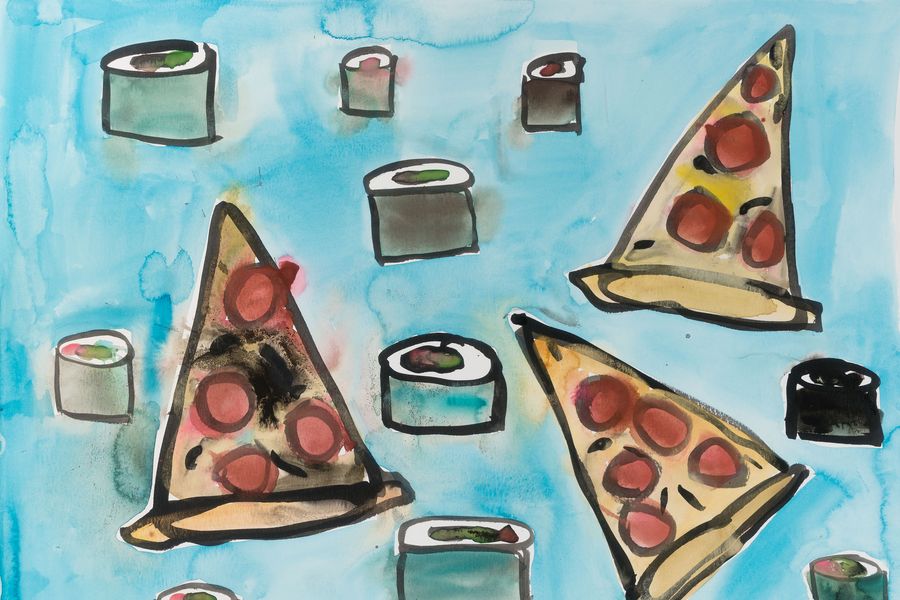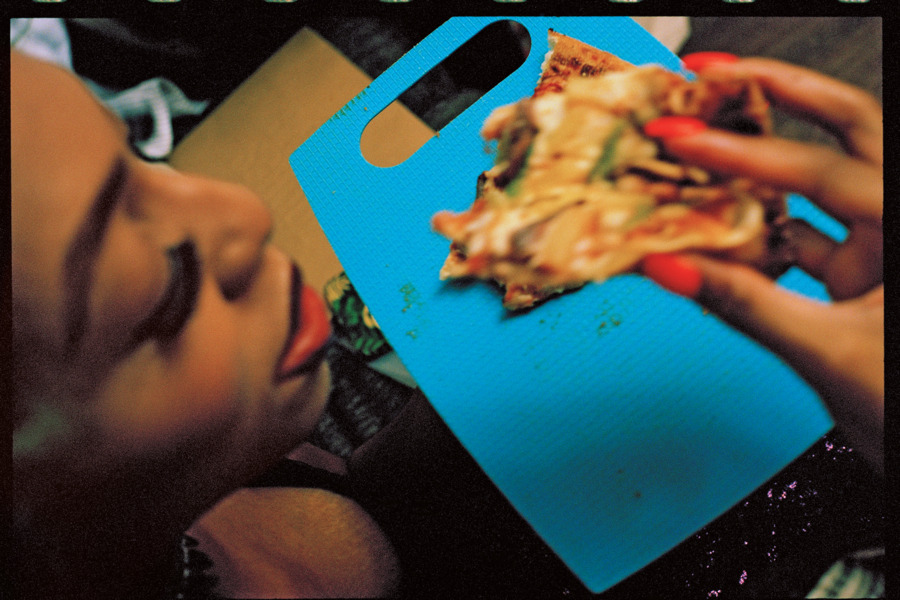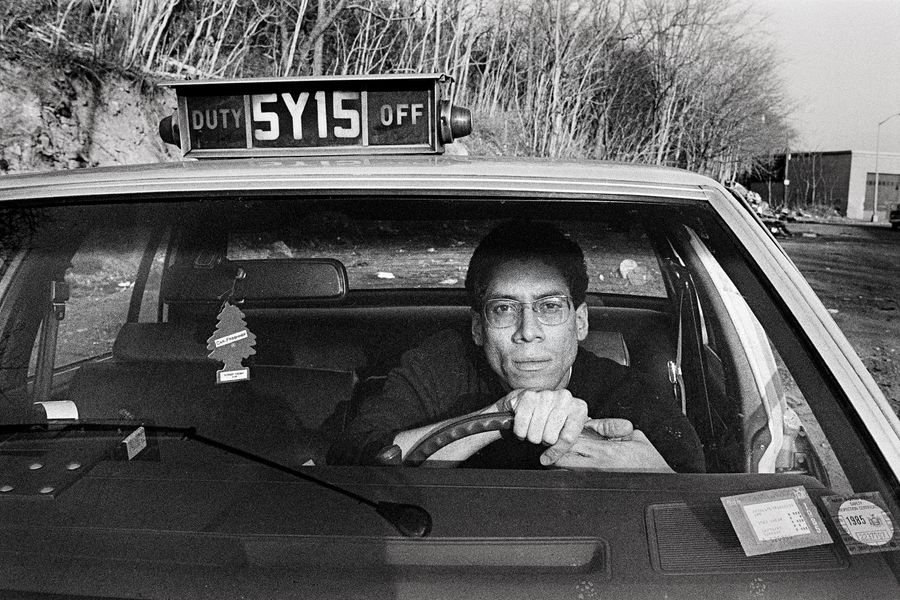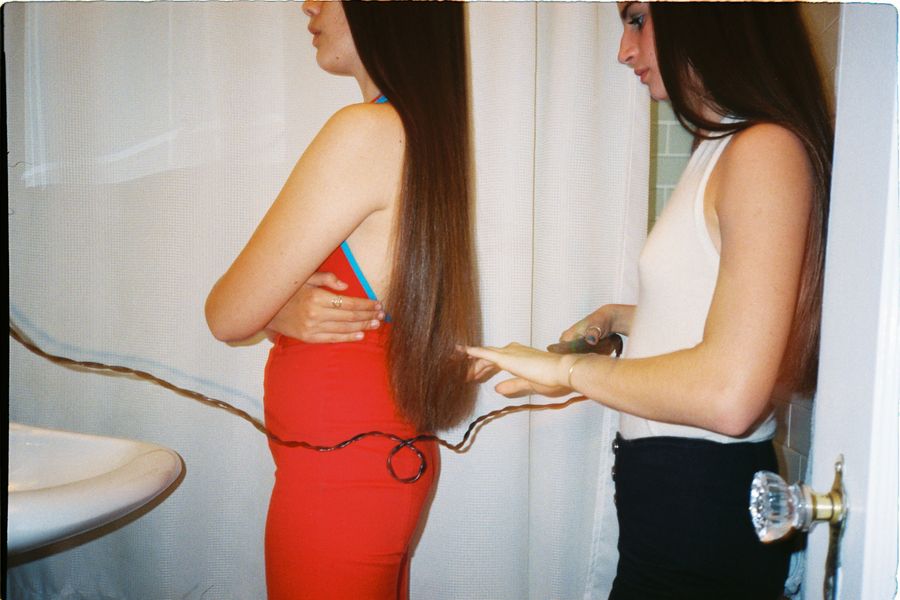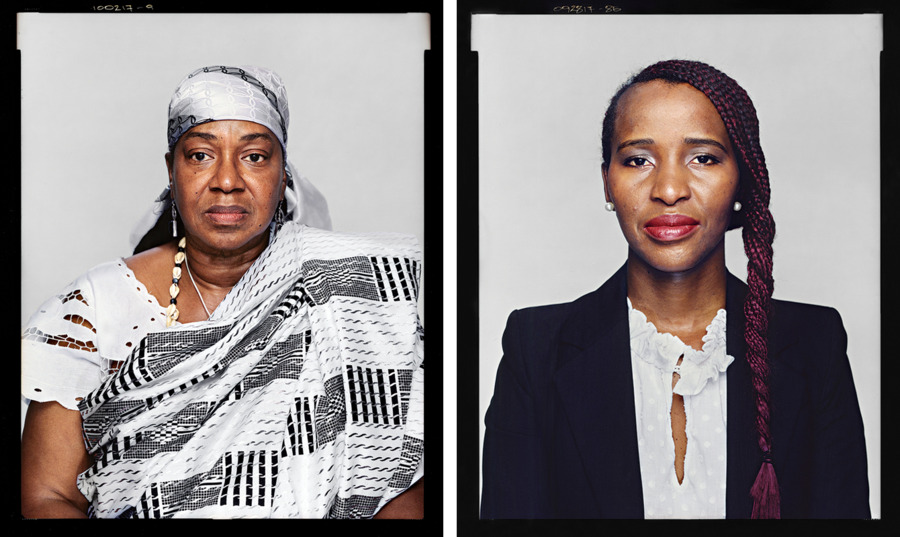Above: Alex Katz’s revisiting of his 1940s “Subway Drawings” for New York. Read more here.
The city is many cities, that’s the beautiful thing. Everyone builds their own New York, mostly out of the people who surround them. But everyone shares the sidewalks, too. And we trade apartments, sometimes finding someone else’s peroxided hair between the floorboards. We fight over cabs (and Citi Bikes) and close elevator doors on one another. Every busy intersection is a kind of rat-king tangle: chance encounters, drag-out fights, families making their way, transactions and missed connections and hustlers of one kind or another pulling scams of one kind or another on rubes of one kind or another. Which means — look around — that we are always, constantly, starring in one another’s city. Guest-starring, at least. The woman behind the deli counter; the man who bumped into you outside, somehow ruining your day. The person from the subway you’ve been madly fantasizing about since. The one who passed the news to the friend of a friend who later got pinched for insider trading. The encounter in the bathroom of the bar, or the two college kids you watched kiss good-bye at Penn Station who came to mind again years later in the middle of the night. The woman at the dog walk you envy for her beauty; the neighbor you hate for having the apartment with the better view. The intimacies overheard on the street, the bodega-line pickup watched over by the manager. Six degrees of separation can feel like a joke. What connection requires more than three? We live on top of one another.
This anniversary issue is devoted to what might make other people in other places go crazy but here we call connection. Not just the connections we choose, like our poker groups or going-out friends, but those that could happen only in a city as clotted and manic as ours. Fifty years ago, New York’s founding editor Clay Felker wrote a mission statement for his new magazine. “We want to attack what is bad in this city and preserve and encourage what is new and good,” he wrote. “We want to be its voice, to capture what this city is about better than anyone else has.” Here, we return to this mission, attempting to capture the city’s voice through stories that are spoken as much as written, almost entirely in the first person, and always about how our disparate lives intertwine. We realize there are still barriers, of course — moats that divide New York into little islands. The city’s schools are the most segregated in the country, and there are those who rarely leave East New York or the Upper East Side. Nor do we live in a paradise of small talk and getting-to-know-you: Sometimes proximity is dreadful. But New Yorkers who spend their lives here, shoulder to shoulder with one another, cultivate an exquisite talent for close-quarters projection — every stuffed subway car a choose-your-own-adventure of imagined new friends and futures, every commute an excuse to daydream alternate lives.
And eavesdrop. In “The Enormous Radio,” John Cheever imagined a New Yorker tuning in to the sounds of those living stacked around her on all sides — above and below, just to the right and just to the left, a cramped apartment-house honeycomb of urban anomie and gossipy self-consciousness. As everyone who lives here knows, the device isn’t necessary: In most buildings, you don’t need a radio to listen in on the neighbors. And even those blessed with especially strong insulation are assaulted with new voices each time out the door. Inscribed by them, really, as you walk these streets; just open your ears and listen.
My Strangers
“I get, like, panic attacks, on the train especially. That’s why I get into the benzos.”
Who’s sitting next to you on the subway? On an R train in September, we asked.
Interviews by Hannah Goldfield
Portfolio by Peter Funch
MY COLLEAGUE
“No other taxi drivers would stop for me.”
TONI MORRISON ON THE SOLUTION TO HER PROBLEM.
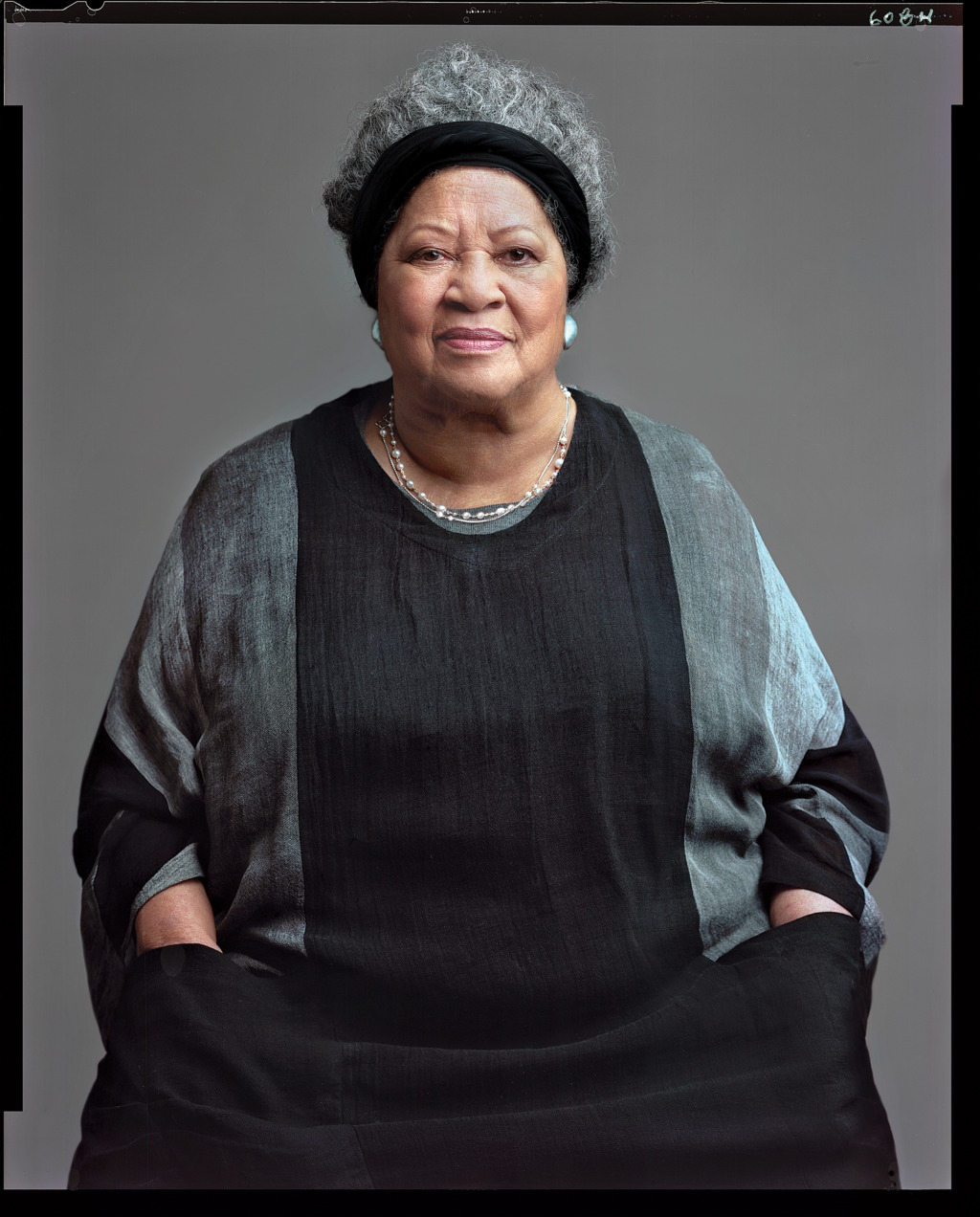
“I moved to New York City to take a really splendid job as an editor in a well-respected publishing house. The work was both familiar and challenging. Familiar because I had been a university professor for six years and accustomed to evaluating essays, term papers, fiction, etc. Challenging because I had never worked in a place where the value of writing was measured in sales.
Except for small irritants, living in a midtown apartment was comfortable. All I had to do was get there — which soon became a major irritant. There were no black cabdrivers then in that part of New York, and no other taxi drivers would stop for me. They traded their quick glances at me for profiles of disdain.
One day after work, Eileen, a young white woman, and I were standing on the street corner outside our office building chatting. Although we worked at the same publishing house, she chose her own schedule — one typical of her highly independent life. Having traveled widely to many off-the-grid countries, worked in a veterans hospital, and lived in Brooklyn, she understood New York life quite well. Which is why, when we were standing together, a cab pulled up to the curb.
I got in. She waved.
Solution obvious.
From then on, every day at the end of our work, she would accompany me to the street corner and wait. Cabs screeched toward us. It never failed.
My One-Handed Neighbor
“Look what happened to me here.” Mary told her to get out of the city.
By Eileen Myles
I moved into my apartment 40 years ago. I had this neighbor, Mary, and she was about to go. I don’t think I got her apartment. I think she was across the hall. I started on the fifth floor and moved down pretty quick to the third but I think she had been up there on the fifth, one day she invited me in. The building faced a forest of ailanthus trees. We called them sumac in Massachusetts and regarded them as junk, what grew behind the dry cleaner’s, etc. But that was New York as it turned out and we had so many of them back there it looked like a jungle. It was pretty wild but I’m mentioning it because the jungle was bright green, filling the windows where she stood. Now I’m sure Mary was on the fifth floor. She was in the back where the trees grew and I was still in the front, facing the street. In my building you wanted a back apartment like she had and that’s where she stood and told me her story, which I’ll never forget.
Mary had a hook instead of a hand. She was a dancer and she said it like she was no longer a dancer. She had gone to do her laundry at the place on 6th Street and First Avenue and by now that laundry is gone. It was very unslick-looking like lots of the businesses seemed then. Like somebody had built this laundromat, nailed wood and painted it. It was something kids made, but they were adults and it was the world, New York, which at the time to me was still a new place. This is in the ’70s, 1977, to be precise. So, as she told her story she shook her hand at me, which was a hook.
Apparently, she had been doing her laundry in that laundromat on First and I think when she stuck her hand in the machine to get out her wet clothes the machine started up again and somehow it cut off her hand. She was very angry about the incident. She was a small woman, she was a dancer she told me more than once, and it was such a performance she was giving me with the bright sun of early summer pouring in through her apartment window and all the sumac shuddering out there. I don’t think she was that much older than me. She was a small woman, white, with medium straight hair. I think the incident had occurred only a couple of years ago. She had been waiting for her court case to get settled and I think it just had. She got a lot of money from the laundromat. She was going to get out of here. I mean of course I am going to leave New York she jeered at me and everything. I was a dancer. I know you think of this as new but this building is bad. You really should get out of here. Look what happened to me here. This building is not a good place. It will fall down around you. You have to get out. She looked completely mad. Things like that happen to people in New York I thought. I’d pass the laundromat daily thinking about what it had done. But it was the building she blamed, not the laundromat. It might happen when I’m not home I thought. Always if I’m out of town I think it might happen then. And then I’m back in my apartment on the third floor, where I went, in my bed, just lying there for 40 years, waiting for it to come true.
My Three Dealers
“Weed is a white guy who calls me ‘homie’ and greets me by saying ‘Sup?’ ”
Cocaine texts in Hebrew.
For cocaine: M. is from Ramallah. Palestinian-Christian. We speak Hebrew together. Sometimes we text in Hebrew. Sometimes he forgets and slips into Arabic, which I don’t understand. Each time he comes by, he drives a different car. Toyotas. Nissans. A Ford Fusion. All of them are new and black with Uber decals on the windshields. Another change brought about by ride-hailing apps is that, whereas M. used to have me sit up front, as if I were his friend, now he has me sit in back, as if I were his paying passenger. I am. He gives me my bags, takes my money, and drops me off around the block. He has a wife and two kids and is saving up to study “how to work with the environment.”
For weed and MDMA: Z. is a white guy who calls me “homie” and greets me by saying “Sup?” He lives in the basement of a house next to the projects. Each time I’ve gone to him, he’s had a different dog. A different pit bull. One time, he had two corgis, which wouldn’t stop barking and wouldn’t stop trying to climb me. He explained, as if by way of apology, that they belonged to his parents, who were away for the summer. “They’re fucking crazy,” he said, and it took me a moment to realize he meant the corgis, not his parents. “Fucking dogs have never been out of Westchester.”
For prescriptions: Dr. T. is a doctor. A real one. He went to real schools. He has an office off Park Avenue. Diplomas on the walls. He doesn’t take appointments. Rather, you just call or text him to check if he’s in. He’ll write you a script for anything. Then he’ll talk about yoga: conflicts with his teachers, crushes on his fellow students. I enjoy the conversations. I enjoy telling him, “You have issues with authority,” and “You should definitely get her number and take her out.” Though I can’t quite shake the feeling, when I’m getting up to leave, that I should be getting my drugs for free in exchange for psychological counseling.
—An unnamed novelist
My Fellow Cadets
“Colonel has no limits on sugar. And he doesn’t have kids, so he doesn’t know what a bedtime is.”
After school, the Upper East Side Knickerbocker Greys practice drills and drink Shirley Temples.
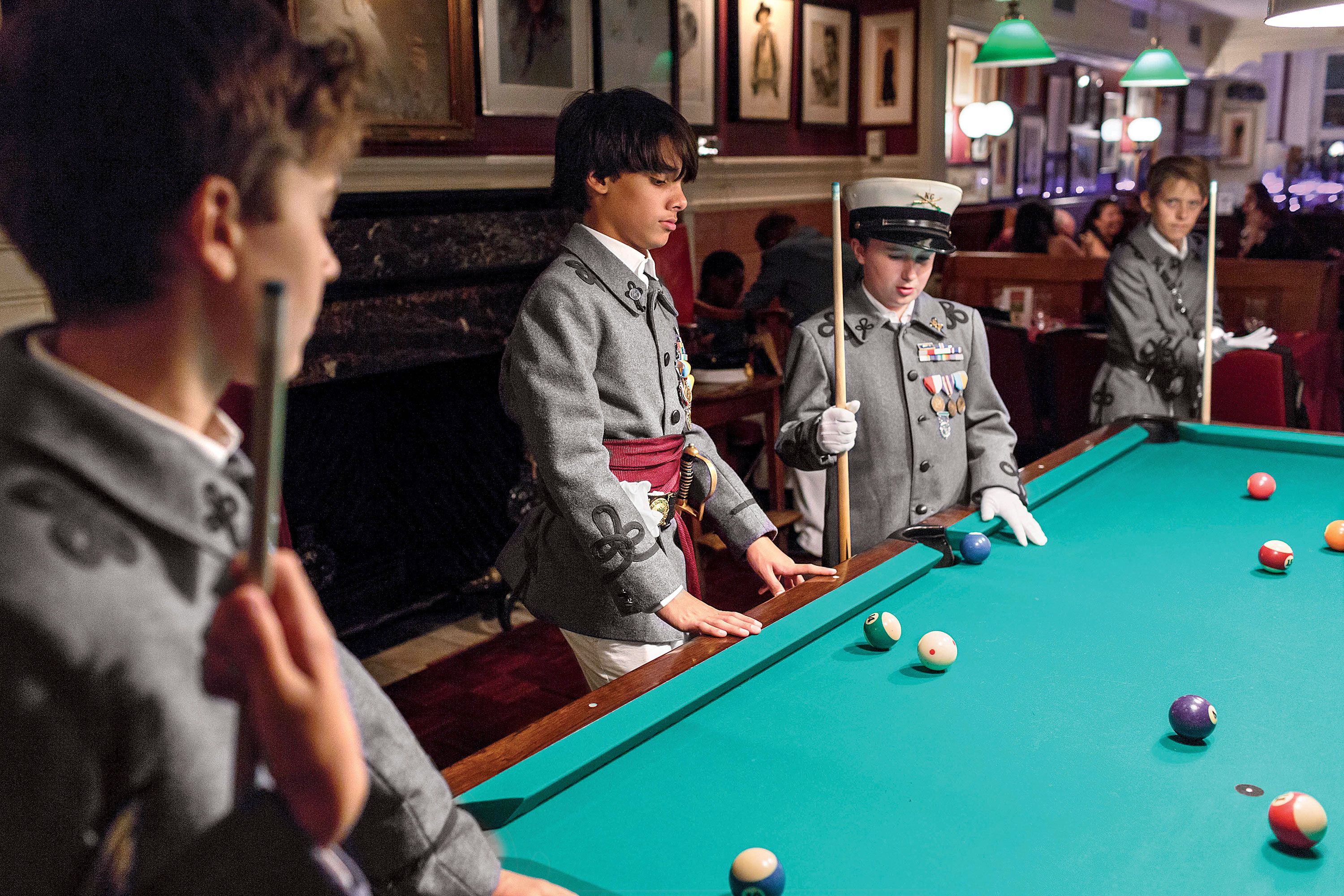
Ben Miller: When we go to the Players Club, we’ll go in uniform, and we drink and eat and play pool.
Michael Kourakos: Shirley Temples.
BM: I personally don’t like them. But a lot of people do.
MK: Too sweet?
BM: Too sweet.
MK: I drink four. Or two.
Garrett Ward: I usually get five or more.
BM: Also, the Players Club is a chance to get away from our parents, and Colonel has no limits on sugar. Well, some limits. He doesn’t have kids, so he doesn’t know what a bedtime is.
Aiden Eyrick: He also lets us go about the pool table as we like. I’m not very good.
GW: I usually just hit the table with my pool stick.
AE: I’m not bad, but Michael’s definitely better.
BM: We talk about what we’re doing in school. Current events, maybe.
AE: And if one of Colonel’s friends or associates comes over, we’ll tell them about our grades. I act in a refined manner. Look them in the eye.
BM: Shake their hand.
AE: Make sure you make a good first impression.
—As told to Katy Schneider
My Dad
“My brother-in-law always says, ‘There are only two stories in the media: Build ’em up, tear ’em down.’ ”
Eliot Spitzer on the father who wouldn’t let him quit.
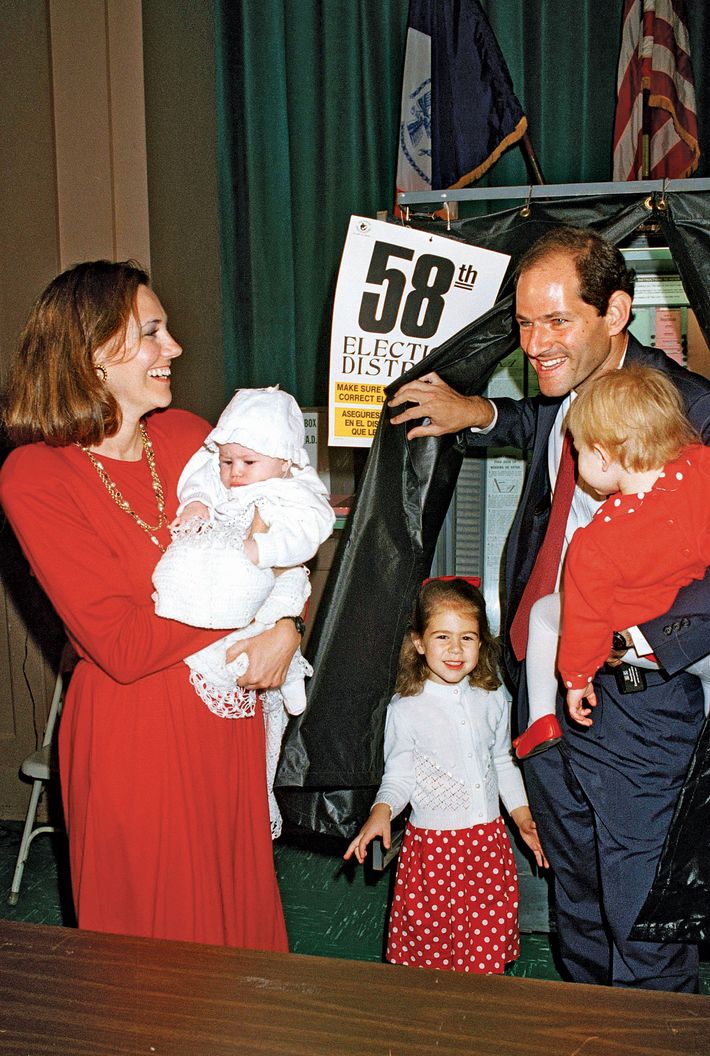
“In 1994, when I decided to run for office, the gut check was really my dad, who knew nothing about politics. He was the shtetl kid who went to CCNY, did well, understood success was a great thing, but “use it for something.” So he was thrilled. After I lost in ’94, he said, “You’re not stopping now. Of course, that’s up to you — you can go back to law, you can come to the family business. But you’ll be bored for the next 30 years. Politics is exciting, dynamic, challenging. Keep at it.”
Oh, sure, I knew I was making some significant enemies as attorney general. Hank Greenberg is still suing me! But you know what? We were right. I wouldn’t change a single thing we said or did about Wall Street. I’ve never criticized them for trying to attack me. That’s their First Amendment right. Now, some of the things they did were more than criticize. Silda always used to say, “It didn’t turn out so well for Don Quixote.” I said, “Ah, the book was too long, I didn’t get to the end.”
I was elected governor with a very significant majority. I wish we had played certain issues differently, not moved as quickly. It cost a lot of political capital. We did quite a fair bit, though. We were right about driver’s licenses for the undocumented. We got a great first budget, and then something switched with Joe Bruno. He was the Republican leader of the State Senate and didn’t want our agenda to succeed. Joe was an impediment.
We would have taken back the State Senate for the Democrats in ’08, and then we would have been able to implement an agenda. We’d actually turned the corner by February of ’08, when my, you know, the other stuff forced me out of office.
Who was hardest on me but stuck by me? Probably my dad, who didn’t want me to resign. His attitude was “In the scheme of life, you have a mission to do. Go out, stand up.” But I still believe I made the right decision, given the politics. I don’t blame the media, because that’s what the media always has been. Its purpose isn’t to elevate us morally. It is to inform, it is to entertain, it is to needle, it is to bring down the powerful. My brother-in-law always says, “There are only two stories in the media: Build ’em up, tear ’em down.” I was treated as fairly as anybody else. Moments of self-pity are wasted time. There were reporters who turned on me, sure. No, I don’t want to name any of them. They’ll find out. That was a joke.
Yeah, other politicians or public figures have reached out to me when they were in trouble. I’m not going to tell you who they are. People call and ask, “How do you make it through?” I tell them, “Sit down and realize it’s gonna get better. Turn off the TV. Don’t look at the headlines. Those pass. I don’t care whether it’s shark bites or kneeling at the national anthem — next Monday, the story will be different. What’s more important is, how are your kids? How’s your spouse? Are you going to keep that together? What are you doing next?” That’s what matters.
It will be ten years in March that I left Albany. How do I make sense of it now? I’m not sure you do. You can’t make sense out of everything. You keep moving forward, you try to do useful things and build a useful life. It doesn’t mean you don’t look back with enormous regret. Enormous regret. But that’s not always a useful way to spend too much time. I give myself five minutes a day. That’s it. Four minutes would be healthier.
I’m a builder now. Most of what my dad built was on the Upper East Side, because that was the heart of the city. Now it’s Brooklyn. We have a site under construction on Kent Avenue in Williamsburg. As a lawyer, as a prosecutor, in politics, there’s a lot of talk. Occasionally things happen. When you’re building, you actually see concrete being poured and curtain wall being applied to the façade. It’s enormously satisfying. I hate to sound like Ayn Rand, but there’s something very rewarding about that tangible productivity.
—As told to Chris Smith
My Fellow Drunks
“ ‘Why did you read that one?’ Norman Mailer asked. ‘I wrote it in a weekend.’ ” How I became good at literary parties.
By Christian Lorentzen
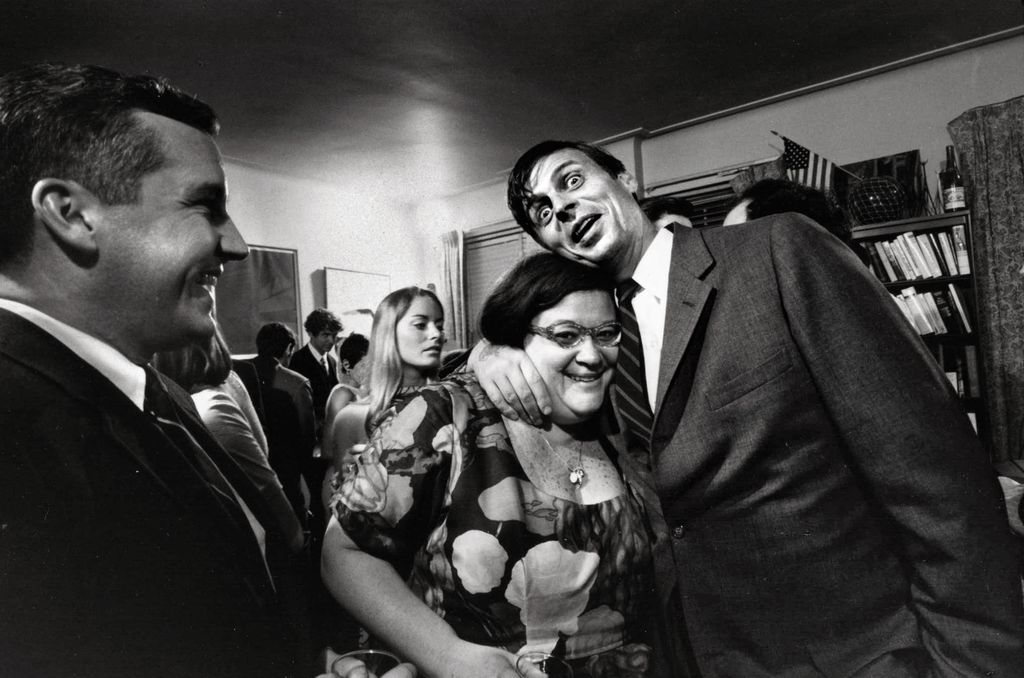
The first time I visited New York after turning 21, it was for a party at George Plimpton’s house. I’d only ever been inside one other Manhattan apartment before. Norman Mailer and Lou Reed were there. My best friend told Mailer he’d just read his novel Tough Guys Don’t Dance. “Why did you read that one?” Mailer asked. “I wrote it in a weekend, for money.” None of my friends had the temerity to talk to Lou Reed.
I found myself engaged in mutual elbowing with a man about my height in the crowd advancing on the bar. It was Plimpton. He got his glass of Dewar’s on the rocks and I my cup of wine. I put my cup on a table, lit a cigarette, and told Plimpton that his book The Curious Case of Sidd Finch — about a pitcher from the Himalayas with a 168-mph fastball — was the first novel I’d ever read. “What are you reading now?” he asked. I was reading Swann’s Way. “Well, then I pointed you in the right direction.” I picked up my drink and took a swig. It was a bitter slosh of cigarette butts and ash. Wrong cup.
Parties are a crucial part of the equation in publishing. The little magazines introduce the talent first, and parties are the way they draw in readers and sell issues, reward the grunts who do the (usually free) labor, and create an aura around their editors. Writers do their work in solitude, but it’s sometimes good for them to get out, too, even when it’s only among kids who will fawn over them. It’s at parties that they play the role of Writer, acquiring allies and rivals. They might even pick up material, an idea, or at least a notion of what not to write. In his notorious memoir Making It, Norman Podhoretz said it was parties and the prospect of talking about their pieces at parties that made writers get their pieces written. After his book came out and all his friends trashed it, he started drinking alone. Then he became a Republican.
Minor humiliations, like vaccines, are important for young writers, and I made it back to Plimpton’s house a couple of times after I moved to New York. It was there that a novelist mentioned he’d noticed a recent long essay about the Albanian novelist Ismail Kadare. I sensed that this was my chance. “I wrote that!” The novelist said nothing and walked away, which I see now was entirely appropriate. My anointment would have to wait.
In those days, I only knew one guy with a cell phone, and he had a mild obsession with Plimpton. He made his way into Plimpton’s study at one party and called himself from the phone to get the number. A few times over the next couple years, he’d call Plimpton in the evening to gauge his interest in sitting on panels he was setting up — events that were entirely fictional. We knew Plimpton’s assistant in those days, and she put a stop to this. “When you called last night, George was on the phone with Muhammad Ali and had to put him on hold for ten minutes!” My friend was bereft when he lost the phone with Plimpton’s number. But it turned out George was in the White Pages.
Open City threw the downtown parties, the cool ones. McSweeney’s was still run out of Brooklyn when I hit town, and I remember lines around the block at Galapagos in Williamsburg for the launch of issue No. 5, the number with the long brilliant story “Mister Squishy,” by Elizabeth Klemm, a one-off pseudonym for David Foster Wallace. A friend of mine got drunk that night and had all the readers sign the Kurt Vonnegut novel he had on him. What’s the market value of a copy of Slaughterhouse-Five signed by Dave Eggers, Sarah Vowell, and John Hodgman? The drunk guy runs a corporate-publishing imprint now.
Once I had a real job as an editor at a magazine with a staff of three, no website, and few readers I knew personally. I spent some of my off-hours helping my friends start n+1. I was a “consultant,” and besides showing them how to make a table of contents, proofreading, finding them designers, and writing movie reviews, I tended bar at their parties. I met all my friends that way. The first time the mag tried to make real money off a party, with rich people there, somebody stole the cash box. There was a rumor it was used to start another magazine. At least that was the hope.
The best friend I made from going to lit parties was Matt Power. He was a journalist and an activist, had lived in a squat in the Bronx and with the Flux Factory collective in Queens, rode a motorcycle, and flew all over to write his pieces. At lit parties, whenever Matt met a fiction writer, he’d mention that he’d dropped out of the Columbia M.F.A. program because he thought true stories were better than what he could make up. I would roll my eyes and interject that style was the only thing that really mattered. Matt always wanted to crash New Yorker parties to meet his globe-trotting heroes, but I thought you shouldn’t go to their parties if you didn’t write for them. Still, we crashed a few. In general, I learned, you should stay away from parties for rich people, because their purpose is donations and having a good time is secondary. Never go to a networking event. Poetry readings are either the best or the worst things. You can skip any book party because they only happen once, they end too soon, and there’s no narrative to them, especially if you’re not there. I’ve only been to one really good one, for Jon-Jon Goulian’s The Man in the Grey Flannel Skirt, at the Wooly. Things got messy, somebody got sick, and I almost got into a fistfight. That was all after Bob Silvers left. The best way to befriend famous people is to have no idea who they are.
Today, Open City is gone, and McSweeney’s is elsewhere. New magazines flare up all the time — Triple Canopy, Gigantic, The New Inquiry, Jacobin, Adult — and transform the landscape, transform what it means to be a magazine. After George Plimpton died in 2003, the offices of The Paris Review moved to a Tribeca loft. Same party, new shape. One night Lorin Stein and I were busted for smoking on the fire escape. A no-no with the neighbors. Lorin is the editor now, and he moved to another loft in Chelsea. An eminence will occasionally appear, Vivian Gornick or Ishmael Reed or Frederick Seidel. I go to see old friends. I’m the little brother of the older crowd now. Matt died of heat stroke on assignment, walking the Nile, in 2014. I still read his stuff. I still miss him at every party.
My Competition
“I had to say the line ‘Agent Willis, look at this funny little finger.’ ”
Six actors auditioning for the same ‘House of Cards’ role (“Father”).
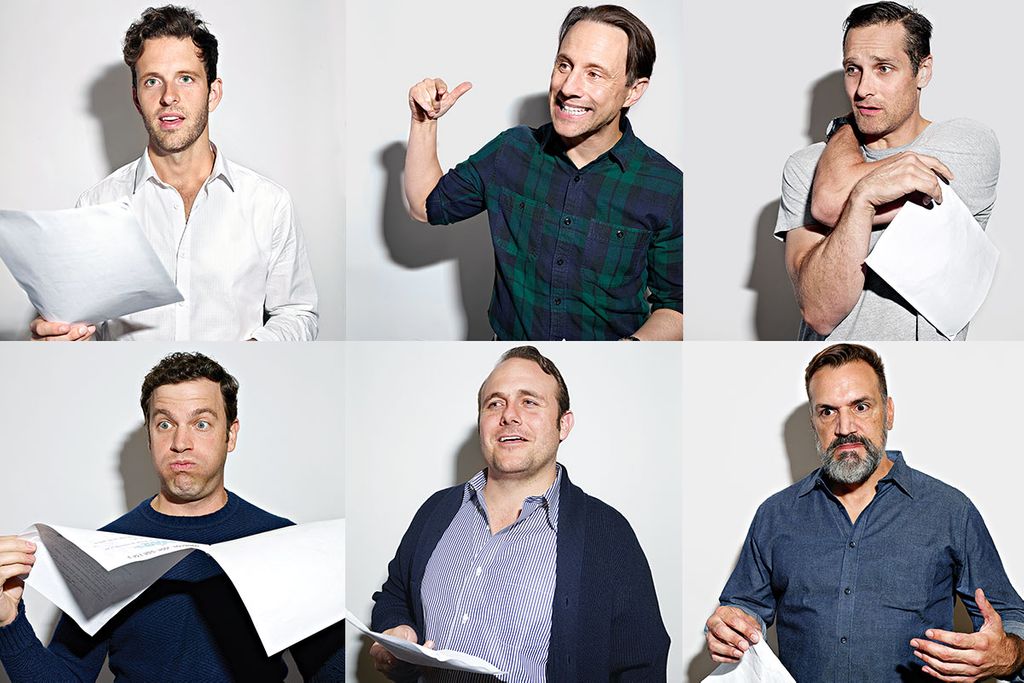
Kevin Isola, 47
“I said the line ‘Agent Willis, look at this funny little finger.’ Kind of a miracle that I got that out with a straight face. In the morning, I took a ‘butter bath,’ which is what it sounds like. Drop in three sticks of butter, a bit of heavy cream, some raisins, lather up; you’re good to go. Makes the skin look great and relaxes the muscles.”
Kohl Sudduth, 43
“On my train ride, I tried to immerse myself in the world of a deeply traumatized man. How would he experience the cacophony of the subway?”
Zack Robidas, 34
“I kept thinking about my pit stains. It was unusually warm for October, and the train was a nightmare. I was rushing around and sweating profusely. I didn’t get cast. I blame the sweat.”
Richard Thieriot, 38
“The only line I remember is ‘Then where are they? Where are they?’ And I only remember it because I was overacting it. Maybe an accent would have helped.”
Joe Carroll, 27
“I’m not sure how much I can give away, but let’s just say there was a scene that really hit hard with something going on in my home state. It was emotional and easy to connect to.”
Matthew Montelongo, 44
“After determining that everyone else in the waiting room was better looking and more talented, I tried my best to tune them out.”
—As told to Trupti Rami
My Salon
“No one is going to barge in on us when we’re unveiled.”
The Yemeni-American friends who get their brows bleached monthly at Le’Jemalik Salon in Bay Ridge.
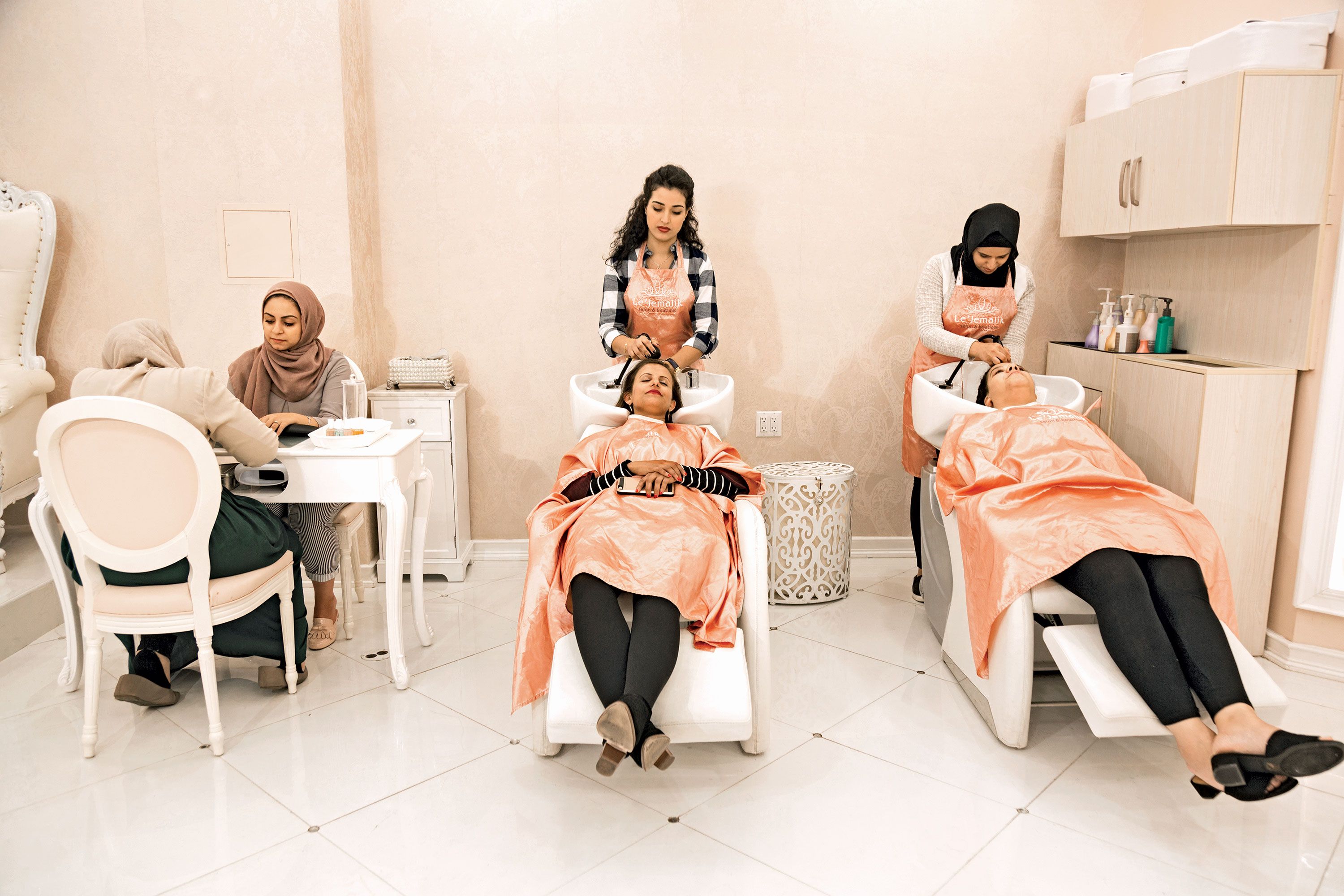
Rabyaah Althaibani: I met Samia during the campaign — we were both working to elect Reverend Khader El-Yateem for City Council. Samia was this amazing, feisty little hijabi woman.
Samia Aljahmi: I got bunions during the campaign from walking so much. It was a very stressful time. But this place is like therapy for us.
Sarah Alsaidi: They have Muslim services: halal brow bleaching for Muslim women who don’t pluck, because in our religion we’re supposed to look natural, like God created us. But we also want our eyebrows to look shaped.
Aljahmi: And there’s privacy. No one is going to barge in on us while we’re unveiled. Anyway, even if I am veiled, I don’t like people seeing me get my upper lip done.
—As told to Katy Schneider
My Crowd
“Woody Allen comes for dinner. The wife comes for lunch.”
On Sunday nights, the regulars order veal Milanese at Sette Mezzo.
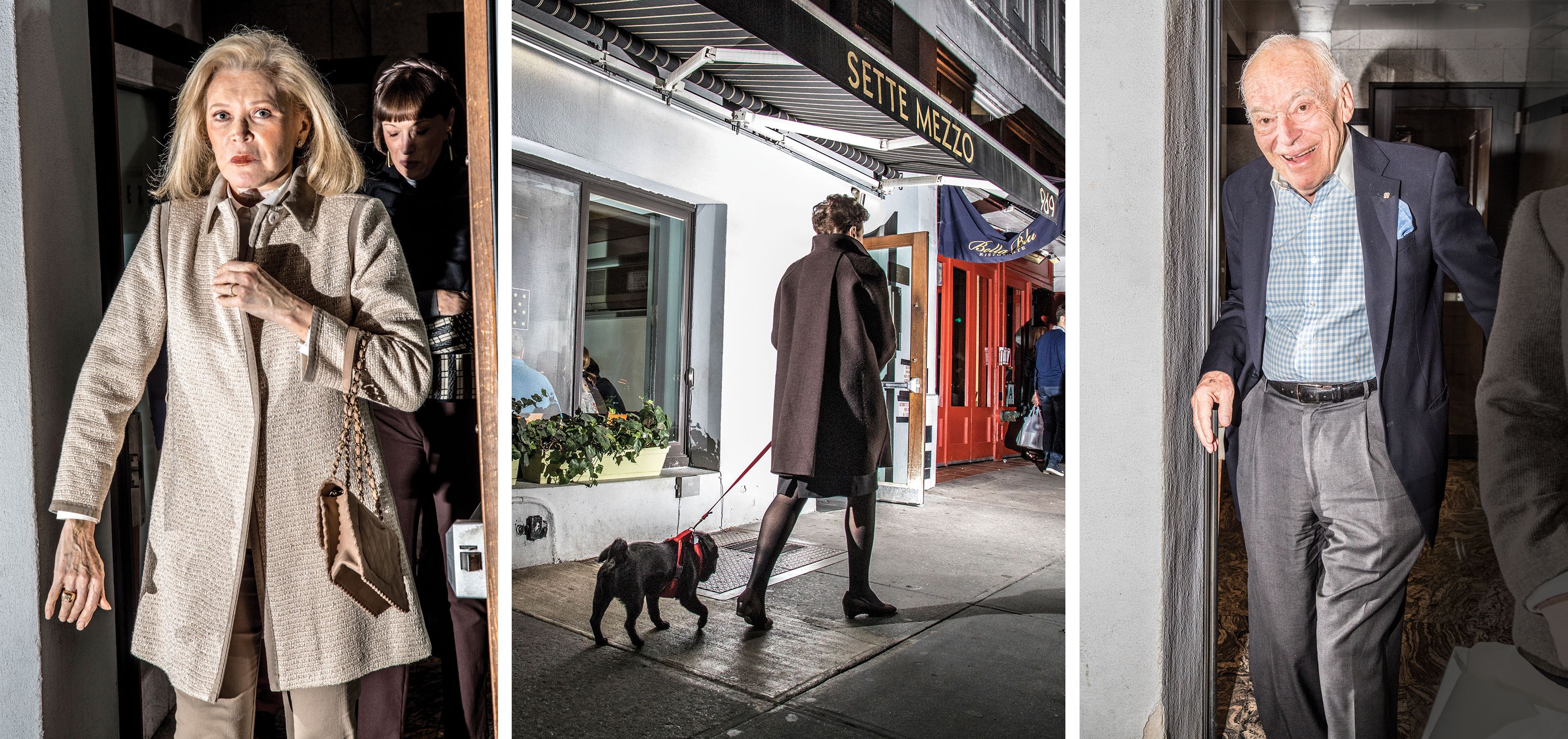
“Co-owner Oriente Mania: Last Sunday, we had Martin Lipton, the Tisch family, the Leon Black family, the Kravitz family, the Steinberg family, the Gristedes, the ex-wife of the former president of France, the Blumenthal family, Larry Leeds, Richard Cohen, Richard Lefkowitz, Bob Jeffrey, the Murdochs, the Lauders. Everyone on Sunday all went to give condolences to the Newhouse family, because they come every Sunday to the same table. Table No. 11, by the window. Woody Allen wasn’t there because he was out of town, but he typically comes for dinner every Sunday. The wife comes for lunch. Joan Didion knows we are really busy Sunday, so she comes during the week with the friend who takes care of her. They order spaghetti with basil and tomatoes and chicken paillard, half an order. Martin Scorsese comes all the time. He orders the veal Milanese, which is fantastic. Al Pacino doesn’t come on Sundays — he comes with Martin Bregman during the week, because he uses a wheelchair, and we already had Si Newhouse with the wheelchair on Sundays.
—As told to Katy Schneider
My Kid
“Nothing Butt Loud Crowded Fun Chicken Korma.”
Children described their city. Their parents made a picture based on those words.
—As told to David Colman
My Tormentor
“I just found her irritating. Conceited! An airhead!”
The issues that surfaced while belly dancing.
By Mary Gaitskill
My experience of envy was the most banal type you can think of, among the most ridiculous and to me initially really confusing. I envied the youth and beauty of a young girl! This is not normal for me. I sometimes envy youth and beauty in a general way, but I don’t often compare myself to specific people, especially not to girls who at this point in my life are in a completely different category.
She was someone I met at a belly-dancing school delightfully called Bellyqueen, which is the kind of intensely multicultural place that is unique to New York City. Some students will plainly go pro, and some already are. Some are performance-addicted amateurs, some are, like me, more casual. Everybody who stays with it does so because they love it, because it is incredibly and deeply fun. I recently told a writer suffering from depression that she should try it, because if you have joy anywhere in you, belly dancing can wake it up. I meant that.
There are many pretty or beautiful girls at Bellyqueen, and most of them I just appreciate. This girl, as I say, was different. I am guessing she was about 20. She was Chinese, tallish, with shoulder-length very black hair and a slender, delicate frame. She did not appear to be an experienced dancer, but she was a natural dancer, radiant and lithe. She had some of the common markers of beauty, as least as I define it: glowing skin; full, finely shaped lips; a soft but sensually heavy jaw; deep-set, heavy-lidded eyes. But what made her irresistible to my gaze was something in the way she moved, a preening exuberance that was sometimes touchingly awkward, as if she were slightly dazed by her own loveliness. Everybody warms up in front of the mirror, but she posed and danced at herself as if she were the only person in the room.
At first, I didn’t even realize that what I felt toward this girl was envy. I just found her irritating. Conceited! An airhead! Mindlessly pleased with herself! Most of the time I didn’t even think words, I just felt that dismissive irritation. I think it took months for me to realize what I was actually feeling, and when I did, that of course made the experience even more irritating — and bewildering. Why, of all the pretty girls at Bellyqueen, of all the drop-dead beautiful girls of my acquaintance in New York, had my psyche chosen this girl to be envious of? Really, I knew that if I looked like she did, I’d dance at myself, too. I also knew that many people would consider her cute rather than actually beautiful. None of that mattered. My irritating envy was like a tiny glass splinter in my foot, the kind of splinter you can only feel when you step a certain way, and which you can’t see to remove.
Then I took a PURE class. PURE stands for Public Urban Ritual Experiment; it is a loose affiliation of artists who aim to promote “community, healing, and social change through dance and music,” a mission that sometimes takes the form of therapeutic workshops, which happen at Bellyqueen with some frequency. These classes (with titles like “Return to Love” or “Reimagining Beauty”) are not strictly belly dance; elements of other dance styles show up, and there is often a therapeutic element — journaling, expressing emotions in movement, revealing all manner of “issues” to a circle of reliably empathetic women. It’s corny, but it’s my kind of corny (yes, I want to “Return to Love”), and so, early on, I decided to try a class. I don’t remember what the class was called, or what it was about, because my memory of it is dominated by the weird fact that she (she needed therapy???) was there, exuding her usual degree of overjoyed self-delight. Most of the dancers there were older (by that I mean 35-plus), and as they introduced themselves to the empathetic circle, they revealed various angers, insecurities, pains, and fears related to self-esteem or “body image.” I thought: If this girl is going to complain about her body issues, my head is going to explode. But when her turn came around she simply and energetically declared, “I am Lu Lu! And I am here to learn about myself!” Inwardly face-palming, I thought, Of course. Of course you are. But I didn’t have time to dwell on it because the instructor was describing the exercises/choreography she had planned and then we were paired up to explore our issues together through dance. Guess who my partner was?
Our first exercise was for each to mirror the other in an improvisational dance. I had never looked Lu Lu directly in the face for any length of time before, and when I did my irritation … evaporated. This was partly because I was busy focusing on what we were doing together; it was also because it was impossible to feel irritated by what I suddenly realized was a quite guileless and tender face. Then came the second exercise, which required us to stand hip to hip, shoulder to shoulder, and put our arms around each other. Almost immediately on touching her I felt something that completely contradicted my idea that she was a shallow, narcissistic twit of whom I was senselessly envious.
To explain: I have an ability that I am guessing many people have, that is, the ability to sense another person through touch. This doesn’t happen every time I touch someone, but when it does, I pay attention. My physical sense of a person may not always be right, it could be shaped by fear or desire or something else. But experience has taught me to trust this tactile understanding, especially when it contradicts what I thought I knew or had assumed. What I felt through touching Lu Lu is hard to describe except that it was wonderful: gentle, truly sweet, somehow sparkling, like a soft landscape at dusk with the fireflies just out. Inner beauty: Yes, I think that is what it was. I don’t remember what we did in terms of movement, only that it felt a little like falling in love, not erotically but emotionally. And that when it was over I took her hand and said what I had probably always wanted to say (for I believe that people always desire to say what they most truly feel): “Lu Lu, you are so beautiful!” And she replied — of course! — “You are beautiful too, Mary!”
When I repeated this exchange to another dancer, she deadpanned: “Yeah. I can just see it.” By which I thought she meant I was making a big deal of nothing or maybe that I’d taken PURE’s message a little too much to heart. Maybe. But if nothing else, I realized what I had actually been envious of: the girl’s undamaged inner beauty, which I believe was the most real thing about her, even if she was perhaps also vain or even shallow. I didn’t become friends with Lu Lu after that or even have a conversation beyond friendly greetings. A 40-year age difference is pretty significant, and I don’t know what we would’ve talked about. But I never felt any irritation with her again, or even real envy. I felt warmth. I still do.
My Rich Clients
“In 1978, I sold the first co-op for $1 million, to the Bolivian tin king.”
A. Laurance Kaiser IV, a real-estate broker, coined the term “triple-mint.”
“I just turned 76, and I’ve been a broker for 51 years. When I started, there were only seven or eight firms, and everybody knew each other. Now everyone is part of a “team,” where one person shows the apartments and another negotiates, like an assembly line. I studied the buildings on Fifth Avenue. I could walk a client from the Sherry-Netherland at 59th Street up to 97th Street and point out building by building: That one has summer work rules; that one, you can’t put in air-conditioning because it will freeze the outside of the building; this building might have an 11-room apartment for sale, but most of the rooms are on an air shaft. I can do the same thing with Park Avenue.
The first apartment I sold was the apartment of the niece of Averell Harriman, at 955 Fifth Avenue. I don’t remember how much the buyer paid, but it was 50 years ago; it couldn’t have been much. In 1978, I sold the first co-op for $1 million at 834 Fifth Avenue, apartment 8B. It was the estate of Jean Flagler Matthews, of the Flagler family from Palm Beach, and the buyer was Antenor Patiño, the Bolivian tin king.
I now represent Susan Gutfreund’s apartment at 834 Fifth, which is the best co-op building in all of New York. I’ve known Susan for over 40 years. The apartment is 12,000 square feet, with 100 feet facing Central Park. It’s the only older building on Fifth where the windows go low to the floor. When you’re at Jayne Wrightsman’s apartment in 820 Fifth, you have to walk to the window to see Central Park. And we just reduced the price to $75 million.
Before the internet, everybody found apartments through the New York Times real-estate section. There were no pictures in the ads back then, and you really had to pick your brain to make it descriptive and interesting. You needed something catchy. I made up the phrase “triple-mint” to describe the condition of an apartment, after the “Doublemint Twins.”
You still need a good broker to steer you into the right co-op and get you through the board. And to vet the buyer to make sure they are legitimate, or the seller will hate you. But today there is no client loyalty. Part of that is because you don’t have to have any credentials to get into a condo. With the younger crowd, you can spend months showing them condos and then they find 75 other things they like on StreetEasy and never call you again. There are plenty of new neighborhoods, too. Some people only want “new.” They only want to decorate, not renovate. They want Lutron lights and high doors. Those tall new buildings in midtown will never have the same cachet as Fifth Avenue. Unless you want to be on the 70th floor.
The other thing that’s changed is that people used to be private about money. They didn’t want everyone to know how much they paid for their home. Today they have a need to advertise how much money they have, and as my father used to say, “A spouting whale gets harpooned.”
—As told to Steven Gaines
My Curator
“Why didn’t you just call me?”
Thelma Golden saw her future.
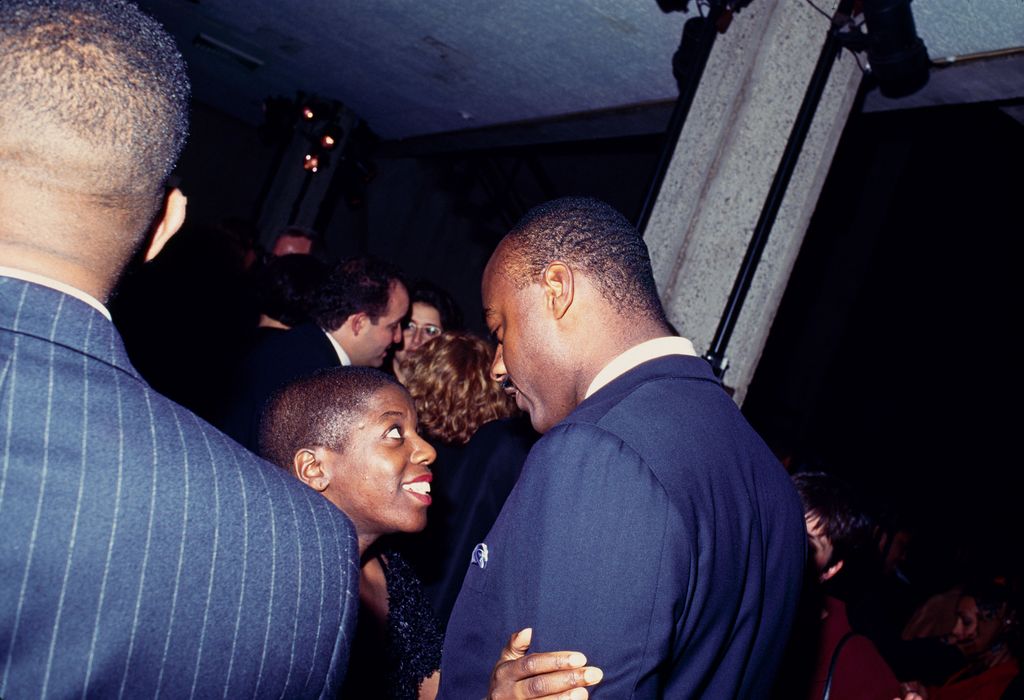
“As a young child in St. Albans, Queens, I read magazines and newspapers, imagining everything that happened in Manhattan as I read about it. And I began to understand many of the people who occupied the city. When I was 12 or 13, I remember reading about a curator at the Metropolitan Museum named Lowery Stokes Sims. I don’t think I had a name for the job curator when I saw her picture; I just knew I loved it when I went on field trips to museums, being in rooms full of art. But I’m not sure I knew who made that possible. But seeing her picture — an African-American woman — gave me such a sense of possibility.
In my junior and senior years in high school, I was in the internship program at the Met. I still think of it as my first job. And I spent every single day hoping I would run into Lowery Stokes Sims. It never happened. When I did meet her, five or so years later, after I was a curatorial fellow at the Studio Museum, the first thing she said was, “Well, why didn’t you just call me?”
—As told to Carl Swanson
My Housemate
“I think the difference is we never felt warehoused.”
Whoopi Goldberg lived in the Chelsea-Elliot Houses, where Maria Cortes now lives.
Portfolio by Jonas Fredwall Karlsson
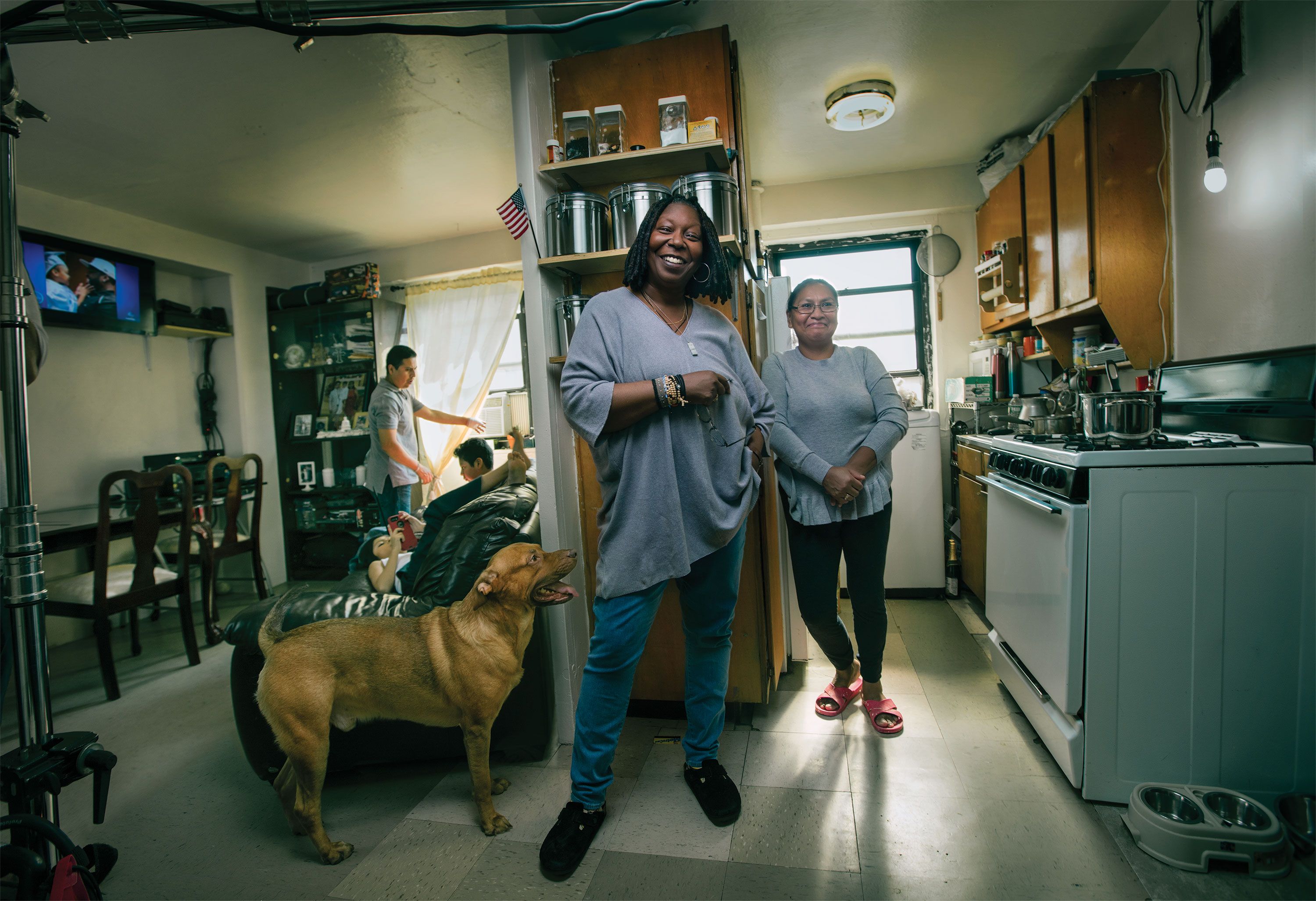
Whoopi Goldberg: I lived there my whole life until I moved to California after I got married. Back then, they were newer projects, or they felt newer. My room was in the back, just a bed and a bureau and windows. When I was a kid, the High Line was still being used to transport things through the city, usually at night. That’s what I looked out on. It’s a great place to grow up, because we were outside 98 percent of the time, winter and summer. We all were poor, and we all knew it, but it somehow didn’t really stop us from doing anything.
Maria Cortes: A neighbor said to me that a lady that is in a television show grew up here and that she became famous and that she took her mom from the projects and bought her a house. I believe the lady next to me knew Whoopi since she was little.
WG: Everybody’s parents looked out for everybody’s kids, so if you were in the stairway making out, your mom would know before you got finished, you know? You couldn’t do shit. And my mom was a Head Start teacher at the Hudson Guild, which was literally downstairs, so I couldn’t screw around a lot.
MC: I was 17 when I left Ecuador. I arrived by chance at this apartment in 2004. I lived through domestic violence, and the police took me out of my old apartment. To be honest, I don’t like it here.
WG: In my day, you weren’t allowed to have air-conditioning, and you couldn’t have animals. I thought how funny it would be to call my brother and say, “Dude, they got dogs now!” We had parakeets. My mother thought, If these kids tell me one more time they want an animal, I’m gonna … So she bought birds, and it was great until they heard we had birds.
I haven’t been back in almost 40 years. It was hard, because I miss my mom and brother, who are no longer with us. I wish the federal government would take better care of the projects. I think the difference is we never felt warehoused, and I think people are warehoused in these buildings. Just because you’re poor doesn’t mean you don’t want the best for your family.
—As told to Jada Yuan. Translation by Daise Bedolla.
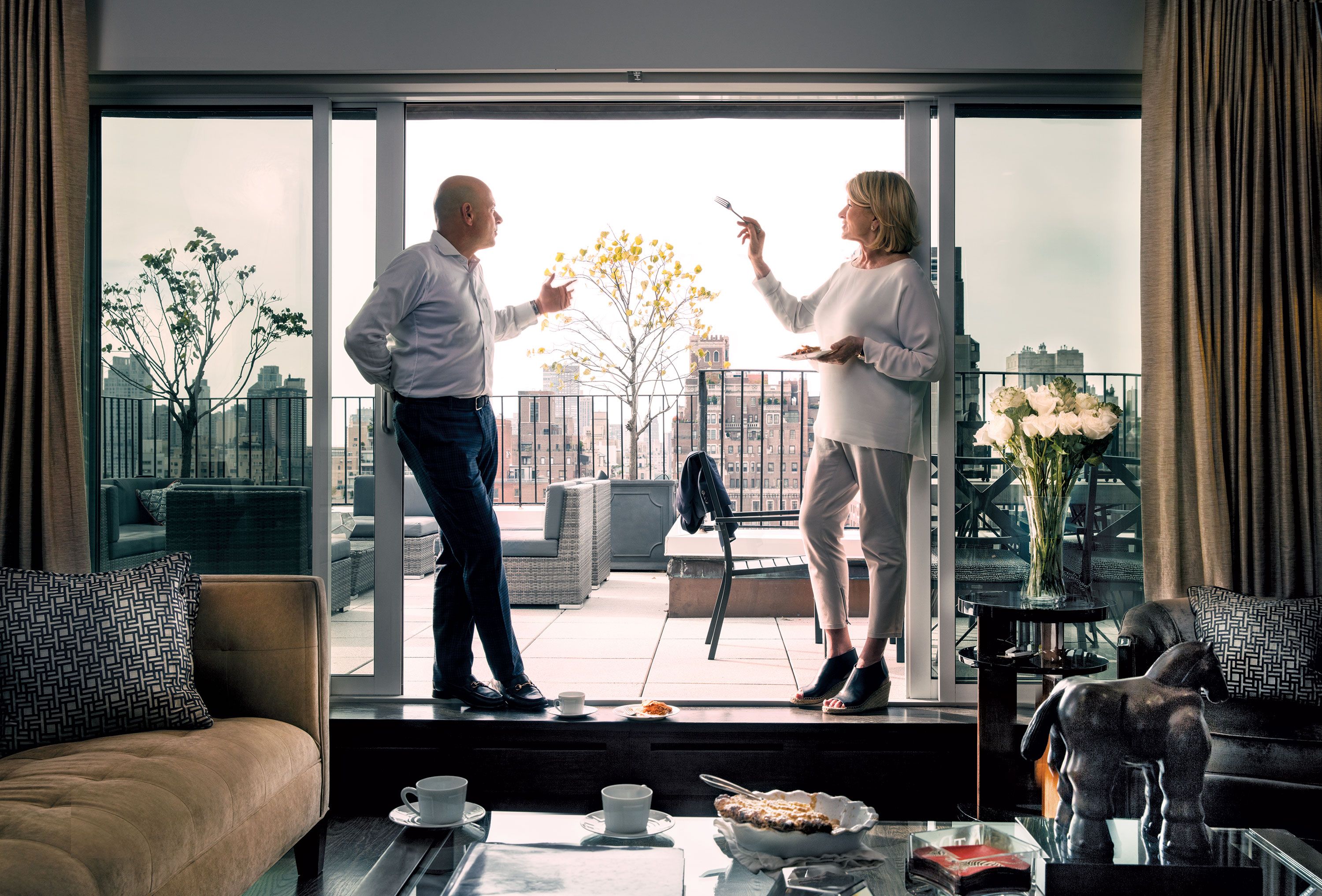
“It’s not my style anymore. I was a little taken aback.”
Martha Stewart visits her old Upper East Side apartment, now inhabited by an ex–Real Househusband.
Martha Stewart: That was my first apartment after getting married. I was 19, a student at Barnard College, and my husband [Andrew Stewart] was at Yale Law School. We had the penthouse, on the 21st floor, for a few months. It was pretty classy for a little girl from Nutley, New Jersey! It was quite extraordinary to be so high, with a wraparound terrace; plus it was built as a luxury East Side co-op. It was owned by one of my husband’s friends’ fathers, who was a honcho at Time, Inc. I think it was $125 a month.
Tom D’Agostino Jr.: I bought the apartment in 2011 and did a full gut renovation that took about two years. Mid-century–slash–Deco décor. Raised the ceiling, changed the terrace around, expanded the footprint of the apartment to make the dining room and the kitchen bigger. Added a second bath.
MS: That apartment was very beautiful and light-filled and airy — and all white, the way it was meant to be. Now it’s much more enclosed and dark! Now it has hedges blocking the views, because the views now look into other buildings. And it’s more masculine-looking. I mean, he’s now a bachelor, isn’t he? It’s not my style anymore. I was a little taken aback.
TD: Martha baked me a beautiful apple pie with apples she had picked on her own farm, so we had coffee and pie together and spent an afternoon talking. She said the apartment was totally different and remarked what a wonderful renovation.
MS: I knew Tom was on The Real Housewives [of New York City]. That’s not my cup of tea, but I know some of the housewives. I think he liked the fact that I brought him an apple pie. He still hasn’t returned my dish, though.
New York: Martha, that’s my fault.
MS: If you could remind someone to give me back my dish, it would be nice. It’s my favorite apple-pie dish.
—J.Y.
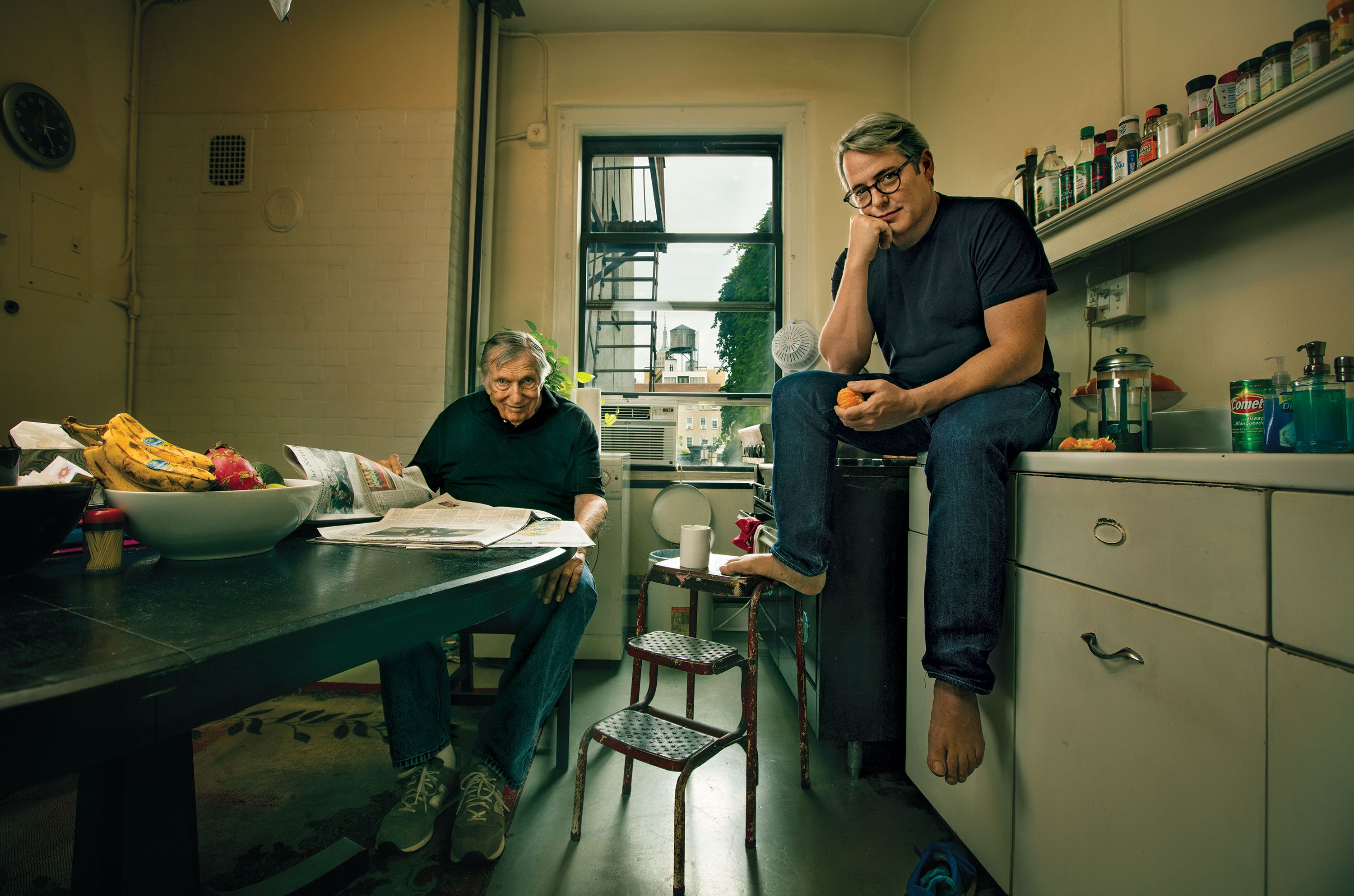
“I think I maybe got a teeny bit of pot in that park once, out of about nine tries.”
Matthew Broderick lived in this Washington Square apartment, where John Wesley lives now.
Matthew Broderick: We moved there from a few blocks away on Fifth Avenue when I was 4. I lived there until I got my first apartment on my own, in my early 20s. The living room faced the park, so it was all trees and no high buildings. So I watched the Twin Towers go up out of the living-room window. Washington Square Park was a very different place. You used to hear bongos basically all day through the windows in that house. You could not walk through the park once you were a teenager without being offered pot … which was actually, I found, not pot very often. Oregano or mattress filling, like sort of foam. I think I maybe got a teeny bit of pot in that park once, out of about nine tries.
My parents got robbed in the apartment once. A man broke in with a knife and made them get their valuables. There were two fires while I was there. One was my friend’s apartment who lived next door to us. The other was on the third floor, below us, where Uta Hagen lived. And I remember that, because my father refused to leave the apartment. He didn’t feel it was going to spread, so he decided to stay. I think there was a ball game on.
After my dad died, my mom lived in that apartment with the artist John Wesley. I hadn’t seen Jack in about ten years, and he was much older than I thought. I’m glad I saw him. He was her beau for the last several years of her life, and then she died and he stayed, which was a very nice thing for the building to let him do, because the rent would be insane now. When my mom died [in 2003], the rent was still around $800 or $900 because of rent control, and it was four bedrooms with a big living room and an eat-in kitchen.
The kitchen is pretty much exactly the same. I remember every screaming fight. I remember Thanksgivings in that kitchen. I had every first there. I had my first girlfriend there, my first play I was paid for. It’s weird that eventually some other family will live in it and that will be that. The house I live in with my family now, it’s from 1870, and I’m like, I wonder what happened in here?
—J.Y.
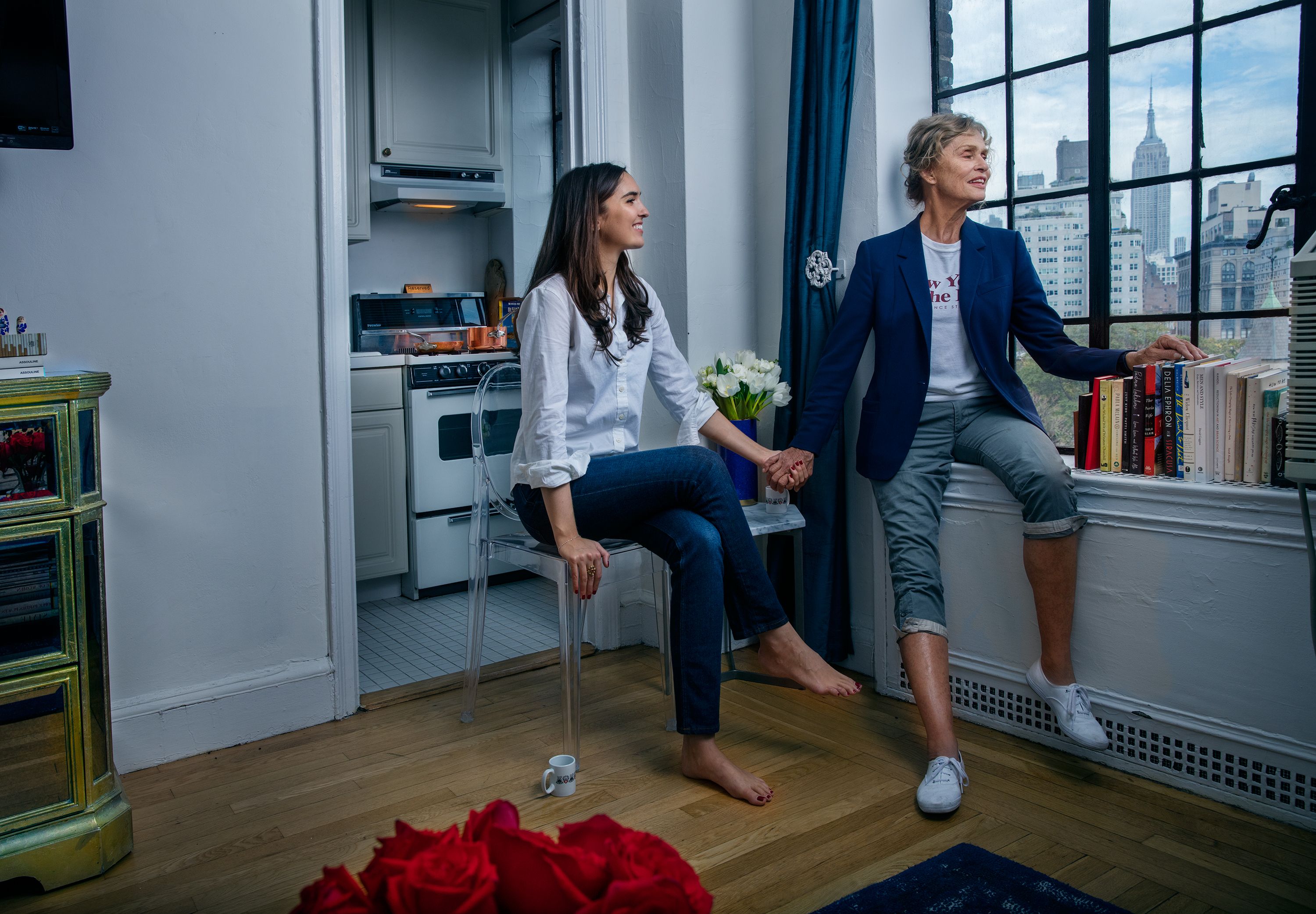
“I would buy six or seven Morton’s chicken pot pies that were 27 cents a pot pie.”
Lauren Hutton meets Lauren Taylor in her old Greenwich Village apartment building.
Lauren Hutton: I was 21, 22, and new to New York, and I wanted to be in the Village so I could see a sky, because I’m a country girl from the South and I couldn’t breathe above 14th Street. So I saw an ad and came down. The first apartment I had was in this building with five girls in a three-room apartment and none spoke to me. I had a small daybed under the window in the living room. I got a table and two chairs because I heard from some new people I’d met that you could go to Park Avenue and pick up furniture from the street. Different chairs from different garbage piles up on Park. Then I got this studio apartment upstairs from my old apartment, with a Murphy bed. I made $50 a week, and I was paying $75.
Lauren Taylor: I wish it was still that price! I grew up in Houston, moved to New York six years ago; I work for Bumble the dating app. This my fourth apartment in the city. It’s a millennial thing. We move around jobs, we move around apartments.
LH: Across the street was a jail.
LT: It was the only women’s jail, I think, in New York.
LH: A woman’s house of detention, they called it. It was mostly people who couldn’t protect themselves and didn’t have lawyers. Their pimps would come by on Saturdays and Sundays. There was a tremendous amount of action. A couple fights you’d see on the sidewalk, but it was amazing.
Another thing that happened around here was there were some brave boys who would wear pink rollers in their long hair. They were called drag queens in those days. But I think it was just brave guys who liked other guys. They were the biggest traffic on Christopher Street, and I would sit in that window a lot and look out and they’d wave up and I’d yell down. It was nice.
Oh, and I lived on pot pies. At the beginning of the week, I would buy six or seven Morton’s chicken pot pies that were 27 cents a pot pie. I could cook. I mean, I knew how to take it out of the freezer and put it in the oven and, boy, I was happy.
LT: Were you modeling then?
LH: I was working at Christian Dior as a house model. They had a modeling room on, I think, 36th and Seventh Avenue, and it was just me and another model who was much older than me. She was almost 30, which is weird. Who knew a 30-year-old woman? And she was always trying to get me to go out with her and her executive boyfriend, who I think was married.
LT: Did you have a first boyfriend here?
LH: The first love of my life, and he had, it turns out, a lot of people who thought he was the love of their life.
—J.Y.
My Boss
“She made those nice New York intellectuals seem like the Sopranos.”
Taking dictation from Diana Trilling.
By Cathy Horyn
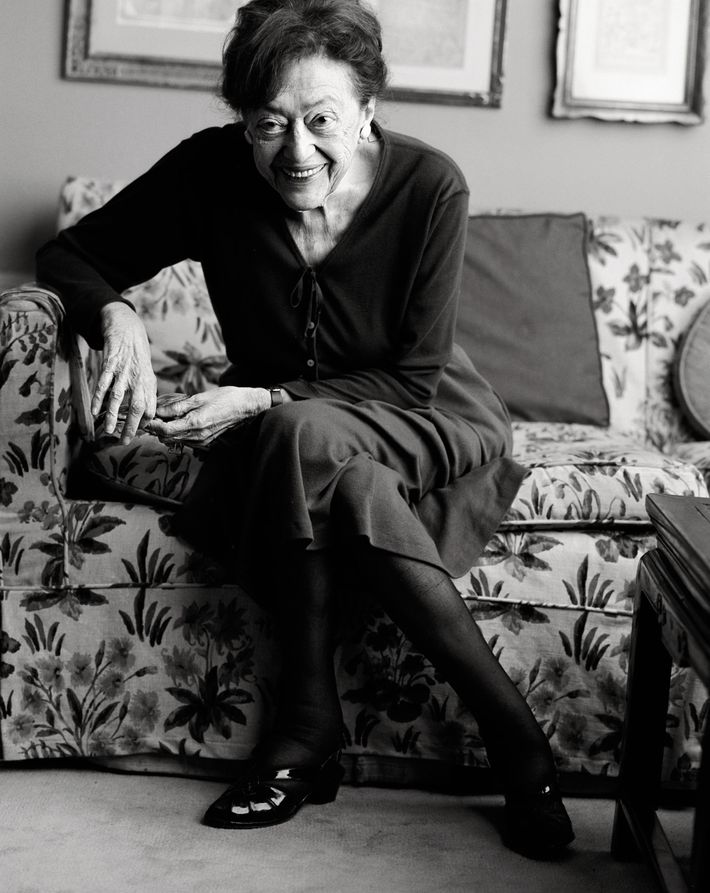
Where do our thoughts go when we are growing up and suppose that we have no further use for them?” Diana Trilling asked at the end of an essay about her experiences at summer camp in the late 1910s and ’20s. “The Girls of Camp Lenore” ran in The New Yorker in 1996, two months before her death. I would be among the mourners at her funeral, 20 years now separating me from the time I worked for her as a secretary, really a girl Friday. I find that I say that line to myself a lot, half in wonder at the mysteries of memory and half in love with the sound of the words — especially whenever my mind reels back to the summer of 1977, when, in addition to Diana, I worked for a woman named Mary Loeb. Mary, 76, had recently gone blind and hired me to read to her on weekends at her apartment on Sutton Place. We began with Lolita.
The two women were as different as two people could possibly be who happened to be born in the same era in the same city. One was an intellectual powerhouse, the widow of Lionel Trilling. Diana was about to have a spectacular second act — on her own — with the publication of Mrs. Harris, her 1981 account of the Scarsdale Diet Doctor murder, followed by a memoir of her marriage. Mary had never needed to work, but through her late husband’s family she became loosely connected to the world of artists and writers. His cousin was Peggy Guggenheim, and his brother, Harold, had founded the literary magazine Broom. I remember her delight at telling me about the time she met F. Scott Fitzgerald at a nightclub in the 1920s. We were sitting up late in her room, her wig removed for the day, a Marlboro burning in an ashtray on her lap, when she recalled being out with her husband and Maxwell Perkins, the editor, and a tipsy Fitzgerald approaching their table, his eyes glued on Mary.
“What did he say?” I asked.
She let out a throaty laugh. “He said, ‘Tell me, Max, who is this beautiful Jewess you are with?’ ”
I can see in hindsight that it was strange for a college junior to be spending so much time with two old ladies, especially when you consider that the city was in the throes of punk that summer. But punk barely entered my consciousness. My father, an advertising executive from Ohio, had sent me off to Barnard with the understanding that he would pay tuition if I covered my expenses, including rent ($130 for my share of a two-bedroom on West 114th Street). I knew no one in the city, and as a transfer student from a small college in Ohio, I’d found it difficult to strike up friendships with girls who’d bonded as freshmen. Yet I was not lonely. On the contrary, I felt intensely at home on the Upper West Side, with its anomalous mix of students and old people whose faces told you they had survived the Holocaust. I loved wandering into the gloom of the West End bar and thinking, Kerouac was here.
The Trilling apartment was on the ground floor of 35 Claremont Avenue, and when I went to be interviewed — or, as she put it, “to see how we will get along” — she greeted me with a smile I would come to know: at once warm and weary. Dressed in dark wool, the sleeves of her outfit pushed to the elbows, she showed me into a large, dim living room, and I took a seat in a wing chair. Then 71, she was totally self-assured, easily the most formidable human I’d ever met. And at that moment I was glad Lionel was dead, because I don’t think I could have faced them both.
Diana had developed tendinitis and wanted to avoid the strain of letter-writing by dictating them. The volume was enormous. The year before, she’d found her picture on the front of the Times, next to her friend Lillian Hellman. It was the literary catfight of the season, though actually the fight was between Diana and Little, Brown, which had canceled publication of her new book of essays when she refused to delete comments critical of Hellman’s Scoundrel Time, also a Little, Brown book. There was still fallout from that episode — Diana had moved the book, We Must March My Darlings, to Harcourt — plus the usual correspondence to friends.
Well, not usual. It was a quiver of names at the heart of American and British cultural criticism. Isaiah Berlin, Jacques Barzun, Norman Mailer, Paul Fussell. Two or three evenings a week, I would sit in the wing chair, scratch down what she dictated, and pray I didn’t miss anything. Then I would walk the two or three blocks to my apartment, past the Chock Full o’ Nuts, and in my room type “Dear Norman” and “Isaiah dear” on her letterhead. The next day, I would take the pages back to her to be proofread and signed. I saved no letters, of course, but they were always remarkably like Diana: unsparing, precisely worded, surprisingly affectionate.
Diana had planned to be an opera singer, until a thyroid condition nixed that. So when she began to write, she told me, her musical training helped. It was important to write not just with your head and heart but also with your ears. Listen to the sound of the words. Another one of her lessons was harder for me to put into practice. It was: Be contentious. Stand your ground. Until I sat in that living room of hers, I’d never imagined that so many people could be mad at one another. She made those nice New York intellectuals seem like the Sopranos. And she was the fiercest of all. No one was let off her moral hook. I once told her that, coming from a small town, I didn’t understand how a person could be so critical and expect to get along. She looked at me like I was a Martian.
I continued to work for Diana until I graduated, in 1978. That summer I moved to Chicago, to begin graduate school in journalism, and in September I received the first of many letters from Diana, typed by a successor.
Cathy dear:
As the summer progressed I fell ever deeper into a slough of despond, to the point where to have answered your letter would have been a long-distanced cruelty. What a yowl I’d have emitted! It was a horrid summer, I hated every minute of it, never stopped scratching and still feel as if my body were encased in a half inch of heavily peppered molasses. This is not intended to be funny, it is for medical use for any doctor with whom you may happen to take up in your adventurous life in Chicago. But if my health hasn’t been improved by my return to the city, surely my spirits have. By the way, my menage à cinq quickly became à trois and ended à me alone. I think I need some references from old employees.
Your j-school (see how quickly I learn) experience sounds absolutely perfect, including the fellow from Fordham. Imagine anyone of his/your age knowing all these things. You must ask him if he would wish to be adopted and I don’t mean by Hellperson. Has term started again? If it has you mustn’t bother to answer this letter, just get right back into your thousand professional words a day. There could not be better training.
I do miss you, think of you often, and send you my best love.
My Cellmate
“Should I call my mom?”
When the elevator stalled, it was just me and him.
The doors close and then the floor drops from beneath us and then it’s back under our feet. He looks at me and I look at him and I say, “Oh my God,” and the floor jolts away and back again and he grabs my arm. I look at the control panel and can’t figure which possibility is the right one — firefighter helmet? Oh. That’s not a button, it’s a light or else just some plastic thingamajig. My companion is saying something quickly. I think it’s a prayer.
“Should I press this one?” I ask the man.
His shoulders raise a little and his head rattles on his neck. He’s telling me he doesn’t know. I press the one that says EMERGENCY CALL and a loud alarm goes off.
“Hello! Are you okay?” There’s a little tinny voice yelling through the grid of holes above the buttons. The man in the elevator nods at me, and I understand that I have become chief, in command in our new, three-foot-square country.
“Yes!” I yell back (the alarm is still screaming).
“Help is on the way!” he yells back.
The man looks me in the eye and says, “Should I call my mom?” This was unexpected. I can see, though, that he wants and needs to call her, and so I say “yes” enthusiastically. After he hangs up, he tells me that his mom is going to try to call the building. I wonder what in the world this woman could possibly achieve, but I feel strangely optimistic, too — if you raised a child who thinks of you the moment an elevator stops, you must have done a few things right, right?
While he’s texting someone who cares about him, I’m telling Twitter and Instagram where I am. I suggest a selfie together, which he agrees to, throwing his arms across his chest and making two V signs before immediately dropping them and pulling a face when I turn the camera away. “I don’t like pictures,” he says. He’s so shy, I think of a rabbit or some other thing that you want to pick up and hug despite knowing it would be cruel because they’d rather be left alone, unhugged. I guess I’m cruel. There are ten selfies in my phone by the end of the night.
A co-worker sees my tweet and asks if I’m okay in there. I say I’m worried about my worried comrade. She replies with screenshots from an anti-anxiety exercise, which I suggest we complete together.
“Okay,” I say. “Name four things you can see.”
“Okay, I see you, the mirror, that wall, and that light — is that four?”
“Yep, what’s next? Okay, name three things you can smell” (I suddenly become very self-aware).
“Are you okay in there?” It’s the voice behind the wall colander again.
“Yes!” I say.
“Who’s in there? What are your names and what floors do you work on?”
I gesture for the man to step up and take his turn on the microphone.
“My name is Matthew Washington and I’m a student at CUNY,” he replies in a voice I suspect is too quiet for the operator to hear over the alarm, but he does. He replies, “And what about the woman?”
“She’s Helen Washington.”
Blushing, I whisper as loudly as I can, “I think he means me, not your mom.”
—Mona Chalabi
My Characters
“She has nothing to give him but her eyes.”
Playwright Mfoniso Udofia on five strangers she saw on the street whom she wants to see onstage.
1. It’s after the school day, and she pauses by the homeless man, on Eighth and 44th, who holds a sign asking something like: “Am I invisible?” She stares at him.
She has nothing to give him but her eyes.
2. He is the Mandé Uber driver from Côte d’Ivoire whose perfect English is accented with a French r and whose linguistic musicality reminds me, somewhat, of my own West African home. I ask him how many languages he knows. He lists: Jula/Dyula, French, English, and pidgin English. I got the sense that his list was not long enough.
3. She wears an Iron Maiden tank top and multicolored Lycra workout pants. One can almost make out the individual bundles of muscle that link her together. Her smile is as built as her body.
4. He is the man conversing with the Open Air. He walks the length of the B train slowly, finding an empty seat all the way at the end. His conversation with the Open Air becomes colorful. An argument breaks out. Then, the Open Air and the Old Man reconcile and laugh, talking until the doors to the train open.
5. We walk to the shop together, catching up. We enter, I sit down, and she begins the five-hour process of braiding my hair. She offers me boiled peanuts as she works. I inquire about her daughter and ask if she is able to visit her family in Togo this year. Some hours later, she takes a break. She kicks off her shoes, washes her feet, lays out her mat, faces east, and prays.
My Sammy
“He didn’t believe I had caused Hillary Clinton to lose the presidency.”
Visiting an old friend has its upsides.
By Lena Dunham
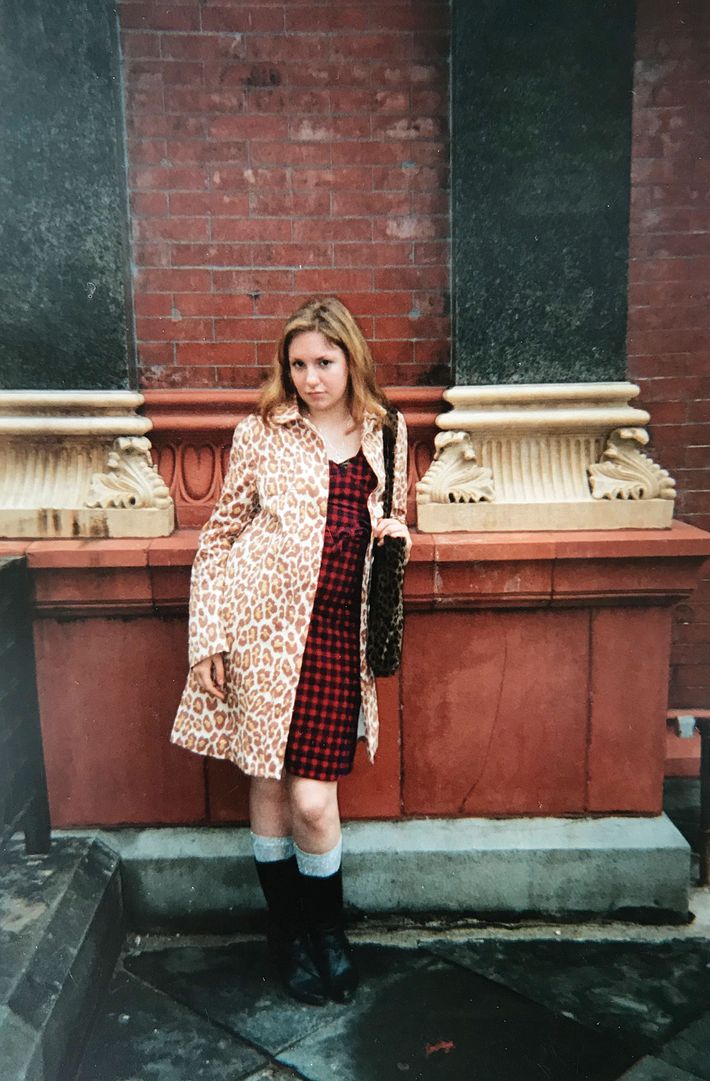
When I was in seventh grade, we moved to Brooklyn and got a dog, two signs of domestication my father had sworn he’d never partake of. Despite having sired two young, clumsy daughters, he was convinced we could remain forever in an industrial building with condemned stairs and no certificate of occupancy, and that the pressure to wash your jeans was a conspiracy by Big Downy. But there we were, on our Sesame Street–perfect block of carriage houses with a terrier who rode in the back of a gray Volvo. “This is fucking humiliating,” my father muttered as he loaded us in for a drive to brunch. Rage, rage against the changing of the boroughs.
But I took to our new neighborhood like Liza Minnelli to a broke gay man — it was as if I’d been waiting my whole life for the chipper sitcom that is Brooklyn Heights.
“Good morning, Mr. Construction Worker Leering at my non-breasts! Pleasure to see you, Old Lady With Substantial Day-Drinking Problem!” I worked part-time at the video store. I had friends at the diner, the dog park, and Talbots, where I’d stop to peruse discount lady’s separates. And I tacked my business cards up in Pet’s Emporium. “EXPERIENCED PET GROOMER,” they said, though experience simply meant a pair of clippers purchased at sale prices and a relentless will not to be bitten. I was too scared to actually use the razor, so I gently trimmed dog bangs. I was never hired twice.
But to build a business, you need a champion, and mine was Sammy, an affable Palestinian man who spent most of the day outside his shop, the aforementioned Pet’s Emporium, greeting the neighbors, giving dating tips to unmarried female customers, and ordering around the sons (four out of his eight) who worked for him in what was actually a stunning parlor floor apartment, though it was far too stuffed with bird seed and hamster wheels for the classic architectural details to matter.
I was quickly fired from the video store (turns out the customer is really, actually, and totally always right, even if it’s about gang-bang porn). I was 70 percent friendless and the market for an untrained 15-year-old dog groomer is niche, so I had a good amount of time on my hands and that time was spent with Sammy.
Sometimes he let me stack and organize product in exchange for a small store credit. Other times I passed out flyers on special deals. Often we just read quietly, what my mom would call parallel play. “My beautiful Lena!” he would cry when I appeared in the doorway, in the least-sleazy singsong a 55-year-old man can direct at a 15-year-old girl.
I really don’t know what my parents thought was going on. “Where’s Lena?” “Oh, she’s spending Saturday at the pet store with her best friend and mentor Sammy, stacking litter boxes in exchange for organic rabbit pellets!” Sammy let me bring my actual rabbit, first name Chester, last name Hadley, who would sit behind the register in a cardboard box chewing on Timothy Hay. Once, Sammy sent me to cut the nails of an elderly blind woman’s cat, and she paid me with a brooch I still have, a fake ruby in a gold-plated filigreed heart. Sammy marveled at it. “What a treasure!”
When it was time to go to college, Sammy and I had an emotional farewell. I promised to be studious, responsible, and kind — and I promised to visit. But I never visited. My parents moved. My obsession with small-animal husbandry faded. I instead became obsessed with what I ate, what I wore, and whom I fucked (or more accurately, who was refusing to fuck me). Eight years later, I moved back to the neighborhood, but I avoided Sammy’s block. Despite certain successes, it was hard to imagine that I had fulfilled Sammy’s order to “be good.” I had HPV, there were whole neighborhoods I was scared to walk through for fear of a yelling match with a tattooed landscaper, and sometimes I went to the bodega at 4 a.m. and ate six to seven packaged croissants then threw them up. I had no pets.
But one day, having turned 31 and celebrated my five-year anniversary with someone I considered to be the embodiment of good, my feet walked me where my mind had refused to go. It was a Sunday. Would the store even be open? Did Sammy still run Pet’s Emporium or would one of his sons stare at me blankly, wondering who this woman with unbrushed hair and daytime pajamas asking for his dad was?
“I don’t know what’s going to happen,” I told my boyfriend as the door creaked open. But there behind the counter was Sammy, in his old spot nestled between the leashes and the dog-breath neutralizers. “My beautiful Lena!” he said without a beat. I grinned. It quickly became apparent that he had no idea what I’d been up to for a dozen years — he hadn’t read about me in “Page Six.” He didn’t believe I had caused Hillary Clinton to lose the presidency. He had not seen my nipples and bush on TV. He was simply happy I’d kept up with this whole being-alive thing. I told him which of our family pets were still living and which one had died after taking a huge shit on my mom’s color printer. I told him I was “a writer, for real now.” I presented my boyfriend like a trophy.
“Look at you!” said Sammy, who had kept a strong business rocking through the financial crisis, the Starbucks-ification of Montague Street, and the challenges of being a human on this earth. No. Look at us.
My Board
“He told me, ‘They really should have attack dogs in the park.’ ”
Three times a year, the members of the Central Park Conservancy Women’s Committee meet at Doubles.
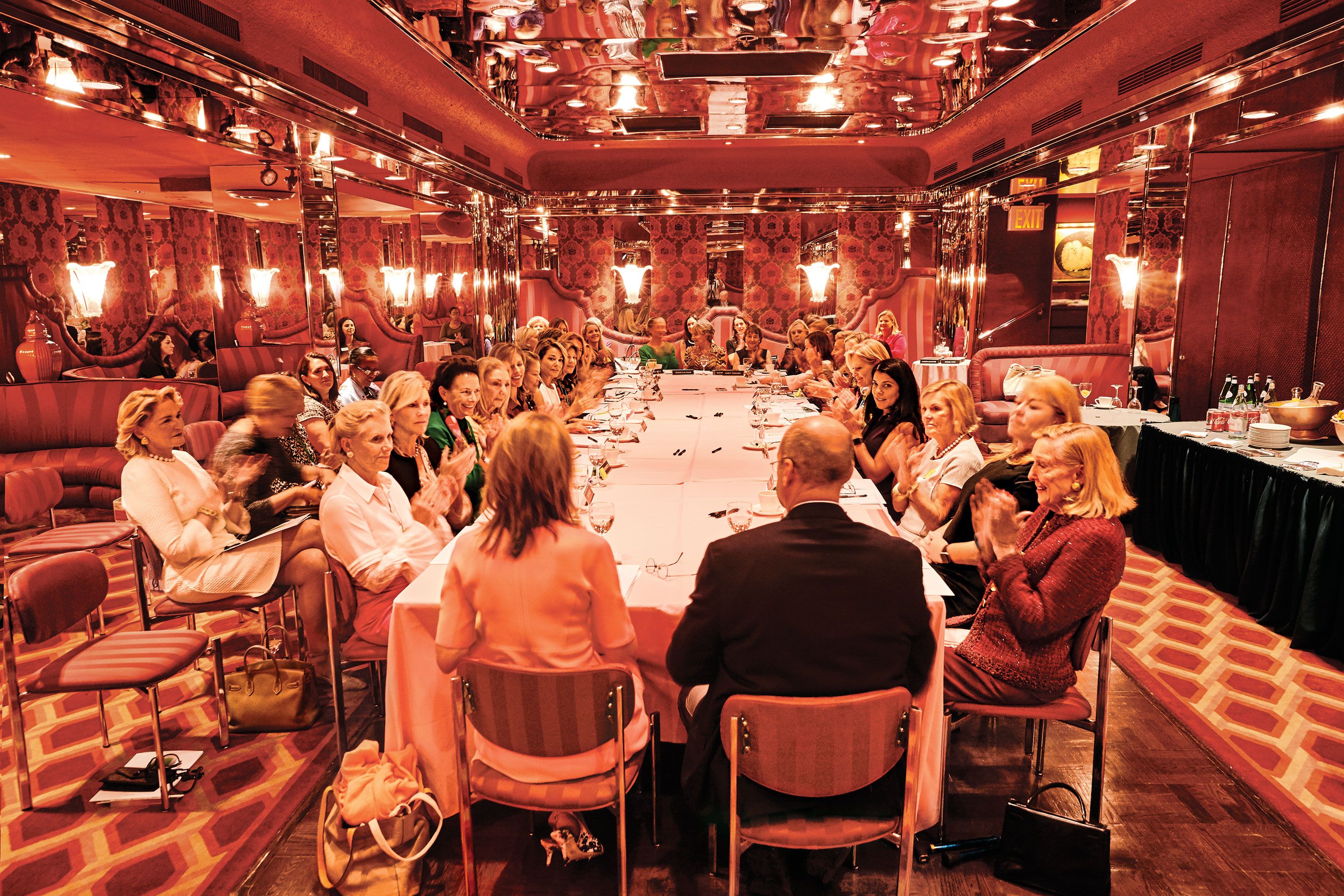
Anne Harrison, former president of the board: I got involved sitting next to Norma Dana’s husband at a dinner, and he told me, “They should really have attack dogs in the park,” and I said, “You know, I don’t think that’s such a great idea, but I love the park!” So he grabbed my hand and said, “I need to introduce you to Norma,” who is one of our founders.
Gillian Miniter, former president: My husband will call me and say, “I just had a business meeting, and this guy said his wife wants to get involved with the park; would you please call her?” Sometimes we end up with board members that way.
Alexia Leuschen, future president: My high-school gym class played softball in the park, but it was littered with needles.
Suzie Aijala, current president: I was mugged there when I was 9. It was disgusting.
AH: I remember my daughter picking up a cigarette butt and thinking, Really? This is what it’s come to?
GM: We have one of the largest fund-raisers in the city — the hat luncheon. What did we raise last year, $4 million?
SA: Four and a half million.
GM: And the trips! We went to Cartagena in January, and we’re going to Charleston.
SA: We’re workers. We’re not fluffy. You know what I mean?
AL: A lot of people come here and think they don’t know anyone and then they realize that it’s just one, two, three degrees of separation.
GM: We’ve got West Siders, we’ve got downtowners.
AL: We try to get them when they have babies!
—As told to Amy Larocca
My Blind Neighbor
“He asked me to help him make his computer talk to him again.”
Abandoned in the Bronx.
By Brandon Harris
I heard Sean before I ever saw him. Screeching electronic beats would fly through the air near midnight into my previously quiet $800-a-month studio in the back of an unattractive two-story building on Bathgate Avenue in the Bronx. When it started, I had lived there only a month, in exile from a Brooklyn that seemed to hold only dead-end living situations and closer to my job as a visiting professor at a university I owed tens of thousands of dollars to. The sound was soon followed by the smell, the saccharine stink of menthol cigarettes creeping into my flat from our shared hallway, where my neighbor stood to smoke. Sean often left his door open at night, and so I followed the rhythm of his day, the sounds of movies giving way to white noise, before the late-night bursts of music production would rattle me awake.
I can’t remember how I first recognized that Sean was blind. Perhaps it was when his aide, a stricken-looking younger African man with red-rimmed eyes and a weary way, would walk him back into the building or deliver food. Perhaps it was when I came out to ask him to not smoke in the hallway, which, come to think of it, I never did. I do remember the way we slowly got to know each other, two midwestern Negroes at the end of a city, and the way he came to rely on me to find things he had misplaced in his apartment, or asked me to help him make his computer, which he used more than most people who could see, talk to him again. He said he had spent most of his adult life blind, his vision taken in a gangland fight over some silly beef that his every moaning call to his aide suggested he would never cease to rue.
He was sad when I moved out. I didn’t tell him I was moving into a massive, rent-controlled loft in Dumbo, one of the last of its kind, given the neighborhood’s transformation, one that an ex-lover and ex-colleague and soon-rival were illegally subletting to me. Or that I was from Cincinnati; I’m pretty sure that, instead, I claimed to be from Detroit. I donated a desk and some marijuana to his cause. I claimed I’d come to visit on my way to get some fresh mozzarella and some prosecco (on tap!) at Mike’s Deli, on the avenue, but then I never did.
My Fan Club
“Am I reading on the train now to maintain my status as a hot dude reading?”
Instagram famous on the F train.

Benjamin Roberts: I had just left the gym; I had a little pump going. In the caption on the photo posted on Hot Dudes Reading, the account owners guessed that I was a CrossFitter, so they nailed that one. The photo was 100 percent candid, though I did have this weird sense that I was being watched. That day, I was reading Dream of the Red Chamber, by Cao Xueqin, which is a classic Chinese novel. I had only started it a couple of days before, so that’s why it looks like I’m about 20 pages into it.
My girlfriend at the time was the one to break the news that I was officially a Hot Dude. She said that a couple people from work told her about it. Afterward, I started to go through the mental gymnastics of, like, Am I reading on the train now to maintain my status as a hot dude reading?
The best thing about it all was attending a fan meet-up after the Hot Dudes Reading book came out in 2016. A British girl who was there introduced me to the writer Siri Hustvedt and her novel What I Loved. I don’t even really think of myself as a “hot dude,” but it’s nice to be an ambassador for the brand. I still wear my hair in a man-bun sometimes.
—As told to Allie Jones
My Gang
“Boy, you want to run for the Assembly?”
David Dinkins remembers all his opponents.
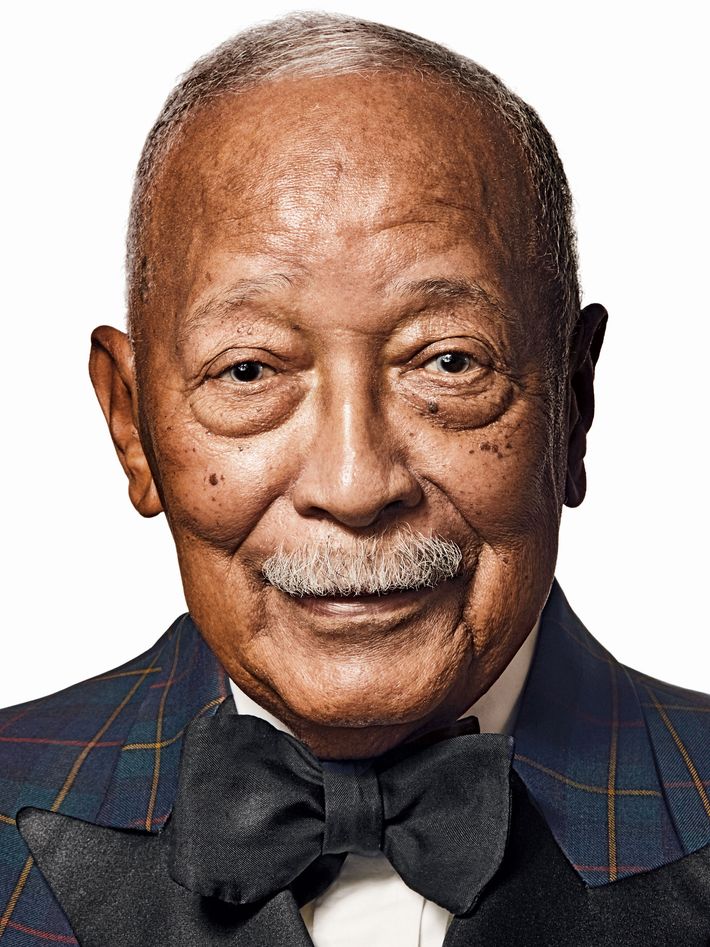
“Way back, like 1939, my father-in-law, Daniel L. Burrows, had been in the State Assembly. He knew all the people, politically, and he wanted to see that his son-in-law got a break. And it was he who first introduced me to Ray Jones.
Ray’s nickname was “the Fox,” and that was appropriate, because he was tough, very smart, and smooth. He was our local district leader, and he became the first black leader of Tammany Hall. The political clubs, that was the method of networking in that day. A lot of lawyers were members, and they’d come once or twice a week and help people with their legal problems for free. Ray would also help people get jobs. One of his favorite sayings was “Nobody does anything for nothing.” So the community could be counted on to vote consistently Democratic.
One night, Ray came out of his office with a big cigar and said, “Boy, you want to run for the Assembly?” I said, “I don’t know — I guess.” There had been a federal lawsuit, and the result had been an expansion of the number of seats, creating a space for which I could run. So I won. Now I’m hopelessly hooked on public service. This is what I want to do.
Percy Sutton, Charlie Rangel, Basil Paterson, and I — the so-called Gang of Four — we always believed nobody gets anywhere alone. Everybody stands on somebody’s shoulders. It was Ray on whose shoulders I stood.
There were many positive aspects for city government of the clubs’ being in control, such as balanced tickets: Time was, you could count on a citywide ticket in the primary having at least one Jew, one Italian, and so forth. There were certainly some downsides to Tammany Hall too.
There came a time, in 1977, when Ed Koch and Mario Cuomo were in the runoff for mayor. There was always tension between blacks in Harlem and those in Brooklyn. The word came that the black political bloc in Brooklyn was going to support Cuomo. So Percy, our leader, said, “Fuck ’em. We’ll support Ed Koch.” Because they both looked alike to us anyway. Here’s the thing: Ed Koch had been a very progressive, liberal member of the City Council and the Congress, so it sort of made sense to back him. Ed was honest. He was arrogant. But he understood one thing: As he used to say, “If a sparrow falls in Central Park and you’re the mayor, it’s your fault.”
Over the years, he moved more and more to the right. So much so that it was determined somebody should run against him in the 1989 primary. I never started out saying, “I want to be mayor.” But it ultimately fell to me. I never want it to sound like I’m saying I was drafted, but in a way I was. By Basil and Jesse Jackson and Charlie Rangel. And Bill Lynch — oh, what a sweetheart. Jesse used to say, “You don’t have to be loud to be strong.” I found that valuable. I remember Harry Belafonte saying, “Dave, you must run for mayor.” So I ran. We got 51 percent. I can always say I defeated Ed Koch and Rudy Giuliani in the same year.
Well, it was a very difficult time. The way the press wrote of the high crime rate in the ’90s, it was as though there was no crime on December 31, 1989 — just the next day, when I took office.
The biggest disappointment? Crown Heights. The real tragedy was the deaths of Yankel Rosenbaum and Gavin Cato. There wasn’t a hell of a lot we could have done differently. The sad thing for me personally, I was accused of holding back the cops, letting blacks attack Jews. This was not true. It was painful, painful. The other thing that sticks in the minds of many people is the Red Apple boycott. I wish now I had crossed the picket line sooner.
Rudy is not a nice guy. He really isn’t. Simply put.
History is kinder and more accurate in many cases than the contemporary observers of the scene. I’ll read about things we did in City Hall — in housing the homeless, in Safe Streets, which turned things around on crime — where we get some credit now. Eli Attie, a great little writer, he later worked for The West Wing; he wrote the concession speech in 1993, except for the last sentence or two. Those were by Peter Johnson Jr., a lawyer and one of my aides. Peter wrote, “Mayors come and mayors go. The city must endure.” See, that’s the whole point: No one gets anywhere alone. All right, young fella.
—As told to Chris Smith
My Game
“Lin’s the worst player of the group. He thinks three pair is good.”
Once a month, some Broadway producers and their friends play poker in a midtown office building.
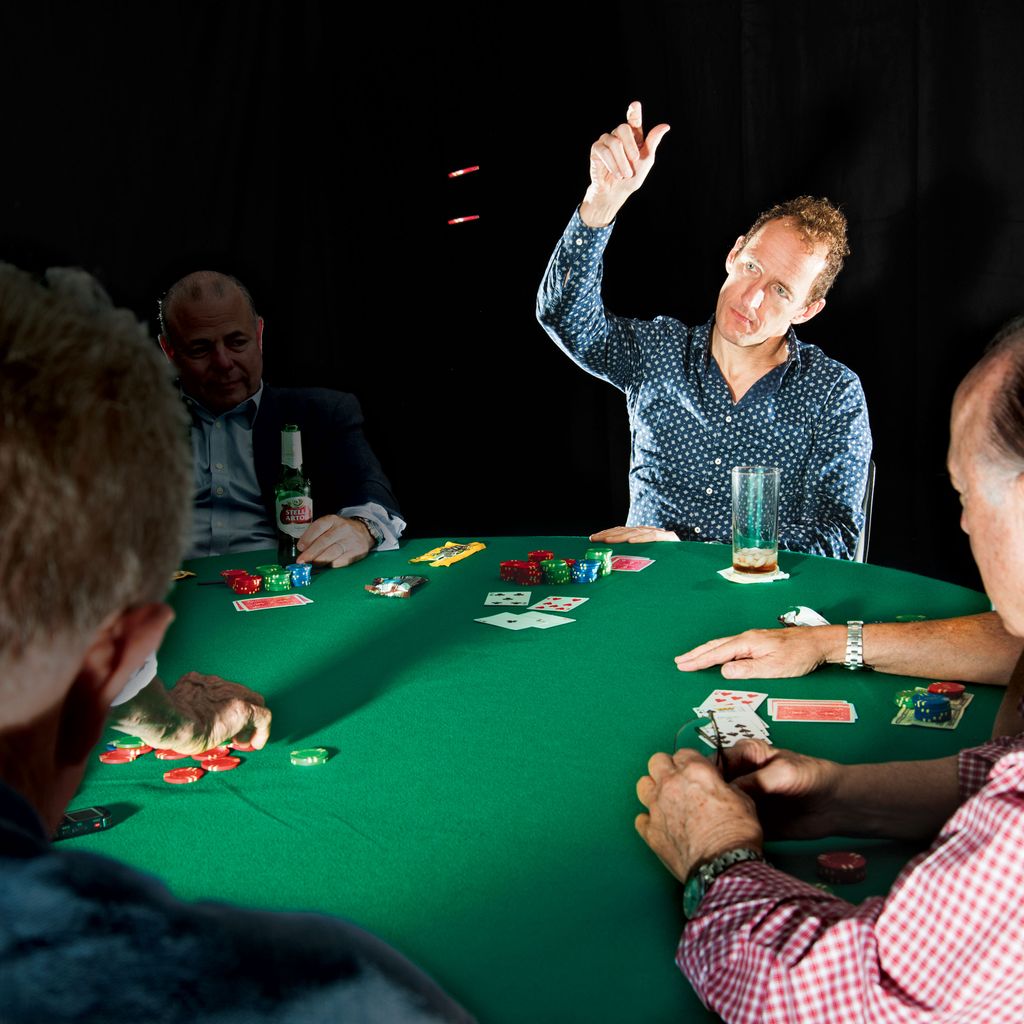
Steve Gutman, former president of the New York Jets: Seven or eight years ago, Manny Azenberg and I were on the way home from Il Riccio, and Manny said, “We ought to get a poker game. You know anybody?” I said, “Well, Ned I’m sure would play,” and Manny said, “That’s enough from you. I’ll add the rest.”
Ned Gurevich, insurance executive: We lived in the same neighborhood in the Bronx in the 1940s. Manny and the two Steves all went to Bronx Science.
Manny Azenberg, producer: We called up about 12 or 14 men, including Lin [Manuel Miranda], who isn’t here tonight.
MA: Lin’s the worst player of the group. He thinks three pair is good. But Jeffrey plays, so Lin and Tommy Kail found out.
Jeffrey Seller, producer: Tommy could play a little poker. Lin couldn’t play for shit.
MA: Everybody at the table can afford much more. But most everybody here grew up without. So they deal with the money as if it’s real. If you raise me $2, it’s “You fuck!”
JS: The day I had to announce that we were closing The Last Ship, the failed musical that Sting wrote — I was going to lose definitely over a million dollars personally, but that night I won $200 here. It was a small victory amidst a colossal defeat.
MA: Steve Gutman’s the best player.
SG: That’s absolutely not true. The trick is just not to lose too much when the cards aren’t going your way. I’ve never played at any other tables.
Steve Karmen, composer: Don’t believe Steve. It’s like the girl who says “I never did this before.”
Bob Fried, accountant: Jeffrey does extremely well because he doesn’t give a shit.
Ron Shechtman, attorney: I got business with Jeffrey, when I represented the cast in Hamilton.
BF: But Manny will not allow shop to be talked.
Jerry Patch, artistic director: There’s a common language between us, but we’re not allowed to speak it.
JS: No show business.
—As told to Boris Kachka
My Family
“Every time I talk to my sister, she’s crying.”
Waiting at JFK for the flight from San Juan.
“I talked to my mother before Hurricane Irma, and she was like, ‘Oh, you know us islanders — we’ll be fine.’ Then before Hurricane Maria, she was like, ‘I’m scared. This is gonna be bad.’ That was the last time I talked to her. I had a plane ticket for a while, but I couldn’t get ahold of her to tell her. She has two sisters, but they’re an hour away. One of my aunts called my cousin, who found my mom on Saturday and told her, ‘You’re leaving Monday.’
“She’s 62. She lost everything. She’s coming here permanently. She just put a few things in a backpack and that was it.” —Marie Singh, Hartford
“We’re waiting for my two nieces. They live in the mountains, and nobody wants to deliver water or food there. Every time I talk to my sister, she’s crying. She goes to the store, and there’s a four-hour wait, and then inside, there’s only one loaf of bread. Plus, there’s no jobs right now, so there’s no money. She’s worried that if she leaves, she won’t be able to get her job back.” —Lourdes Calderón, Hell’s Kitchen
“We’re still waiting for my father and grandfather. The power is out. People are fighting for food — they’re even fighting for ice.” —Michelle Rivera, San Juan
“My daughter stayed. She’s young, so she can handle it. But I got sick — maybe from the water? The stress? Who knows.” —Carmen Lopez, San Juan
—As told to Reeves Wiedeman
My Motivator
“Good money! Good money! Good money!” Lessons over sit-ups.
By Hari Kunzru
For some time, I wasn’t sure if Jimmy Love was his actual name because he talked quickly and mumbled. It turned out that the “Love” was an “I’m a lover not a fighter” personal statement and his surname was something else entirely. As a new immigrant to New York, I wanted to fit in. I knew that the culturally appropriate thing would be to hire a shrink and a trainer, but I couldn’t afford both. So I walked through the doors of an East Village gym and signed up for a trial session. Soon, I was doing push-ups as Jimmy held his cell phone in front of my face, the screen displaying a motivational image of a BMW convertible, chanting ecstatically, “Good money! Good money! Good money!”
The car was motivating for Jimmy Love, since he wanted to buy it, and it was nice that he thought I’d be as excited as he was. I grew fond of his energy, his constant amazement at the world. He’d launch into anecdotes that assumed prior knowledge of the complicated politics of the gym, or his favorite musicals, or the names of other clients. He once asked me if mermaids were real, and, when he saw the expression on my face, claimed he was “just checking.”
Jimmy Love was an extreme neat freak whose romantic life was ruled by various paranoid maxims. You never want to let them know where you work. Never let them leave a toothbrush at your place. He would ask my advice, mostly about geography.
“She’s from one of those A countries.”
A country beginning with A? Armenia? Albania? Algeria?
He thought that was it. She liked it that he didn’t drink. I once helped him write a pitch document for a business he was thinking of starting, offering personal training to overweight children, and he sent me texts containing fridge-magnet wisdom (“You can travel the world but what lies within us is a world less traveled”) and at least once a session would utter what I came to think of as his catchphrase: “It’s not a game. You’re in the game.” It was like a Zen koan, utterly nonsensical but weirdly profound. When, years later, I eventually quit, he sent me a hurt text. “You obviously don’t value personal training.”
My Confidants
“He was brainstorming ways to kill his dogs without getting caught.” The confessions that stuck with a bartender and priest.
Social Worker
Gemma Barriteau, Brooklyn
In the ’80s, I worked in adoption and foster care as a caseworker. I had a mother who was 24, 25 years old. The man she was with was probably in his 30s. And he was the father of her nine children. Three of them were with his mother, and the rest were in different homes. At the time the mother gave birth to the ninth child, I went to see her at the hospital, and I ran into him.
His clothes were dirty and kind of hanging on him. You could see that, you know, life was hard. Drugs were definitely a major factor. I asked him to step outside with me so I could speak to him in private. And I asked him, why did he keep making babies that he wasn’t taking care of? She was African-American, but very light complexioned, with light eyes — as am I — and he was very dark. And apparently, all the kids came out her complexion. And he said to me that he was going to keep doing it until one came out as dark as he is.
Pastor
Father John, upper Manhattan
I was on duty in Washington Heights. He looked like he’d been on the street at least a couple of days. I had never seen him before. He sat down and says, “Now, I know you can’t tell anybody or report me to anybody.” And I said, “That’s right. This is under the seal of confession.”
So he said, “Okay, well, I killed somebody during the weekend.”
I said, “Do you mind me asking some details?” And he said he had the urge to kill. He was obviously mentally ill. He was in one of the parks, and he attacked a young lady. And I said, “Since a crime has been committed, would you go with me to the police, or go with me to see a friend of mine who’s a doctor at NewYork-Presbyterian down the block?” And he says, “None of the above. I just want my absolution.”
So I said, “Well, I’m gonna give you a conditional absolution. I want you to agree to go to one of those two people or come back to me so we can follow up.”
I went through the absolution ritual and the prayers. And then he left.
The next day, I looked at the paper. And sure enough, the murder he described was there. And obviously, I couldn’t go to the police. I couldn’t go to anybody.
He came back a couple weeks later. He told me that he had done it again. I said, “Well, this time, you don’t get absolution unless you let me help you. You really need help.” I thought he was going to get nasty. He raised his voice, but that was the extent of it. Then he left, and I never saw him again.
And that second murder was also in the papers.
Psychic
Cora, Flushing, Queens
The woman came in to me, a young white lady. Educated — 28, 29. I read for her a few times before. She sits down in the chair. She shuffles the cards a few times.
And she told me, “I’m having a baby by a different man.” I asked, “Is it not your husband’s?” And she says, “No.” She was gonna go abort the baby. I told her, “Keep the baby. But never tell your husband.” I asked her, “Can you keep it a secret for the rest of your life and never tell your baby either?” I told her to end the other relationship and stay with her husband. They’d been going out since they were 16 years old. So how can you break his heart by telling him that his wife is having a child by someone else? She loves her husband! She was just bored. She wanted to keep the baby. She just needed — what’s the word when you need someone to tell you? A psychiatrist does not have a solution to the problem. They say do whatever you wanna do. I give you a solution to the problem.
Bartender
Sarah Fallon M, West Village
He’s small and kind of round and probably in his early 30s and he has an extremely effeminate voice. And he came around and would brainstorm ways to kill his dogs without getting caught. His two Chihuahuas were elderly and ill and they were ruining his life. They needed to be spoon-fed. They’d go to the bathroom in the house. They needed medication. They were blind, and they kept walking into things and injuring themselves. And he was trying to get a new relationship off the ground, but he couldn’t go on vacation, he couldn’t go anywhere. He thought about getting someone to shoot them. He said that he had a sister who lived in the country who he could get a gun from. He thought about poisoning them. But then he would have to force-feed them poison, and he didn’t want to have to do that. Throwing them into the East River. He wasn’t talking about this for amusement. He was done with them.
—As told to John Bowe
My Orgy
“Alice and I, we were just having sex in that tent.” Once a month, on a Clinton Hill roof or sometimes a boat, the sex party known as Chemistry draws its regulars.
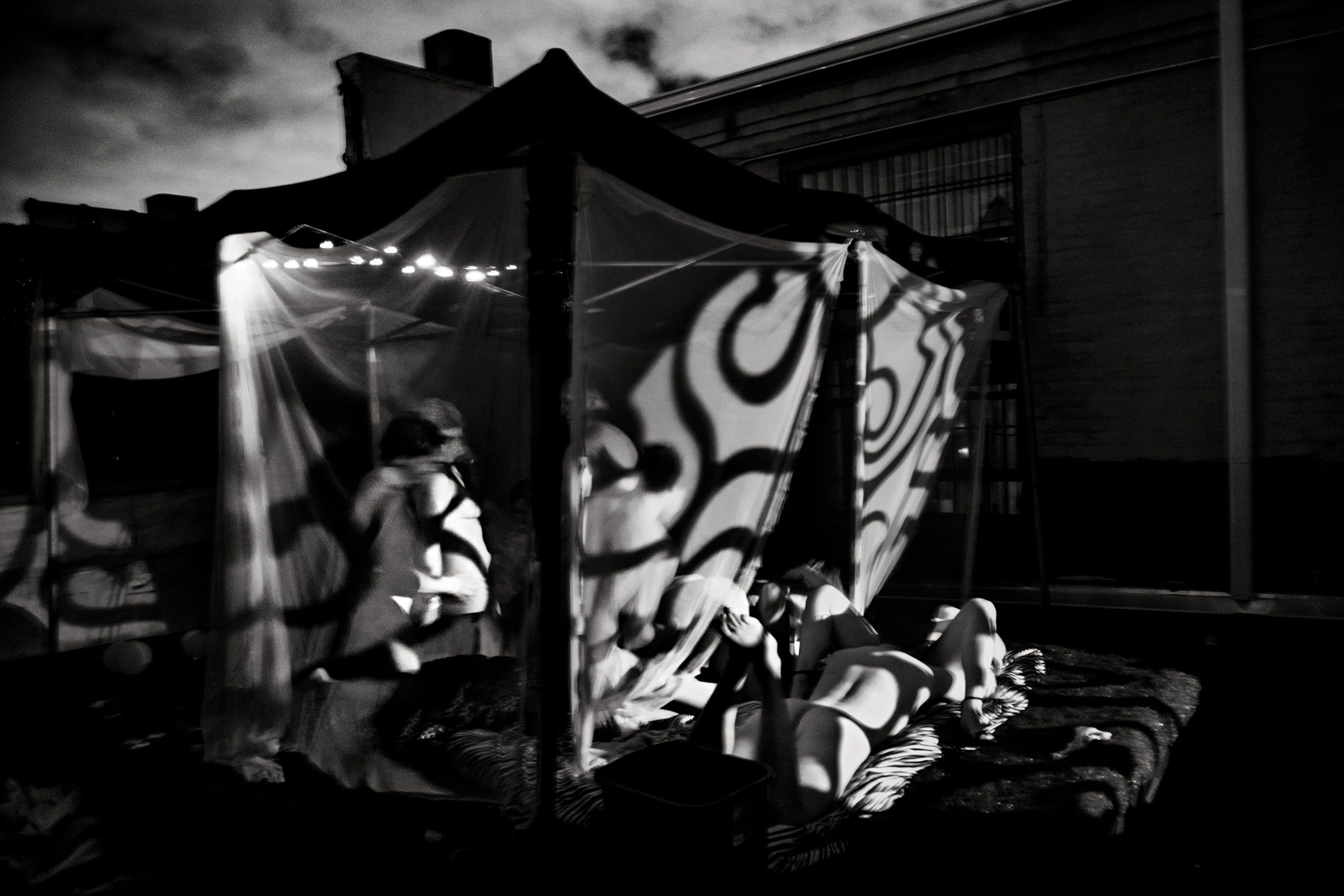
Alice: Oh, there’s Sammy! In the hammock.
Kiki: Alice and I, we were just having sex in that tent.
Alice: This party used to be fringier.
Kiki: Now it’s more mainstream. Oh, there’s Kenny and Oksana …
JJ: This might have been the lowest-attended party I’ve been to. It might have something to do with the Jewish holiday.
Preston: It’s all a little fuzzy, but I think Sarah and I paired up with a really lovely young woman, and the three of us had a lot of fun together.
Sarah: It’s really time-consuming to get ready if you know that you’re going to be naked in front of somebody. There are so many things you have to do. But this time we got the waxes a week in advance.
Preston: We really treat this like a performance. Sarah and I went and we worked out together. We ate a really healthy meal, did a bunch of primping, and prepared our little kit that we bring with us.
Sarah: They usually provide condoms, but we want our own. Ours are better. Also, we always bring a granola bar.
—As told to Allison P. Davis, with one name changed
My Team
“I had lunch with Richard Nixon five or six times. He just wanted to talk about baseball.” Eventually, Keith Hernandez went to a shrink.
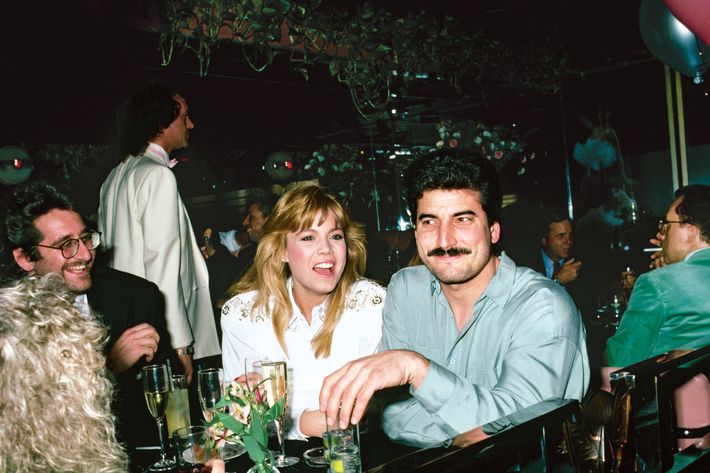
“Two people changed my attitude and my life. I came to New York, to spring training for the Mets, in ’84, and Rusty Staub said, “You’re single! You’ve got to live in the city.” Rusty got me to live in the city. Ed Lynch, Danny Heep — who was married, but Janey was one of the boys — Ron Darling, and me were the only four who lived in the city. We’d have lunch at Rusty’s restaurant on Third, baby back ribs, and then go to the ballpark in his meat wagon.
In ’86, we win the World Series. I remember after the final game, Bobby Ojeda, my brother, me, and some other people get a limo and we’re going to Columbus, a restaurant on 69th. That was a pretty hot little spot, a lot of entertainment people went in there. We walk in around 1:45 in the morning and it’s packed. They all stood up and gave us a standing ovation, started yelling, “Speech, speech, speech!” I almost didn’t make it to the parade the next morning. I overslept. I didn’t shower. Stupid me, we took a cab downtown, Ojeda and me. We couldn’t get near the cars we were supposed to ride in for the parade. It was a throng of people. There’s a wrought-iron fence, ten feet high, separating us from where we need to be. People lifted us up, Bobby and me, and passed us over the fence.
After we won the World Series, I didn’t pay for a meal for six weeks. We’d go to Canastel’s, down on Park Avenue South. It was Dom Pérignon or Cristal for the table. They wouldn’t let me pay. Obviously, we left lavish tips.
The second person who changed my life in New York was Bobby Zarem, the publicist. We were in Los Angeles in 1987, playing the Dodgers, and a bunch of us went out to a club, and I met Bobby. And Bobby Zarem is the one that opened up the amazing world of New York City to me. From ballet to theater to movie openings — Sea of Love, and I met Marty Bregman and Ellen Barkin and Al Pacino. Opera —Verdi. Went backstage and met Plácido afterward. He’s sitting on like this little throne, and he knows I’m coming, because of Bobby. He goes, “Keith! I am so sorry — I sang like a .230 hitter tonight! I’m sick. Please forgive me. Come again and I’ll sing like a .300 hitter for you.” He is a huge baseball fan.
And of course Elaine’s, and the people I met up there through Bobby. I’ve been at the same table as Elia Kazan and Sophia Loren. Keith Richards was there with his wife one night. I didn’t know what to expect — he had the bone in his hair. He knew baseball! He didn’t want to talk about the Rolling Stones. I’m a kid from a little town in the artichoke fields just south of San Francisco. I’m the son of a fireman. There were nights at Elaine’s I’d look around and think, Where am I?
Elaine is the one — I was around three years into retirement and coming in there most nights. I was on my … sabbatical. I’d had enough of baseball, and I was trying to figure out what was next. She came up to me and whacked me in the shoulder and sat down and said, “What the fuck are you doing with your life?” She goes, “You are so talented! You should be managing the Mets! You’re wasting your life!” I’d never had a conversation with her like that. It sure made an impression. I was still a couple years away, though.
I had lunch with Richard Nixon five or six times. What was weird about it was I would try to get him to talk politics and foreign policy and he wouldn’t go there. He just wanted to talk about baseball. The last lunch I had with him, I finally said, “Mr. President, you always talk about baseball. How about once …” He said okay. And he went on for an hour and a half about the Russians, the Chinese, the Vietnamese, the Germans. It was like I had a class at Harvard or Yale. Bobby opened up every aspect of the arts to me, having conversations, dinner, with these people.
I’m living out in Sag Harbor now. I used to be fearful of being lonely when I got older. Also, my dad was embittered at the end of his life, and I felt myself maybe going down the same path. So when I retired I did five years of Freudian psychotherapy. Five days a week on the couch with Dr. James Strain. I was probably able to go to him because he’s a baseball fan. The most important thing I got out of it was I had always needed to have someone around me. Now I don’t. I can be alone. I don’t go from one relationship to another just to have comfort. Funny, isn’t it? I had to come to New York to learn to be alone.
—As told to Chris Smith
My Angel
“He wanted somebody who could make a gay fantasia.” Oskar Eustis was fired by his best friend, Tony Kushner.
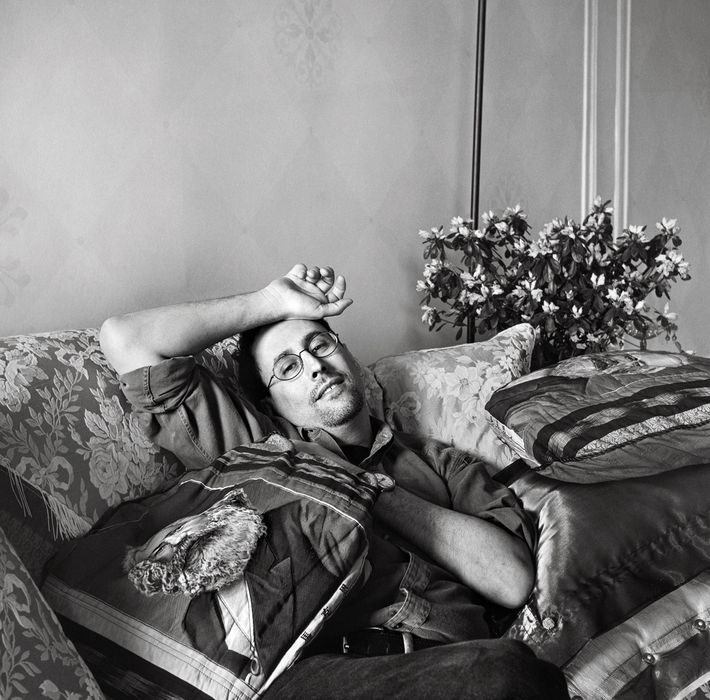
“Tony Kushner and I have now shared 30 years together. It’s half my life that Tony’s been my best friend. We talk about everything. We have to make a rule to not talk about Scott Rudin too much. But we talk about theater all the time and we talk about politics all the time. Tony is one of the great talkers of the Western world.
In 1985, he had just graduated from NYU in the directing program. He started writing plays just to have projects to direct. A friend of mine was in one of those plays and kept telling me, “You’ve got to meet this kid.” And I was a very big, important artistic director [at the Eureka Theatre] in San Francisco at the time, and I pooh-poohed the idea that I needed to meet this kid. Until one day, I was coming to see a Len Jenkin play with that friend, and we’d missed the curtain and there was no late seating. And this friend said, “Well, you know that kid I was telling you about? He’s got a workshop production up in Chelsea, let’s go see that!” And I said, “Fuck, okay.” I was sure it was a waste of time.
It was a tiny little black box — you know, 90 seats, wooden risers, four stories up. There was some kind of brothel on the floor directly above and a size of imagination that could have filled a theater 100 times that big. There were problems with the play, but it was so smart and so beautiful. It was A Bright Room Called Day, which we’re going to be reviving next year at the Public. Which I haven’t announced, but I guess I just announced! It’s about the last six months of the Weimar Republic and the first six months of the Third Reich. And the basic point of it was how incredibly easily democratic institutions can be swept away.
Tony and I met that night and then, in a sign I should have taken more seriously, it took me almost a year to get the script of the play out of him — and it was already written and performed. I finally ended up directing it in the fall of 1987, at the Eureka, and that was Tony’s first professional production. By the time that had opened, we had already commissioned Angels in America.
There’s no artist I’ve learned more from than Tony, and what I’ve learned is a kind of fearless grandiosity. Angels was an immense act of arrogance — to write a seven-hour play about gay people when you were a completely unknown writer whose one show was at best a succès d’estime. So there came a moment where it became clear to me that the Eureka Theatre did not have the resources to do Angels in America. And at that point, I’d have to say, “Thank you very much for writing this, but you’re two years late, it’s still a huge mess, and I have a theater to run.” But I did the opposite. I said, “That show is so good that I believe in it more than I believe in my theater company.” And I left the Eureka and went to Los Angeles to produce Angels in America. I spent six years total with Angels.
Once I accepted that Tony wasn’t late on his deadlines because he was a lazy bum but because he went more deeply into the content of his plays than anyone else I’ve ever seen, then I thought, Okay, my job is to block downfield for him: get the grant money that will allow him to live, find the places where we can workshop this, just give him the space to finish this thing. It remains in a way the greatest achievement in my life, helping to keep the world off Tony long enough for him to finish that play.
And then we were near the end of the rehearsal period, and he came to my house and said, “I don’t think you’re the right person to direct this play.” The way Tony put it was that there was a showbiz element that he wanted in the production that he didn’t think I could provide. He wanted somebody who could make a gay fantasia, and that’s what he got from George [Wolfe, then the director of the Public Theater]. He got a beautiful production.
But I took it as a really difficult blow. I spent about a year, very angry, very distanced from him. The way we put the friendship back together is really through Tony’s unbelievably consistent generosity and refusal to let go of me. He dedicated his next play to me.
A really key moment in our reconciling was when I did Homebody/Kabul at Trinity Rep. That was the first production we worked on again together. And then there was Hair. Tony agreed to do the new book, and then I discovered that Jim Rado was very much alive and under no circumstances was going to allow anybody else to do a book for Hair. But we discussed Hair endlessly. We did it without Tony’s new book, but his ideas made it in there. Even if Hair wasn’t of the moment, it still could be made to resonate with the moment. In that summer of 2008, Darius Nichols, who played Hud, had the song “Colored Spade.” He names all these horrible derogatory terms for what he was, and he’s claiming them as his own, then he walks straight downstage and says, “… and president of the United States of Love!” And the day after Obama got the Democratic nomination, the place went insane. The beautiful thing about the theater is that at its heart it’s such a positive form, binding the entire audience together as one body and making them feel like they’re citizens. E pluribus unum.
That’s what happened with Julius Caesar this summer, and I haven’t talked about this because I didn’t want to give fodder to the enemy. But the real reason that I did Caesar was to provide a cathartic experience for those of us who are losing our minds. What I could feel in myself and in the audience is that we were playing out this violent fantasy and, by playing it out, puncturing its power. So it’s not a coincidence that we’ll be reviving Tony’s A Bright Room Called Day before the midterm elections. The election of Trump really reveals to us that what we thought of as norms were really historically limited and may change completely. That’s kind of what I think Bright Room is saying. Pay attention and defend this thing we have, because God didn’t decree that it was going to be here forever.
—As told to Boris Kachka
My One Good Roommate
“ ‘Fabulous Nobodies’ is what my co-worker called them.” Imagining the Paris Review of Budapest.
By Heidi Julavits
The house belonged to a film director who was always “in Belize.” His young wife invited her transient friends — and her friends invited their friends — to live with her in the house, which was invisible from the street because the city had built a block around it.
I was a friend of a friend. I rarely saw our roommates. They did coke and drank red wine while I slept. They recovered behind one of the many closed doors while I completed job applications atop their morning-after stick.
For about 48 hours, a man shared the day with me. He was moving to Hungary to start the Paris Review of Budapest. He didn’t want to be a model or an actor or an actor-model. (“Fabulous nobodies” is what a co-worker at my eventual waitressing job called these dreamy, pretty people.) He emitted a calming energy, like a gong struck so long ago you can no longer hear it. I’d moved to New York to stop going to parties. I considered, for half a second, following the man and his silent-gong energy. I should toil in the mailroom of the Paris Review of Budapest and fuck all the fabulous nobodies trying to lure me back to goallessness, fuck the noise and fuck the heat, which had been so unrelenting since I’d arrived from San Francisco, even at night.
I stayed.
In the early years, I kept tabs. He landed in Budapest — this was 1993 — and discovered that no one in a barely postcommunist country wanted a literary magazine. They lacked more immediately useful publications. The man and his partner founded the Yellow Pages of Budapest. He opened a Mexican restaurant using his grandmother’s recipes. He became known as the Taco King of Budapest.
I became things too. I became a writer. I became pregnant. In 2008, when I traveled to Budapest on assignment, I was pregnant again. Days before leaving, I remembered, as though waking from a sleep I didn’t know I was in: I know someone in Budapest! Online, I found the man. I emailed him. He seemed so excited to see me; I was, to a degree that surprised me, since I hadn’t thought about him in years, so excited to see him. When I arrived, the man met me at my hotel with a pair of his girlfriend’s shoes (I’d read the wrong weather report; I’d brought only rain boots). There we were, in a small hotel room, just the two of us, basic strangers save for the weekend we’d lived together in an invisible-from-the-street house stuffed with cokeheads, and it wasn’t even awkward. Around him so much human warmth emanated from me, and not just because I had an actual human inside of me.
His girlfriend hung out with me on the days when the man was busy. Other times, the man and I would just talk and talk; our shared history, though nonexistent, seemed to inexhaustibly lead us forward, outward, in all the possible directions, and I felt encircled, as though by a block of buildings, and safe.
Save for a few emails, I’ve had no contact with him since, which does not explain the importance I’ve assigned to him. He made me feel at home even when neither of us had homes. He was the first person I met who suggested I might, without ceding to my baser instincts, make for myself in this city a life.
My Audience
“All the dudes are like, ‘Yo, shorty knows the words!’ ”
Desus and the Kid Mero on figuring out how to be funny.
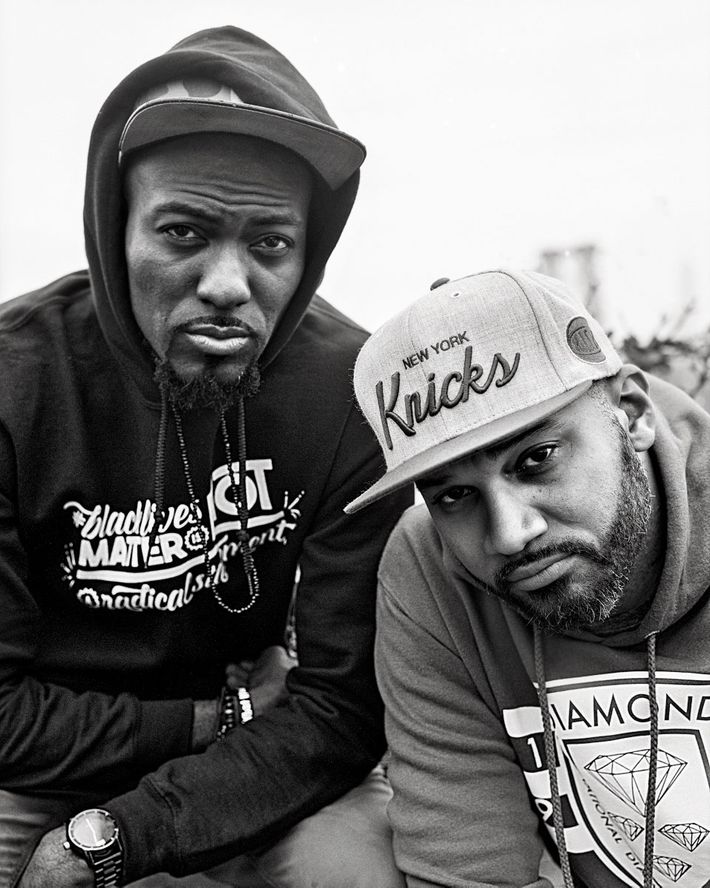
“The Kid Mero: I used to take the bus all the way up Tremont Avenue to West Farms, and my cousin Jochi would have me out on the block, hanging out with the older dudes. Just being there with the guys in front of the building, talking shit, listening to music. A lot of my comedy came from that. I was an 8-, 9-, 10-year-old hanging out with dudes that were like 20, 25. Just having to defend yourself in that atmosphere — these dudes know a lot more than you, they’re funnier than you, but you gotta hold your own. It was the essence of Bronx culture. There’s something very specific about the Bronx. You had Jamaicans, you had Dominicans, you had Puerto Ricans, you had West Africans, East Africans. Just by osmosis, you learn what they all think is funny and hone your comedy voice. You had to be so quick on your feet, because if you’d lose some little joke battle, for a week you’d get laughed at walking to the bodega by 12 different people.
I remember one day we were standing in front of the building and the Wu-Tang song “Da Mystery of Chessboxin’ ” came on. I’m like a kid, right? And I knew this song word for word. And there’s this dude singing along with me, just me and him, and he fucked up some of the words and I was like, “Bro, what?!” I just called him on it and then all the dudes are like, “Oh shit! Yo, shorty knows the words and you don’t know the words! Aaah!” It was validation for a fuckin’ 10-year-old, you know what I mean? Like, yo, I memorized “Raw I’ma give it to ya / with no trivia / Raw like cocaine straight from Bolivia.” And I just felt super.
Desus: My story would be different. When I was fresh out of college, I was working security at New York City nightclubs. They were all in Manhattan. One was called Speed; another was called Green Room. It was such a weird time in my life. You know you’re not going to be working at a nightclub forever, but it’s still a little depressing. There’s a lot of standing around for, like, five hours. I remember one night the temperature with the windchill was something like negative five. I was teamed with this Nigerian guy. He was taking accounting classes during the day, a really serious guy. So we were out there, like, freezing. Shaking your hands trying to keep your fingers warm, moving around. So to pass the time, I’d be making jokes. If you’re laughing, fives hours feels like three hours. And if I could get him to show his teeth while he was laughing, I was like, All right, I got a good one right there.
—As told to David Marchese
My Chorizo Buddy
“Then, one day, he stopped texting me back.”
Can a guy who tells you when certain burritos are in season also kinda break your heart?

Near where I used to live in Stuyvesant Town, there was this great bodega where an older Mexican lady and her husband would hand-make world-class burritos. Their chorizo burritos were the best but for some reason a limited commodity, so I struck up a texting relationship with their son, Ruben, who would tell me if they had chorizo. This went on for three years. Sometimes he would text me to say they had chorizo, but other times he would give me weather updates or let me know they were going to be on Bizarre Foods. Once, I accidentally texted him instead of my husband and offered to do his laundry, and he texted back, “Too late homie, it’s being washed as we text.” Then, one day, all of a sudden, he stopped texting me back. It was really sad. It was like someone ghosted me. This, above, is our last string of texts.
—Chris Rovzar
My Real Friends
“Have you ever seen a crackhead hustle?”
Sabu learned to hack on the Lower East Side.
“I grew up in the LES. In the ’80s and ’90s, we had a lot of drug problems and a lot of different gangs, like the gang my family was part of, the Champions. A lot of people died. I was always with my aunt. She was 14 years old when she was taking care of me as a toddler. She was considered a queenpin, and I got to see how she operated. Fast-forward to 1996, my aunt and my father had gone to prison. Giuliani did a massive sweep, took everybody. It worked out, because, you know what, they were either going to die or be degenerates in the street all their lives. So I was by myself, and there was a computer there. My aunt bought it for me before she got arrested. A cousin of mine, Kenny, came over and said, “Look, I know you’re depressed. You lost your whole family. I’m going to get you AOL. You can get on the internet and experience the world.” I was a 13-year-old boy stuck on AOL late at night.
There were a bunch of freaky-ass people online. But it’s how I got to experience the wonders of hacking. Here’s this little kid, in the middle of the projects, learning about Unix. I had no mentors. I had no guys on the corners saying, “Hey, I will teach you Unix for free.” I had to learn by brute force. But you know what I learned from the streets? It was the social engineering. Social engineering is the hacking of the human mind. Have you ever seen a crackhead hustle? That’s Social Engineering 101. So when I got online, it was crazy how I mixed technology with that environment.
By my late teens, I was living two lives. I hung out with my friends all day. We’d go out to a strip club, we’d get girls, go out to the races, get a couple drinks. Then I’d go home, and I was breaking into systems before I’d go to bed. In 2011, the FBI came to my house. They had something like 12 informants working against me. In the end, I did eight months in the MCC — it’s a maximum facility down the block. I also had to do three years of supervised release and a year of house arrest. Getting arrested was the best thing that ever happened to me. It changed my life. Now I’m a director at a cybersecurity start-up. I lead the social-engineering team. So I’m just hacking all day long. And I live in Queens. It’s a nice neighborhood. It’s in the middle of gentrification now. I’m watching it as it happens.
—As told to Nick Tabor
My Lovers
“Silk shirts fall open, rings are forgotten next to sinks. My diaphragm is always in my bag.” A brief list.
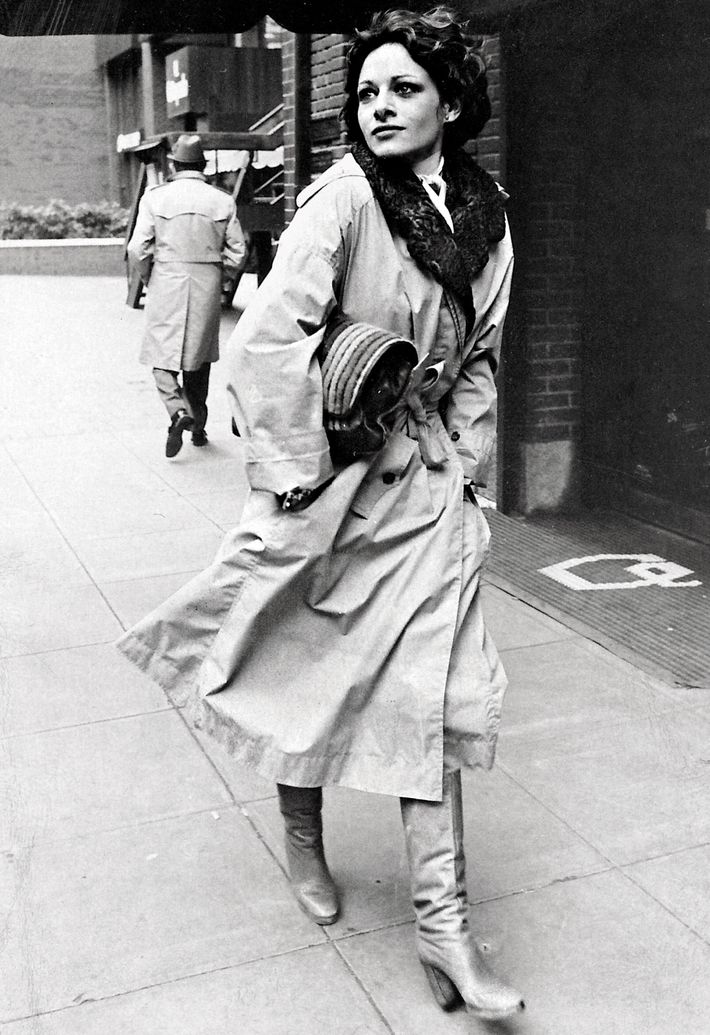
1. The first man I sleep with is an Englishman who crossed the Atlantic to join me at the Buchanan on 48th Street. We go to Serendipity to have frozen hot chocolate. Every morning he brings me paper-cup coffee in bed from the grocery store.
2. He lives in the Hotel des Artistes, but he’s a businessman. The front page of the New York Post thrown casually on a chair bears a photo of him dancing with a Ford heiress. The next week, and the week after, and the week after, that copy of the New York Post is still there. I take a closer look; it’s a fake, printed for a party.
3. I’m in love at last. He’s French, and he really prefers black girls. When he takes me dancing upstairs at Max’s Kansas City, I’m acutely aware of how white I feel.
4. He’s older, he’s a critic, he’s angry; he takes me on the terrifying Cyclone roller coaster on Coney Island. Stockholm syndrome sets in, and I go back to his place. I’m too scared of the New York night to leave and grit my teeth until morning.
5. My husband and I move to New York, but the house we’ve rented has fleas. We call in the exterminators and sleep at the Plaza.
6. The journalist knows the city. We watch Woody Allen play the clarinet; we force a jittery Helmut Newton to eat a Nathan’s hot dog in Times Square. I like his company, but I don’t trust him, I’m holding a torch for someone else.
7. I’m 35 years old and on one of many dates with the extremely rich man. I’m sitting to his right, presenting my best profile. He leans toward me and asks, “Have you thought about your biological clock?” “I don’t want children,” I snap. I don’t realize this is a New York City proposal.
8. He’s brilliant. He writes comedy. He’s funny like my Uncle Don, he’s bipolar like my father. Best to keep away from anything that feels like family.
9. October is Concorde season: Directors, actors, writers, and publishers fly in from Europe. Silk crêpe-de-chine shirts fall open, rings are forgotten next to sinks, and promises are made, forgotten, canceled. My diaphragm is always in my bag.
10. After a movie with friends on Third Avenue, why not go around the corner for frozen hot chocolate? As we walk down the street, I’m struck by the figure of a tramp staring at the bright window of Serendipity. Thin and old, he looks like the first man I ever slept with some 20 years ago. A week later, there’s a message on the machine: It is the Englishman; he found my number in the book. I stop answering the phone. And then comes this message: “I’ve been waiting outside the Buchanan every day, and it’s cold. Please let me come up.”
—Joan Juliet Buck
MY ASSIGNATION
“My back was up against the tree, and I couldn’t stop thinking about how much I was dying to try out Eataly.” 482 stories from New Yorkers on the bars, street corners, and stoops where they kissed, got naked, and did things they would someday regret. Read them all – and add your own.

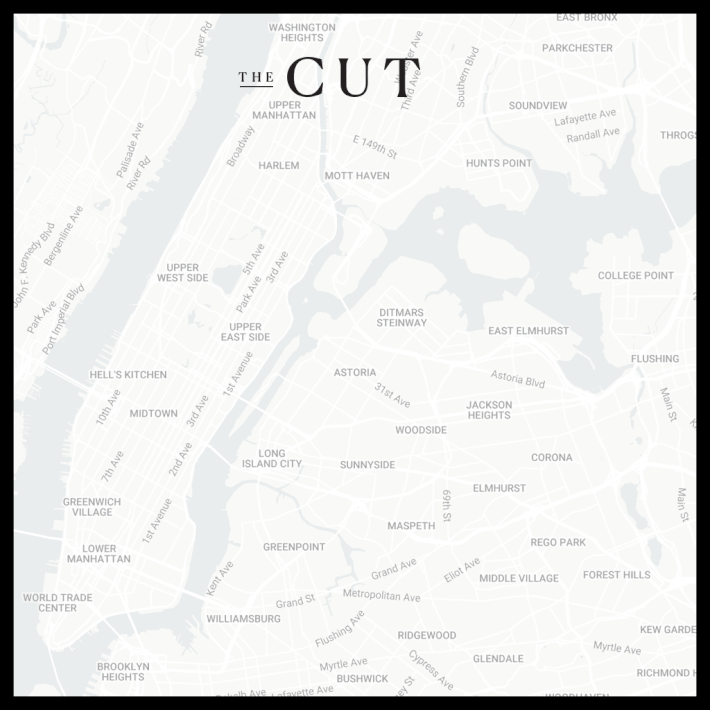
See the Full Love Map
My Dead “I’ve seen a hundred DOAs.” A midtown hotel, through the head security officer’s eyes.
“Paul Frederick, former security director, New York Hilton: People just do weird stuff in hotels. The traveling businessman you see going to work in the morning isn’t the same guy at three in the morning. We had one regular guest from a big-four accounting firm who’d be in his room yelling “Motherfucker! Motherfucker!” all night long. I once found a woman at the bar masturbating under a hotel blanket. And people leave guns in their hotel rooms all the time. You’re not supposed to have guns in New York, so people just stash them in the nightstand and forget. I had a situation where Bill Clinton was supposed to give a speech in our ballroom, and that morning a maid found a rifle in the closet. The Secret Service interviewed the guy, and it turned out he was going hunting upstate.
People die in hotels all the time. I’ve seen a hundred DOAs — that’s dead bodies. The coroner comes in, works for a couple of hours, then we take them down the back elevator. It’s mostly overdoses, heart attacks, and suicides: I guess we had really strong coat rods. Usually the maid finds them the next morning. One of my officers called me one night to say they found a body — he had put a bag over his head — so I told him to just make sure the general manager knew about it, and I hung up. We had just gotten a new GM from California, who calls me all flustered, and I tell him my guy has handled plenty of dead bodies in the past. He says, “What do you mean in the past?” He hadn’t seen any in California. This was our 13th of the year.
People want to know how the hotel staff in Las Vegas didn’t notice something suspicious, but the truth is, 60 percent of people who stay in hotels could be suspicious. We had a couple of officers who were basically hotel detectives. I can’t tell you how many times I’ve knocked on doors at two, three in the morning when two partners are yelling at each other. Sometimes, you just ask one of them if they want another room and don’t tell the other person the room number. Once, a guy woke up next to his dead girlfriend. The police interviewed him; he says they were doing drugs and drinking booze all night, and they let him go. Two years later, I get a call from a prison psychiatrist in Colorado, where this guy had been arrested for something else. He says the guy was talking about how he murdered his girlfriend at the New York Hilton.
—As told to Reeves Wiedeman
My Mirror
“I knew I’d made a mistake the minute I walked in.” Dressing for the boss when the boss is the editor of ‘Vogue’: what they wore when they first started.
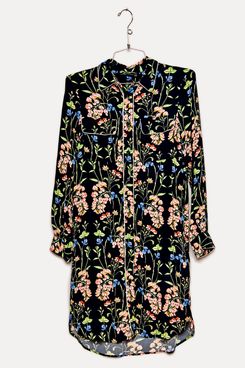
Corinne Pierre-Louis
A floral dress from Zara. Before the job, I’d worn a lot of black. But I knew Anna liked color, so I went shopping for girly pinks, pastels, florals. I never went back to wearing black.
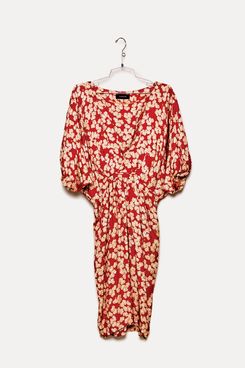
Indré Rockefeller
Red-blossom-print Thakoon dress and a pair of very-high-heeled beige YSL shoes. Looking back now, the heels were probably too high to be sensible, but I learned to move very quickly in them.
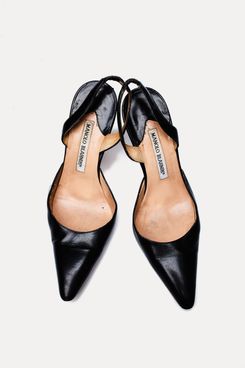
Luisana Mendoza
I wore an off-the-shoulder black top with a bright-green tank top underneath. Plus my mother’s Manolo Blahnik slingbacks, which seemed like a safe bet. I knew I’d made a mistake the minute I walked in.

Grace Hunt
I wore a gray tweed A-line Rebecca Taylor skirt. I thought it was a nod to Chanel. It really wasn’t.
—As told to Katy Schneider
My Going-Out Friends
“I have work at 9:30 tomorrow morning, but it’s also like, YOLO.”
On Friday nights, these DJs and artists get ready at Giovanna’s Harlem apartment.
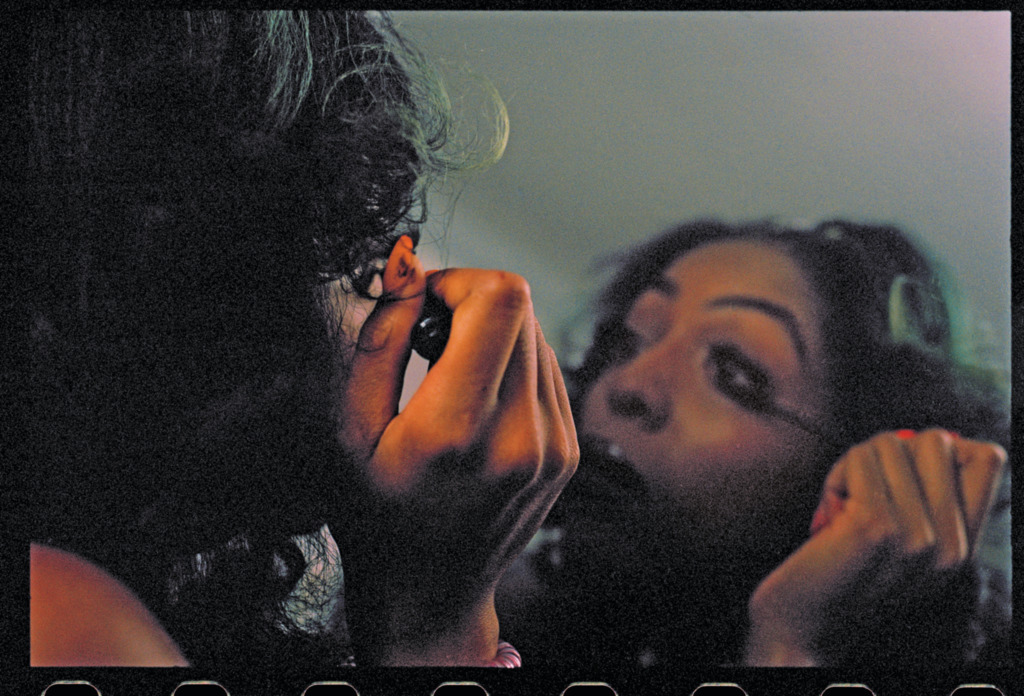
Dylan Ali: Okay, so the options right now are either the Milk party, if it’s still going on, or my friend Rebecca is hosting something in Brooklyn. I feel like Milk is probably going to be open bar. And also it’s to celebrate Trevor “Trouble” Andrew’s gallery, so there will be a lot of art around, which is cool. I don’t know. But Rebecca is a very good friend of mine. And I think Teeburr is DJ-ing.
Giovanna Santiago: You want some of this tequila punch? It’s regular Sunny D and orange-strawberry Sunny D and tequila.
Rahm Bowen: Should I cut the neck of this shirt out?
DA: I think you should keep it.
Dare Moreno: I love chocolate-chip cookies. I guess when we’re at parties, I’m the one that’s trying to find a guy to give me an Uber home. Without him.
GS: Okay, this is everyone’s personality. Dare, as soon as you walk into a party you’re going to lose her. Dare is living her life. Dylan is either DJ-ing or trying to find a person with a bottle. Or in the midst of a conversation with one of her random friends that none of us know.
Dare: That she met in Europe four years ago, on her bus back, when she broke her leg.
GS: It’s like, I don’t know who the fuck it is, but she knows them pretty well. They’re having a deep-ass conversation.
RB: I was that friend at one point in time!
GS: Darius is the same thing; y’all are twins. He’ll pop up, and you’ll be dancing with him, and then you’re like, Where did Darius go? He’ll dip off. Then you find him again, like, “Oh, shit! Where were you?” Darius will be finding some good gossip though. And then Rahm’s just observing. He’s on the wall. Sometimes he bobs his head to the song.
DA: Him and G are always plotting on something.
Dare: G is lit before the function starts.
RB: G is the main attraction. There’s a point in the night when G owns the whole floor.
Darius Moreno: She has her climax.
RB: The club turns into G’s at one point.
GS: Until I’m over it. And then I’m ready to go home. I danced, I’m tired.
Darius: So are we going to go out?
GS: I don’t know. I have work at 9:30 tomorrow morning, but it’s also like, YOLO.
DA: I’m recovered now, but when I was 19 or 20, I used to have really bad FOMO. There was a moment when I was at every function. Now I really need to always think, What’s worth my time? A party is worth it if there is at least either open bar or free food, or someone I fuck with or appreciate at it.
Dare: Open bar and free food, that’s like gold. Especially free food.
Darius: It’s never just a random club.
DA: We’re really trying not to do that anymore. All right, I’m going to the Milk party.
Dare: Is there open bar?
DA: Yes. It’s Milk.
Dare: That’s so much to get into sometimes.
RB: Can I leave my bag here?
GS: Mmm-hmm.
DA: On a scale of one to ten, how hairy are my legs?
Everyone: Not hairy.
GS: I’m working all day tomorrow. I’m staying here.
—As told to Allison P. Davis
My Artists
“Jasper said, ‘Well, I’ve had a hard time in my life. Don’t take that as the reason that I can paint.’ ”
Agnes Gund hates it when things are askew.
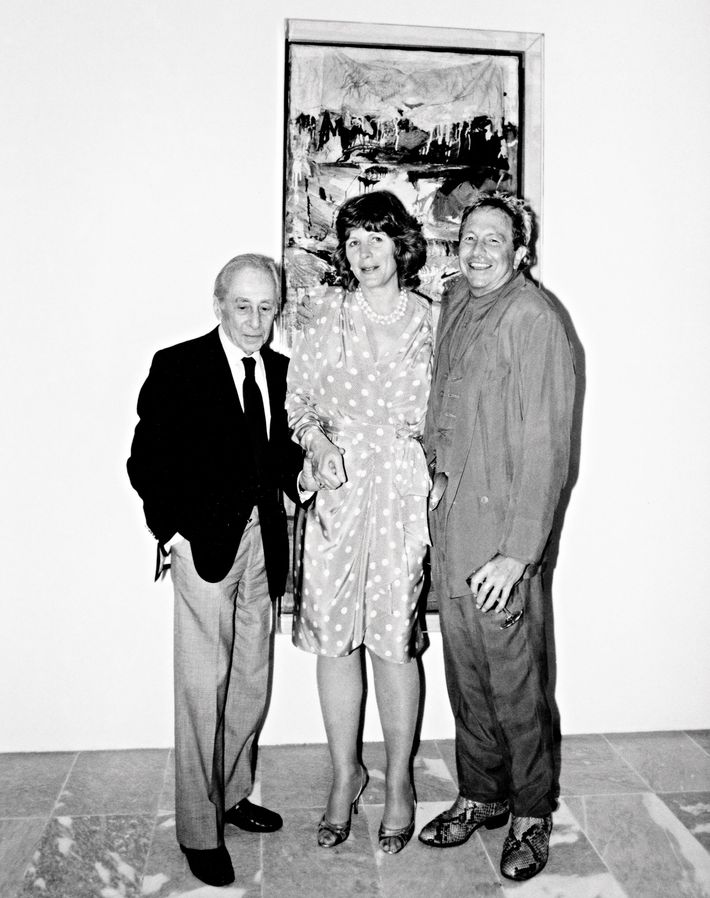
“How things are hung is so important. Once, at Brown University, we were up in a small faculty room and I was so taken by the fact that these pictures — they were by nobody of note — were set up where they weren’t straight against the wall. And when I got up to straighten them, nobody could believe I was so affected by it.
Now, at MoMA, I can tell somebody, “It’s a little askew.” But in somebody’s house, I really am tempted to do it, too. I don’t like things to not be as they should be. I think I started being like that because, when I was little, my father used to pick up rubbish off the street. For the first half a year I was living in New York, I would do it, too, until people would say, “Don’t pick up things! You never know what you might get on your hands.” It was like a painting askew. I still do it once in a while, but I have to be careful who’s with me so they don’t have a fit.
I just love the Rothko painting I have. Once, I wrote Rothko a letter to say how wonderful it was to take a nap in my living room when I was pregnant with my fourth child, because when I woke up, there was the Rothko, and it had been changed by the light. Well, he called me and said, “I am so glad to see your letter because Jasper [Johns] and Bob [Rauschenberg] are taking over the world.
Everyone wants to have them.” He later committed suicide, of course.
We see Jasper quite often. I once told him, “You’re so lucky, because you can use your art to express your feelings — whether you’re feeling dismal or feeling great — and I can’t do that and I wish I could. I’m very unartistic.” And he said, “Well, I’ve had a hard time in my life. Don’t take that as the reason that I can paint.” And I didn’t mean that at all. But I meant that he had an outlet, and I wish I did.
There are many more people collecting now. They don’t look at their works. They don’t loan them. They just store them to get a better price. I don’t think you should hold on to things so they grow. Not that I haven’t been well rewarded for doing so. But I would loan them for places where they could be seen. I wish I could do more. But I’m getting old.
—As told to Carl Swanson
My Snobs
“All this futzing over places that served terrible food!” Learning how power works.
By Rebecca Traister
When I was 25 years old and I interviewed for a job as a fact-checker, the boss asked me my SAT scores. Arthur Carter was a sculptor and a pioneer of the leveraged buyout; he was also the owner of the New York Observer, the salmon-colored weekly newspaper that at that point — it was 2000 — was best known for its coverage of New York real estate, media, and social gossip. It had been eight years since the test: I had been to college, waited tables and scooped ice cream, worked as the personal assistant to Harvey Keitel and as a secretary at Talk magazine; in none of these contexts had anyone spoken to me about my SAT scores. To be clear: I was not sweet Mae from the country, innocent of the connections and privileges that had landed me there. I knew, kind of. But I didn’t understand. And if I had wholly absorbed the degree to which the job I wanted him to hire me for would be to immerse myself in a hierarchy of status and fake merit, I might have run.
Very soon, I learned why it mattered in the magazine industry what table you occupied at Michael’s for lunch, or how close you were seated to the Newhouses at the Condé Nast holiday party, or who was at Elaine’s — all this futzing over places that served terrible food! I learned that for a period it was a very good thing to have your event at Lot 61, until its owner, Amy Sacco, opened Bungalow 8, at which point Lot 61 became déclassé. I learned that you wanted to list your apartment with Dolly Lenz and was taught, as I covered movie premieres, to stand and watch where the invited celebrities and movie executives sat in relation to the cast of the movie.
I didn’t write about politics back then, except as spectacle. Peter Kaplan, the paper’s legendary editor, himself had politics, cared about them very deeply, and ironically lived a quiet suburban life, eating canned tuna every day at lunch at a diner uptown, away from the status rituals he was so keen for us to map (though, in truth, his abstention was its own performance of power). But as I studied the Kremlinology of who stood where on what red carpets, I was learning not only the carpentry of journalism itself but that the power wielded within this small subset of painfully wealthy New Yorkers was built on structures, connections, access, and proximity. The same forces (if not the same specific signifiers) that social, racial, economic, and political inequality are built on and around today. I learned how to cover sexism, racism, and class bias — to see how it mattered whether you were in the room where it happened, and what the repercussions of being outside of it might be — by being forced to think about Lizzie Grubman.
I’d learn something else about power from the Observer in the years after I’d left it: that the old man who cared about his employees’ educational pedigrees but used his fortune to support a truly independent editorial enterprise was leveraging his influence in a far more original and moral way than would the young real-estate developer, Jared Kushner, who would buy the paper and try to bend it to serve his personal and political needs some years after I left, decreasing its value and its influence. Money and proximity to power, and the prestige that come with them, can get you a long distance in Manhattan. But what Carter understood, and Kushner certainly didn’t, was that trying too hard and too bluntly was to diminish their strength. Kushner’s was — to use the crude power-mapping skills I was taught to hone in my youth — a very Jersey view of power.
My Teacher
“I imagine you could see that I needed some stability.”
Sarah Paulson and the woman who got her through high school.

Beverly Lechner-Klein: Hello?
Sarah Paulson: Hi! How are you? I wonder if our memories of meeting for the first time are the same. There was this program you ran: Students were supposed to meet with their mentor once a week. You’d have dinner, do something cultural. I always wonder why the head of the drama department recommended me. At that time, I weirdly think it was Mr. Cappelletti.
BL-K: It was not Mr. Cappelletti.
SP: It wasn’t?
BL-K: No, it was Ms. Ferbel. Mr. Cappelletti … I shouldn’t say this out loud, but he wouldn’t have had the sensibility.
SP: I never knew. I didn’t understand what they would have seen in me at the time or what they thought I needed. But anyway, I went up to your office. You were in the math department, and math was one of my biggest limitations, I’m sorry to report. I, of course, in my 16-year-old way, didn’t want to do it. I was self-interested, and I wanted to act and read plays and go to the park and not go to my math class. One of the things I’ll always be grateful for was that you saw that, and instead of saying, “Well, that seems like a minefield,” you leapt toward it. That’s when you introduced me to Robyn Goodman, who was one of the co-founders of the Second Stage Theater in New York. I was — I wouldn’t say wayward, but I didn’t have a great sense of parental security. I imagine you could see that I needed some stability.
BL-K: You were determined, and you could stand up for yourself when you were very young in a way that I always respected.
SP: Ooooh, ooooh [singing], that’s the song you sing when you try not to cry … Eeeee-ah.
My Fares
“She sees her pimp and he jumps in the cab.” The people Joseph Rodriguez saw through the windshield. Portfolio by Joseph Rodriguez
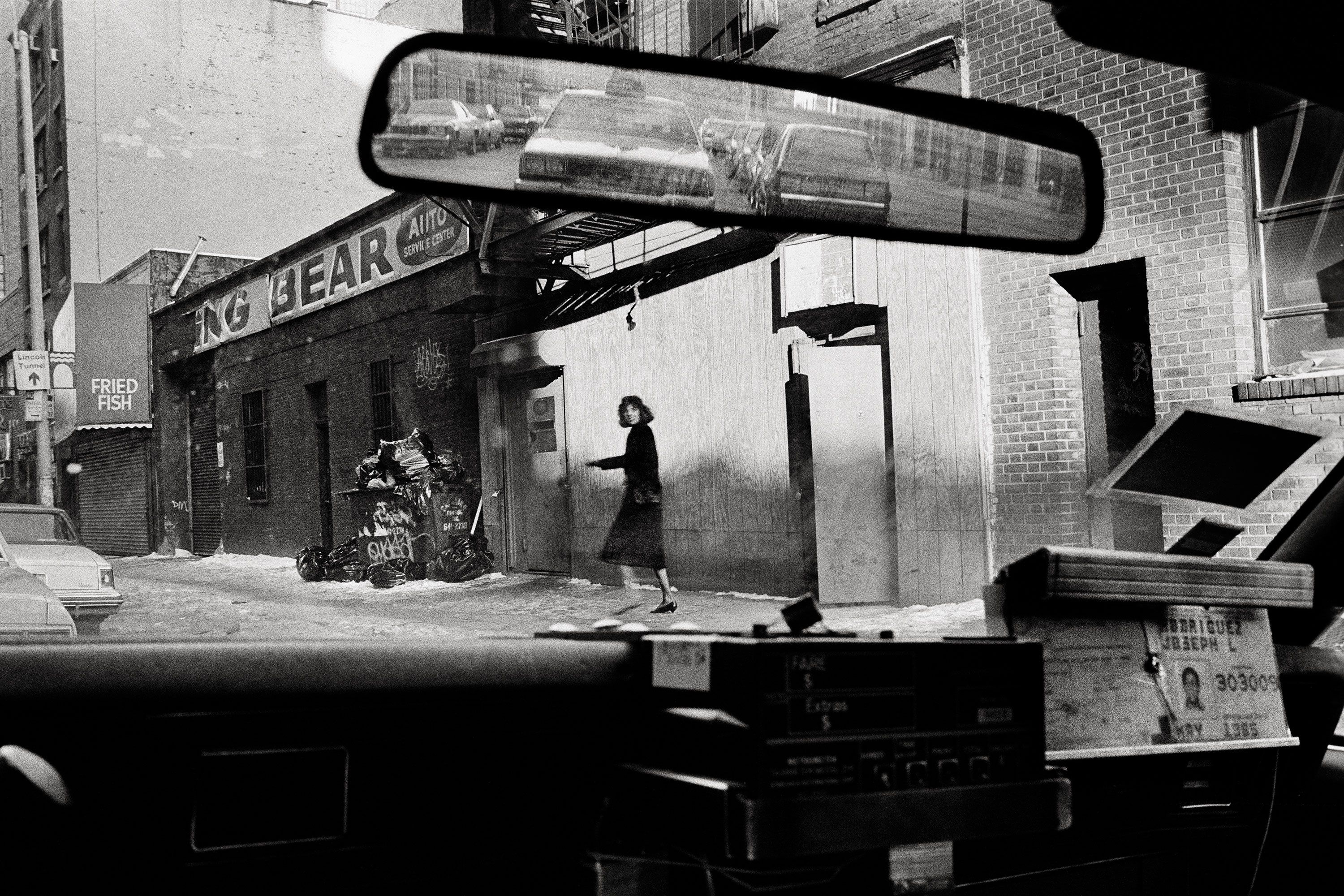
Rodriguez drove a cab from 1977 to 1985, and in the last two of those years, he was studying to be a photographer. He lost his first set of gear in a classic ’70s New York stabbing and mugging, but with a new camera, he documented what he saw on the job.
—As told to Jada Yuan
My Marden
“Jesus, I’ve got to pay for this thing now.”
Larry Gagosian on the painting that got him a loft that got him a gallery.
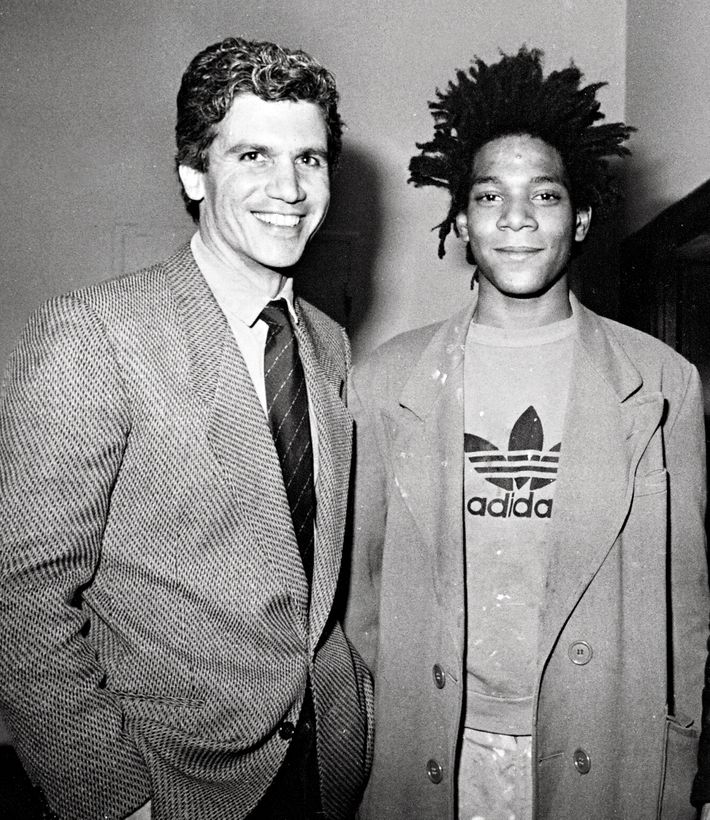
“I started my business in L.A. around 1977. It wasn’t even a gallery; it was more of a poster shop. I started traveling to New York fairly regularly because it was clear that New York was the center of the art world and I would have to spend time there if I wanted to grow my business. But also I fell in love with the city. I was enchanted and stimulated by the energy. I met Leo Castelli because I had done a small show with a photographer named Ralph Gibson who had a studio on West Broadway. He was represented by Castelli, which I didn’t even know when I’d first reached out to him. I just liked his work.
I wasn’t really ready to do major business, but I guess you could say I was aggressive and I started doing deals. I would come stay at the Stanhope Hotel because I knew a manager — he happened to be an Armenian guy, and I’m Armenian, so he gave me a really special rate for a broom closet of a room — $40 a night! — but I was spending most of my time in Soho, which was just emerging. One day, one of the guys who I was working with who owned an art-shipping company said, “We’re developing this loft building on West Broadway, and there’s one left.” I’d never considered buying a loft here, but there I was with this guy, and he pointed to the fifth floor of this six-floor building right across from Leo Castelli and he said, “If you want to buy it, tell us right now.” I said, “I’ll take it.” It was $40,000, which I didn’t even have in my bank account. And then I said, “Jesus, I’ve got to pay for this thing now.” I said, “I’ve got this Brice Marden painting. Would you be interested in trading for the loft?” It was called For Otis, about Otis Redding, and they said, “Okay, we’ll do the deal.” So I gave them the painting and I got the loft.
Peter Marino, who recently did my home on the Upper East Side with Annabelle Selldorf but who I didn’t know from Adam at that time, was doing another loft in the building for a very important, successful diamond dealer named Ara Arslanian, who is another Armenian friend of mine. I said to Peter, “I don’t have much money, but would you help me with my loft?” Peter looked like a different person back then, Brooks Brothers suit, very bookish-looking. I think I traded him a Twombly drawing for his services.
So I built this loft, and I started doing shows there, and the building freaked out. They said too many people are coming up and down the elevator. They were right. I’d have an opening with 300 people, and we’d go till four in the morning, and if I lived there, I wouldn’t have been happy either. A few years later I was standing on West Broadway in front of my loft with Peder Bonnier, who’s a friend of mine, and he said, “Larry, I’m going to rent an office for my art dealing. Want to go take a look at it with me?” So I got in the car, drove over to West 23rd Street between Tenth and Eleventh, and he went up there to seal the deal with Sandro Chia, who owned the building and was a very successful artist at the time.
I’d never been to Chelsea before that. There were no galleries, and there were crack vials all over the sidewalk. It was a rough neighborhood with a lot of prostitutes: At night, they’d chase you down the block if you had a nice car. But in Sandro’s building I noticed there was a truck dock on the ground floor. I said to him, “What are you doing with the truck dock?” He said, “I want to rent it.” I said, “What are you asking?” He said, “I want $3K a month,” and I said, “I’ll take it.”
Now, until that moment, it hadn’t crossed my mind to actually have a proper gallery in New York. I had my gallery in L.A., I’d had my loft thing in New York. I was doing well in L.A. And this became the beginning of my career as an art dealer.
—As told to Amy Larocca
My Sewing Circle
“I said to her, ‘Are you like the Bruce Springsteen of knitting?’ And she said, ‘No, but I’m like Sting.’ ”
Once a month, Maira Kalman, Rosanne Cash, and friends meet for a stitch ’n’ bitch.
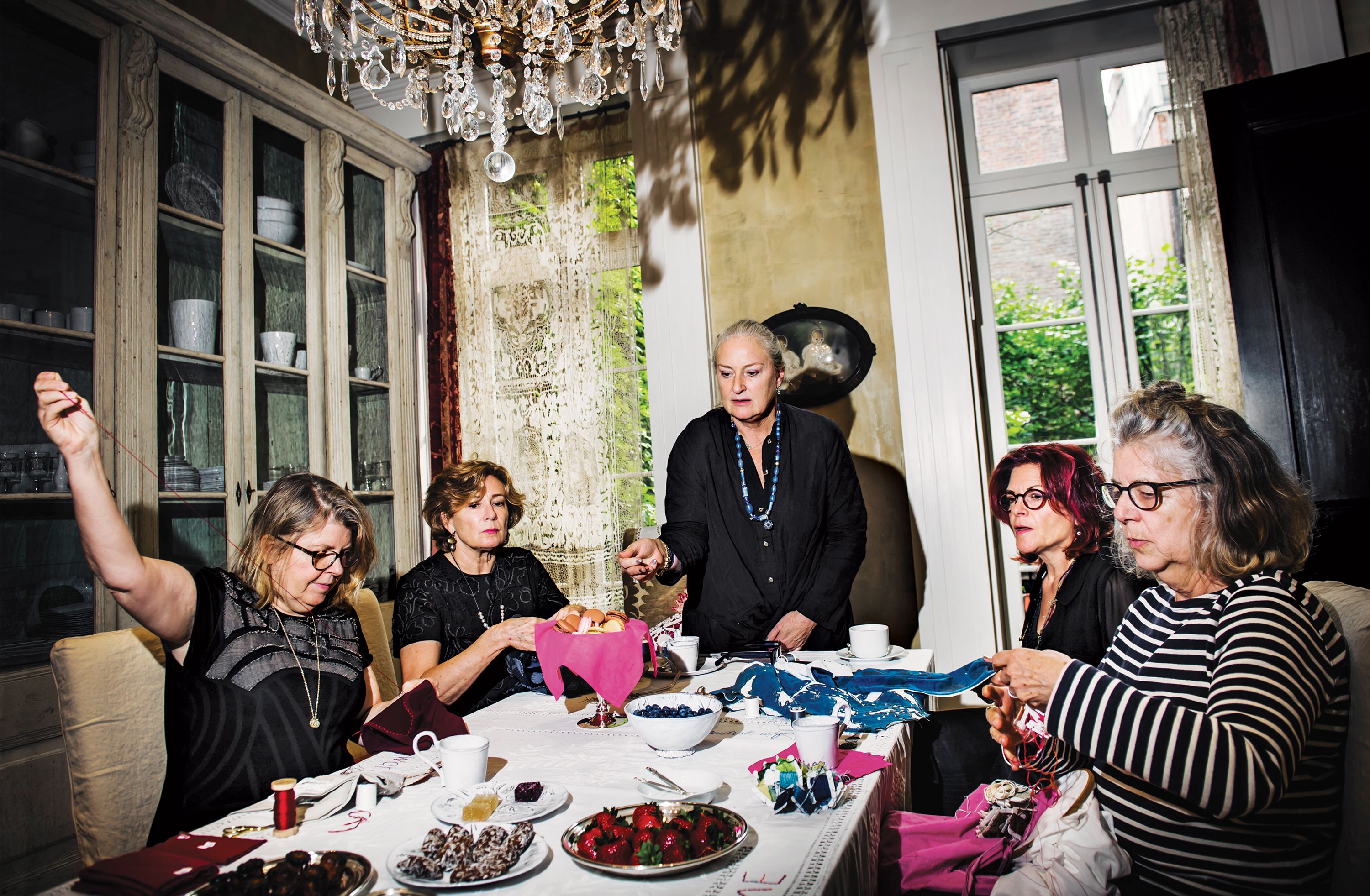
Rosanne Cash, musician: I’m the worst seamstress in the group.
Lisa Fox, philanthropist: No, that’s not true; I am.
RC: Kay is the best.
Gael Towey, documentarian: And Maira!
LF: I’d say Gael’s pretty good.
Maira Kalman, author-illustrator: But I wouldn’t begin to do your stitching stuff, because I’d go insane.
LF: In the knitting world, Kay is like … Elvis.
RC: When I met Kay, I said to her, “Are you like the Bruce Springsteen of knitting?” And she said, “No, but I’m like Sting.” Kay and I met on Twitter.
LF: Oh my God. Who picked up who?
RC: I picked up her!
LF: Oh, Twitter, not like Tinder?
RC: No, Jesus Christ, Lisa. I wanted to learn to knit, and she said, “Of course you can.” I said, “Meet me at this macaron place on 23rd Street.”
LF: Oh my God, I love this.
RC: And I sat down with her, and she was so sweet.
LF: Can you remember what you wore?
Kay Gardiner, former federal prosecutor: I’m sure it was black Eileen Fisher, like every other day of my life.
RC: So I said, “We’ve got to bring Kay in.” But now it’s just us; we don’t accept visitors.
LF: Sometimes I get excited and invite other people, and I can feel the tension, and I’m like, Damn.
RC: Everybody asks to join. I always ignore it when they ask. This got us through the election. Didn’t we meet the day after? It was sitting shiva.
KG: There’s something different about this — I mean, sometimes we go out and eat and drink — but with this, you don’t have to be interesting, it’s just being.
—As told to Margaret Rhodes
My Salesman
“I did not need a new toothbrush, as far as I knew.” If only she hadn’t declined the Fuller Brush man.
By Lydia Davis
In my last year of college and for some months after I graduated, I lived in an apartment on West 107th Street, just east of Broadway. I had various roommates in different combinations, and a parakeet. I first went out to work from that apartment. My starting job was with a temp agency, which I quite enjoyed because of its variety — a different place every week or two — and because the work was generally easy, if tedious, like putting files in alphabetical order in a windowless basement room. After a while, I was hired at W. W. Norton & Co. as an editorial assistant. I played chess with my boss at lunchtime, and typed letters from a Dictaphone.
It was on the doorsill of that apartment that I had an encounter with a Fuller Brush man. The Fuller Brush man was a highly respectable sort of door-to-door salesman who offered a well-made specialized product — Fuller brushes of all kinds.
My apartment doorbell rang one day, I opened, and there, in the dimly lit hallway, was the Fuller Brush man. He was dressed in a rather funerary suit and had just set down his case full of larger brush samples and smaller brushes for sale. He greeted me soberly, identified himself, and then, consulting a notebook, told me that on his last round in my neighborhood I had bought from him a toothbrush. He suggested that I might be interested in buying another toothbrush now.
Face to face with him, I did not have time to think. I was sure he was right, that I had previously bought a toothbrush. But just now, I did not need a new toothbrush, as far as I knew. And so, quickly, I thanked him but declined the toothbrush. In my memory of the encounter, he simply nodded, put away his notebook, picked up his case, said good-bye, and left.
This was all — and yet, maybe in part because he was so quiet and matter-of-fact in his acceptance of my refusal, I have been haunted all these years by the scene. The regret that I feel probably began within minutes of his leaving.
It would have been so easy simply to buy a toothbrush, whether I needed it just then or not. The transaction would have been so modest. The preparation for it had involved, on his part, meticulous, if habitual, record-keeping and a plan to include me in his rounds that day. He could expect that a potential customer who had already bought a Fuller brush was more likely to buy another.
Perhaps I was startled that I, and my previous purchase, had been in his notebook, and in his business expectations. I was not yet a steady person, with steady employment and a permanent address. The parakeet would one day fly out a window, my small television would be taken out through another window by someone coming up the fire escape, and I would soon be far away, too. But in his notebook, I was expected to be in the same place; he was endowing me with a life of some predictability, in which I might say to myself it was time to buy another toothbrush, and wait for him to come by.
My Missing Person
“I know more about this kid than most people know about their own children.”
A cop and the case he never solved.
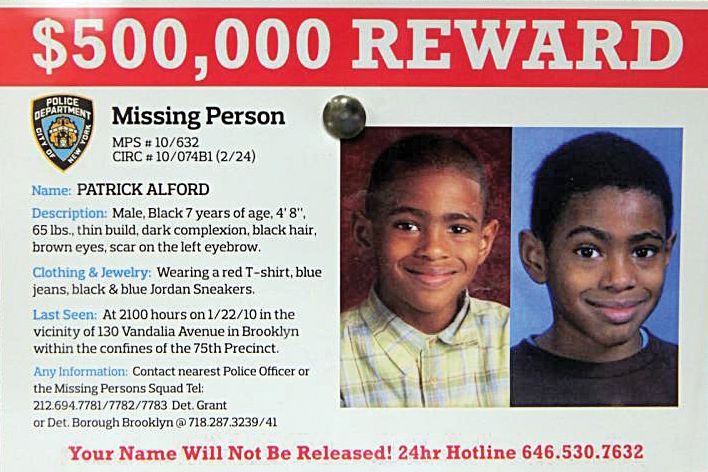
Lieutenant Chris Zimmerman: Patrick was taking out the trash with his foster mother when he went missing in 2010 from the 75th Precinct in Brooklyn. They were in a hallway and she turned around and he was gone.
He didn’t have the correct clothing on for the month of January. They were searching buildings, searching parks, using bloodhounds. Thousands and thousands of people were interviewed. We pulled credit-card receipts from gas stations to see who got gas that night. We weren’t looking at these people like criminals; we were just asking, “Hey, listen. Did you see this kid?”
There was a kid in Brooklyn who was seen in a McDonald’s. He looked like him, but Patrick had a unique scar on his left eyebrow that this kid did not have.
The concern was that when Patrick hits puberty — and he probably already has, he’s 14 now — that he would become hairier, you wouldn’t be able to see it. The one thing he does have is very protruding ears that he will not be able to hide. I know more about this kid than most people know about their own children.
I was driving with my son in Brooklyn one day, coming past Pennsylvania Avenue, a couple years later. My son goes, “Hey, Dad, isn’t this where Patrick went missing?” I looked at him like, How do you know that?
—As told to James D. Walsh
My Cub
“I think you still deserve to be in theater.”
The current Young Simba meets the original.
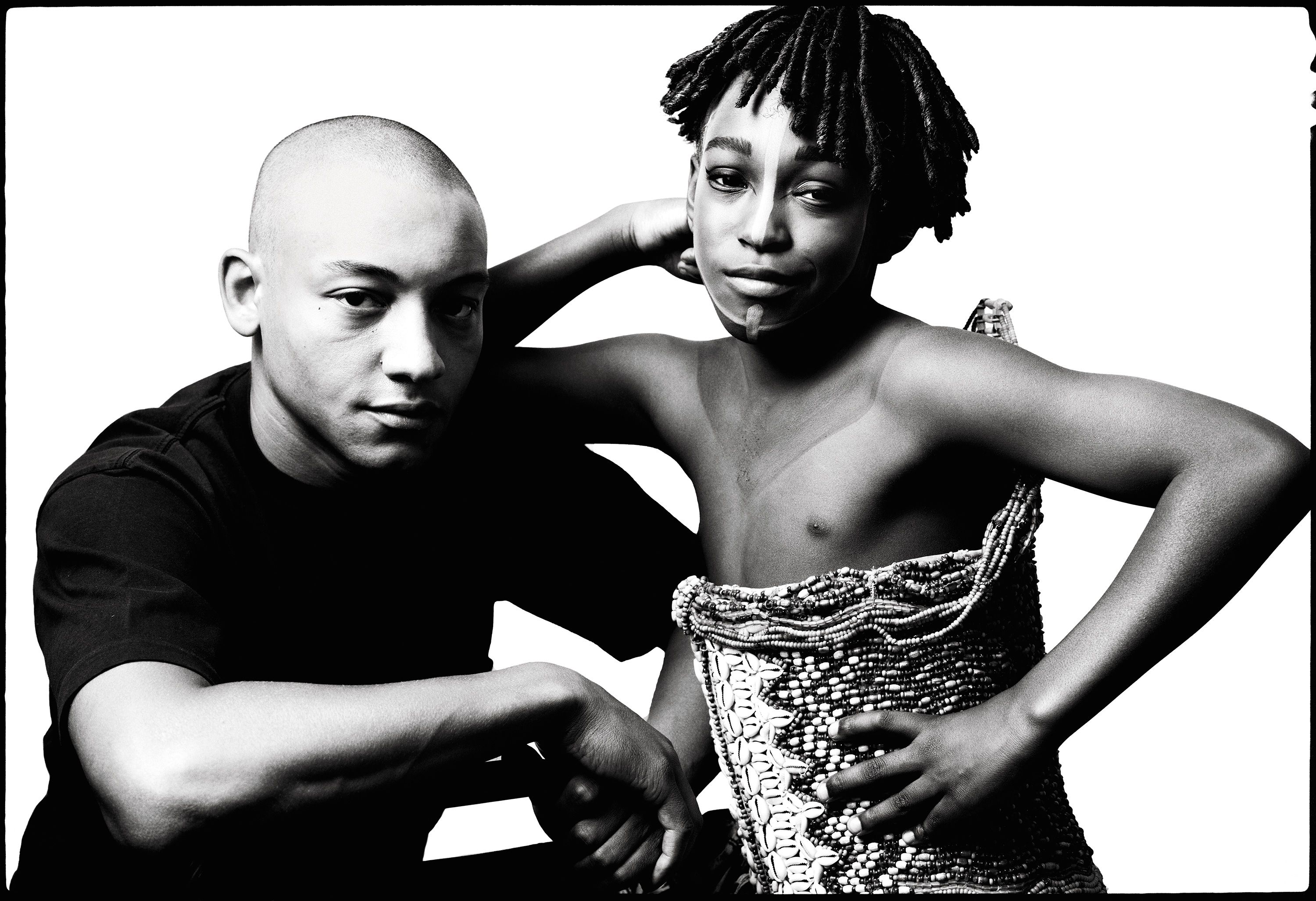
The Lion King opened on November 13, 1997, and has been more or less sold out at the box office ever since. To mark the show’s 20th birthday, Joshua Dubose (who’s just turning 11 and plays Young Simba in four shows a week), met with the original lion cub, Scott Irby-Ranniar (who is 33 and working as a sales rep for an auto distributor). At the Minskoff Theatre, they discussed life on Pride Rock.
Joshua Dubose: I did little things in school back in Atlanta — dance and performing arts. I got bullied for that, so it was kinda hard. For The Lion King, we drove to the auditions in Atlanta.
Scott Irby-Ranniar: Did you have to sing?
JD: Yeah — “I Just Can’t Wait to Be King.”
SI-R: Which you already knew, I’m assuming. I sang “Just Can’t Wait to Be King” and a Jackson 5 song at my audition. I’d been in an after-school program that did plays, and they did a word-for-word adaptation of the film of The Lion King — and I was Simba! So, you know, I auditioned well.
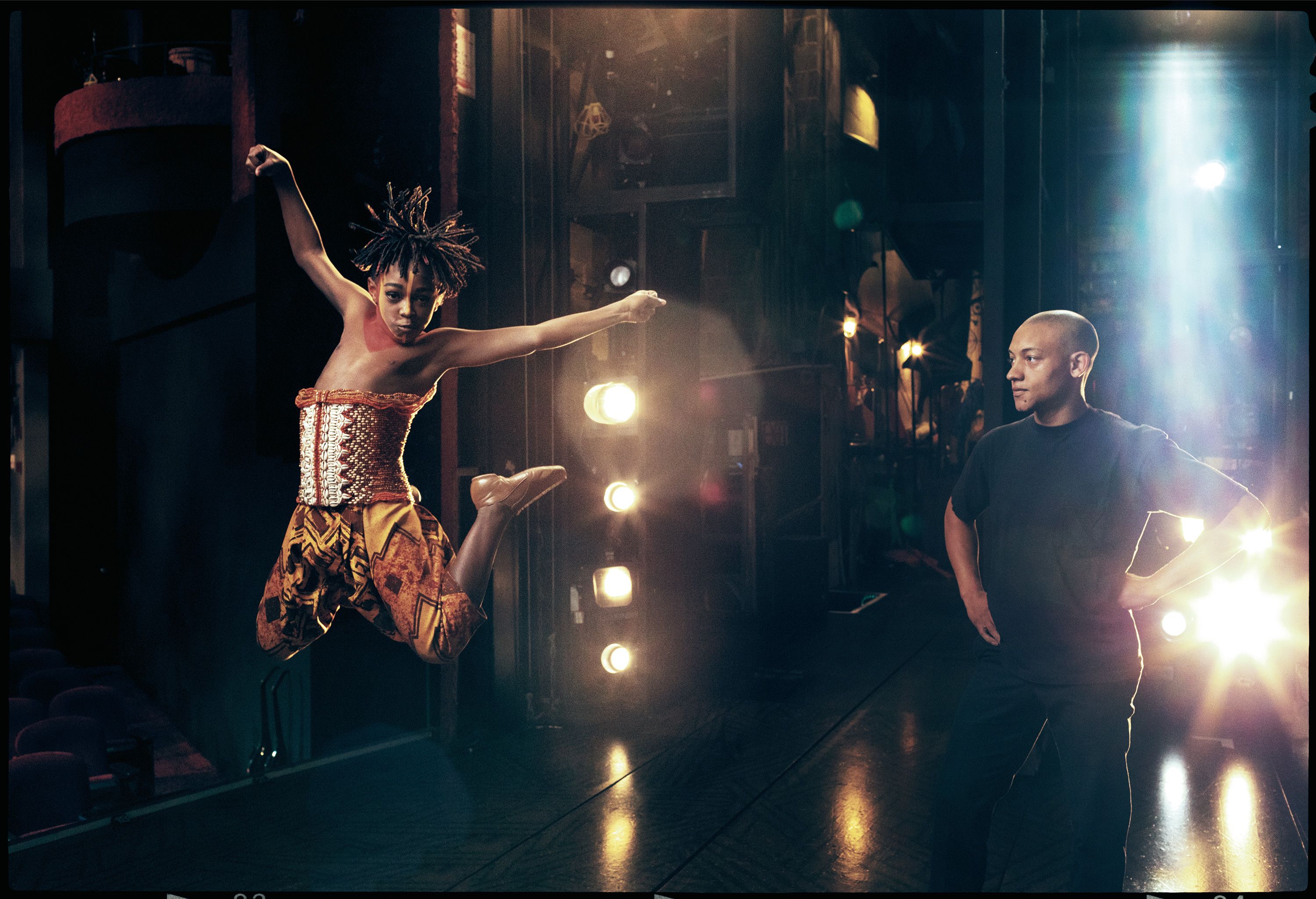
JD: And my mom told me that I got the part, so we came all the way here. It was hard for us to find an apartment and a school, because they don’t help us.
SI-R: I was in middle school at the time, and then we would perform at night. [But] I knew at a very young age that acting wasn’t something I always wanted to aspire to, because it was so inconsistent.
JD: I think that you have a great personality, and I think you still deserve to be in theater.
SI-R: He has advice for me! Okay, all right — that’s nice.
JD: I think you’ll probably be called for a movie or to be on a TV show.
—As told to Jackson McHenry
My Son
“Digby had a bar mitzvah. It was quite an affair.”
The couple and their boy.
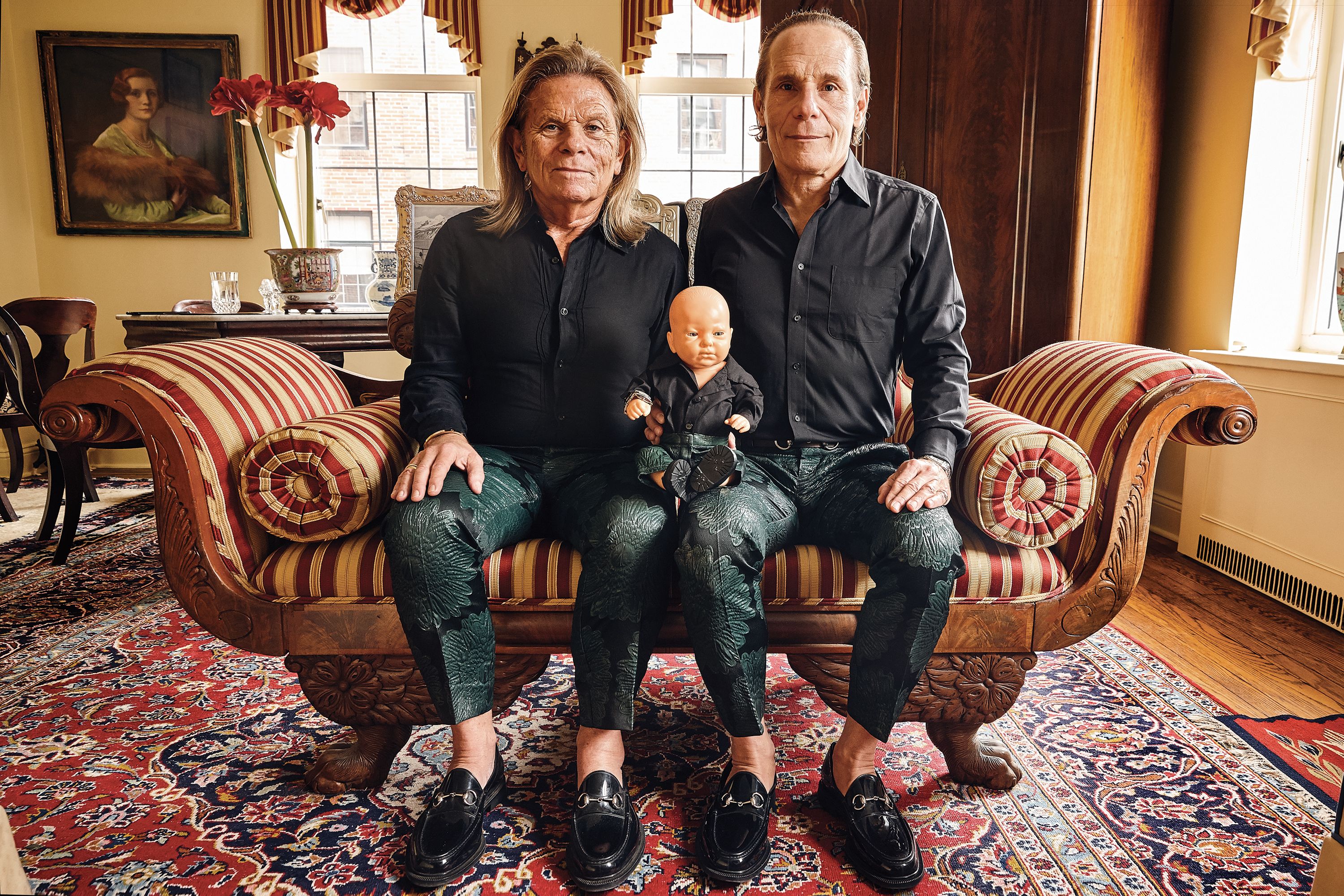
Mark Kirby, retired dentist: Do you know the concept of Digby? When we got him, a number of our straight friends had started having children.
AJ Sapolnick, retired teacher: It was really annoying.
MK: Your friendships with people change dramatically when they have children. Our friends couldn’t be spontaneous. AJ said, “I can’t stand this anymore. We’re gonna have a baby, too, and we’re gonna have a baby that will not change our lifestyle.” That’s why we wanted a doll. We wanted a perfect child.
AJS: That was 1990.
MK: We were in Paris and we went to a flea market. I was drawn to a cardboard box — and there Digby was. I paid $7 for him.
AJS: He’s been with us ever since. In New York, people don’t even pay him any attention. If we travel, on a tour or a cruise, the first day people think he’s very strange, but by the second they can’t wait to see what he’s wearing. It’s very rare that people aren’t accepting of him.
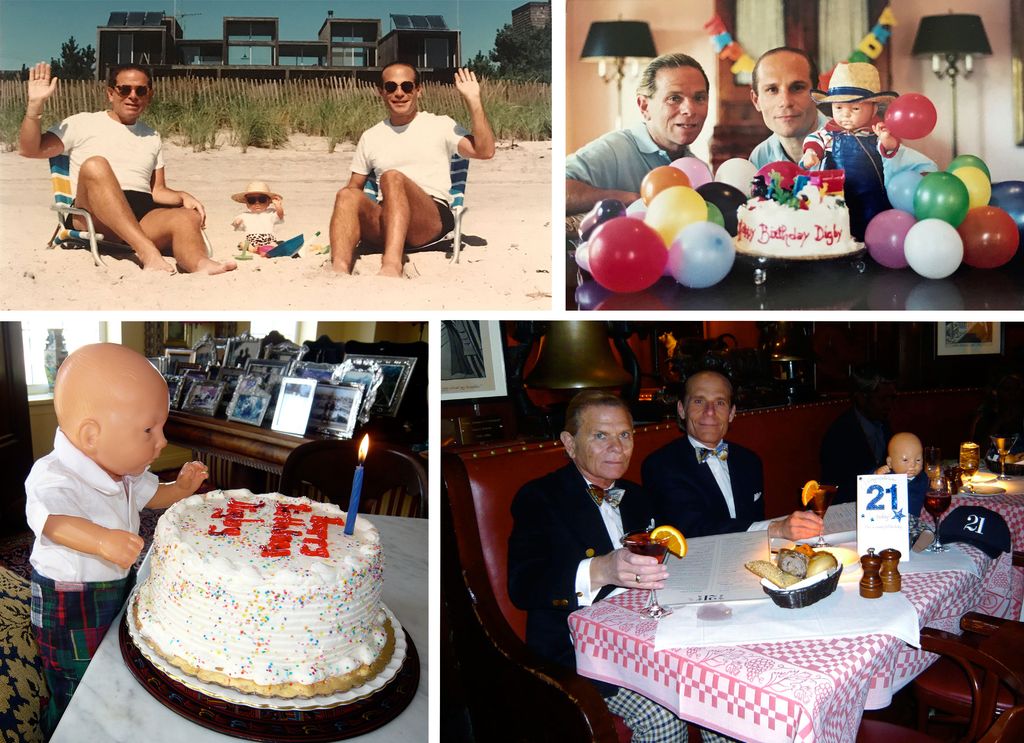
MK: When he was little, he used to go around with us more often. He’s older now, so he has his own life. I can see changes in Digby over the years, in his expression.
AJS: He had a bar mitzvah. It was quite an affair. We never had a discussion about how involved he’d be in our lives. Mark and I just have shared values, I guess. We like the security of a family and a relationship.
MK: We’ve been monogamous the whole time we’ve been together, which is very unusual for gay people.
AJS: The world is so different than when we first met. Now adoption and surrogacy are realistic for a gay couple, but that wasn’t even in the realm of possibility back then.
MK: Some people don’t get our family. But you know what? It’s amazing how many people do get it.
—As told to David Marchese
My Demo Team
“My name will be known.”
Harry Macklowe on his education.
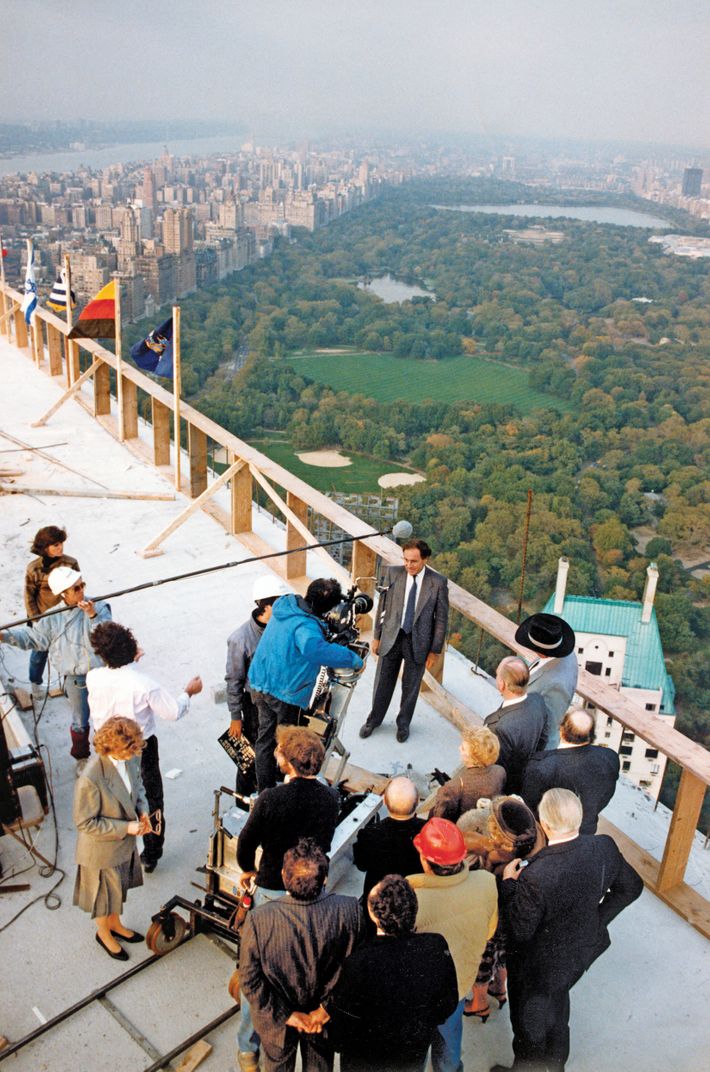
“My father was in the textile business, and so I had no experience in real estate. In 1959, I’d taken an apartment on 78th between First and Second, in Yorkville. I had a duplex, the ground floor, and the garden. I met this guy who was buying 25-foot-wide tenements and cutting them into four pieces, which substantially increased the occupancy. The city had a regulation where if you substantially increased the occupancy of a building, you could get possession of the rent-controlled and rent-regulated apartments. I admired what he was doing, and I said to him, “Real estate, it seems so exciting. I’d like to work in real estate.” And he said, “Nah, nah, you can’t. I don’t have the money to pay you.” I told him I’d work for no money. I don’t mind. I just want to learn. But we remained friendly, and I got a job as a broker and was able to start to invest.
The first building I bought, with a group of friends, was on 28th Street between Madison and Park Avenues. It was a loft building, 12 stories and 50 feet wide, but for me it was glorious, as big as the Empire State. This was 1960, ’61. I was going to take the dollar-and-a-half-a-foot rent and take it up to $4 a square foot. I was going to make it into a tertiary office building. I needed to demolish the walls to get it in a condition to offer it to brokers and office tenants. I had a station wagon, and I went down to the Bowery and asked some guys, “Do you want some work?” And I got six guys to pile into the car. I’d bought five-pound and ten-pound sledgehammers and laundry baskets, and I said, “You guys go take down these walls on these floors.” So they came to me at lunchtime and said, “Mr. Boss, we want to have lunch but don’t have much money. Could you pay us our wages now?” And I said of course. And they never came back. And that’s when I realized I couldn’t do it all myself.
Because of the buildings I’ve made, my name will be known at least a little while after I’m not here. With 432 [Park Avenue, a 1,396-foot-tall condo tower] I left a mark on the skyline. People actually talk to me as if I am a celebrity because of it. They tell me, “I follow your work.” When I showed Renzo Piano 432 Park, he told me, “I admire the building very much, Harry. You cannot fuck up a square.”
—As told to Carl Swanson
My Sharks
“Like a kind of ‘Santa Claus’ ” One very ordinary, very small insider-trading network.
By Jessica Pressler
“You’re going to have to learn about Wall Street,” a wise friend warned when I first started working at New York Magazine in late 2007, when the industry was high out of its mind on mortgage-backed securities. New in town, with nary a clue where to begin, my first step was, naturally, to watch the movie Wall Street. (To be fair, I also tried reading The Intelligent Investor but fell asleep, repeatedly.) A few months later, after the market collapsed, the world of Oliver Stone’s movie — with its giant cell phones and trading in actual, tangible products — seemed remarkably quaint. Which is probably why Stone felt compelled to make his ill-advised sequel in 2010. Which he needn’t have — really, he needn’t — because watching the original again after a decade of covering people in the financial industry, I realized that everything you need to know about Wall Street, as a concept, is in there. The technology has changed, but the people are the same — as evidenced by the fact that the same shit keeps happening. Like insider trading. The vast majority of insider-trader scams don’t involve big shots like Gordon Gekko. They’re conducted by ordinary, even decent people who, presented with an opportunity for easy money, find it difficult to say no. Take, for instance, the recent case of Daniel Rivas, a 32-year-old Bronx native. Rivas used his job as a technology consultant at Bank of America to access proprietary information from the bank’s deals system, then generously passed it on to a network of friends, like a kind of “Santa Claus,” as the Times put it after Rivas pleaded guilty to fathering three concentric insider-trading rings in New York, Miami, and San Francisco. Five of his tipees were arrested, and while their legal fate remains up in the air, one has pleaded guilty: Rivas’s girlfriend’s father, a 60-year-old Wall Street veteran who should have known better. Then again: “The main thing about money, Bud,” Hal Holbrook’s wise and weary trader warns, “is that it makes you do things you don’t want to do.”
Trading Ring One
Rivas started dating a price reporter at financial-services company Tullett Prebon in 2013, then got to know her father, James Moodhe, who also worked there.
As the bank’s assistant controller and a Wall Street veteran, Moodhe, was certainly aware that trading on the tip his daughter’s boyfriend gave him about the impending acquisition of a pharmaceutical-research company violated securities laws. But apparently he couldn’t help it, because a he placed a large bet on its stock.
Soon after, Dan and Moodhe’s daughter moved in together. Like many young couples in love, Dan would sometimes slip his girlfriend notes in the morning, which, according to the Feds, contained sexy stuff like “information about confidential impending deals, including ticker symbols, deal values, and expected announcement dates.” Moodhe’s daughter, who has not been charged, passed those along.
Moodhe’s growing bank accounts must have also put him in the Christmas spirit, because, in early 2015, he allegedly confided to Michael Siva, a 55-year-old financial adviser at Morgan Stanley and a friend of Moodhe’s for more than 20 years, that he had an “imaginary friend” who had been helping him out with investments. From then on, according to the charges, Moodhe passed the tips along to Siva, who executed trades on behalf of himself, his wife, and clients of Morgan Stanley.
Trading Ring Two
Roberto Rodriguez grew up with Rivas in New York — “a good boy,” his father puts it, who served in the Army, then moved to Miami, where he earned two degrees and got a job as an executive at a tutoring company. But he was struggling financially, as Rivas noticed on a trip to Vegas, according to the SEC, so Rivas offered him some help. But apparently Rodriguez didn’t know how to open a brokerage account, so he reached out to someone he knew was smart: Rudy Sablon, 37, a fellow executive at the tutoring company. An upstanding member of the community, Sablon taught in inner-city schools and worked at a nonprofit to help at-risk children. He also was a single parent, which might be why Sablon, who “had never traded before in his life,” according to a source, agreed to go in on the scheme. Over messaging apps, Rivas walked them through call options and tender offers, and soon they were rolling in it, making what authorities estimate to be $2 million.
They in turn shared the tips with the owner of the tutoring company. The owner, who was not charged, was also a trading novice but began realizing “exceptional returns” immediately.
Trading Ring Three
Meanwhile, another childhood friend, Jhonatan Zoquier, a fitness buff and union representative out in New Jersey, was having trouble pulling together the cash for an engagement ring. According to the Feds, Rivas sprang for it, then offered to make Zoquier a party to his information. Being ignorant of markets, Zoquier was hesitant to do the trades himself. But he knew a guy: Jeffrey Rogiers, 33, who had grown up in the Bronx, graduated from RIT, and was now out in the Valley, working as a software engineer. But the tips from Rivas, passed to Rogiers by Zoquier, proved even more fruitful. Ultimately, Rogiers made more than $50,000, according to authorities, who also say that Rogiers subsequently shared information from Rivas with two former co-workers, one of whom made $280,000, the other $130,000.
My Grade
“You can never talk about our parties in school, even on Friday during last period.”
The St. Ann’s juniors who spend their nights listening to disco and eating lumberjack breakfasts.
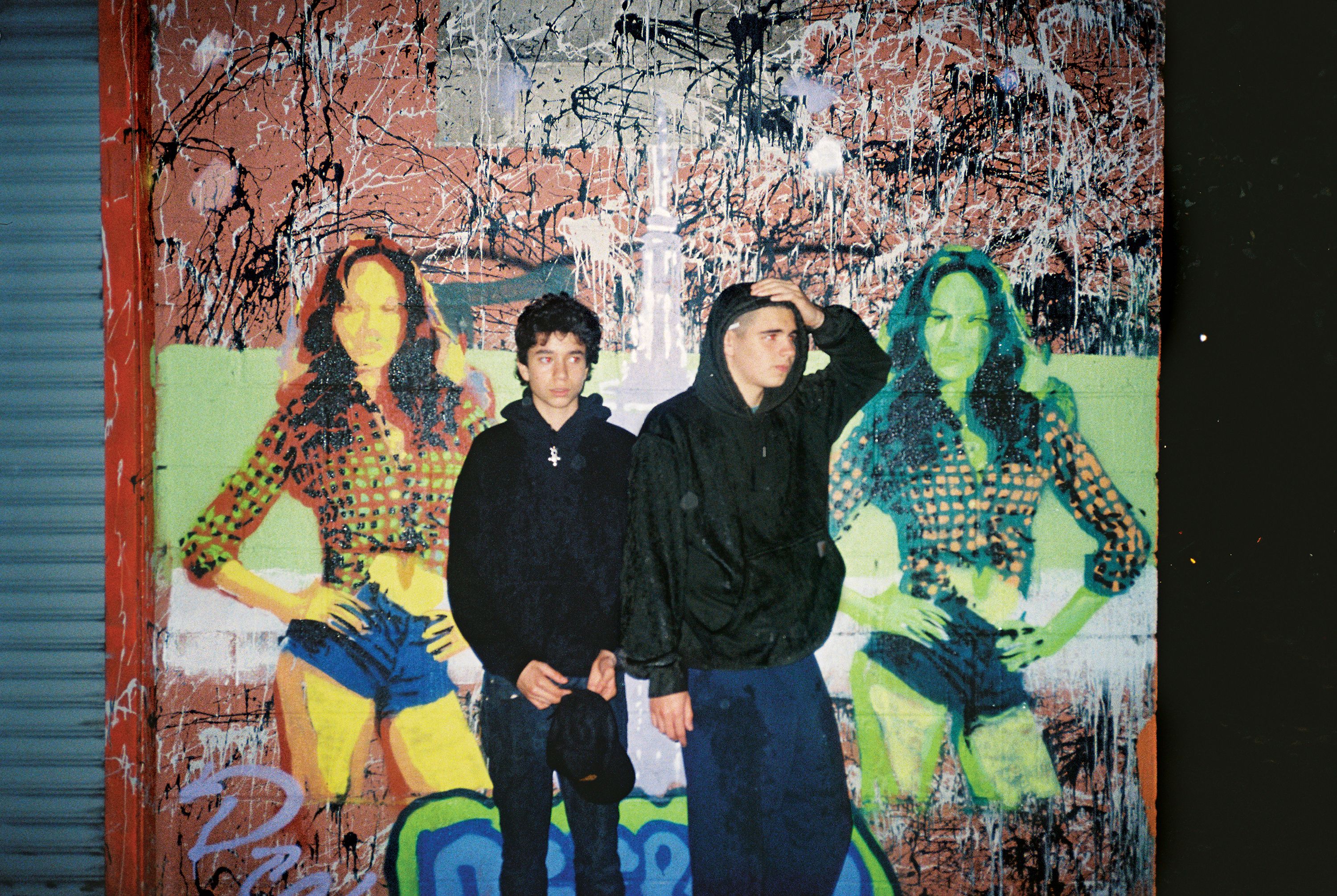
Jonas Bardin: I don’t usually have a lot of people over, but I’ve been doing a really good job of cleaning up, so my mom is letting it happen more often.
Simon Lieber: You can never talk about our parties in school, even on Friday during last period. If you talk about it, you’re going to end up with 70 people at your house.
Jonas: People are really thirsty for parties.
Simon: There’s ticketed parties where people rent a space, and most of the high school goes to that.
Jonas: Like Hallobash, which was at this Chinatown ballroom.
Ella Lungstrum: It’s kind of like a bar mitzvah.
Simon: No, it is a bar mitzvah, but there’s people hooking up all over the walls.
Diana McCready: I met this girl Chloe at the Hallobash party last year, and then I ended up seeing her at the Women’s March.
Roen Guerin: Sometimes the train and walking through the park and talking to random people is more fun than the actual party.
Jonas: Sometimes it’s just intense inside. There’s a lot of people, and I find it depressing when it’s just beer cans and beer pong.
Ella: A lot of times, there’s no after-party, so people will go to this kind of busted diner in Brooklyn Heights called Happy Days Diner.
Jonas: I literally get whatever it’s called — lumberjack breakfast, full-farm-home whatever. I don’t care. I go to Roen’s house at least once a weekend.
Simon: Me and Jonas, we listen to disco.
Jonas: Like Donna Summer over and over again. But mostly what gets played at parties is —
In unison: Trap.
Jonas: Unless I take the aux. I like playing classic pop hits, like an older Rihanna song.
Diana: All of Snoop Dogg’s old albums are so lit. I feel like our generation has a lit appreciation for older music. But that might be a St. Ann’s thing.
Simon: It’s not.
Ella: It’s a New York City thing.
Diana: Like if you go to a party in suburban Connecticut, they’re going to play freaking Alessia Cara.
Jonas: What’s Alessia Cara?
Diana: Exactly.
—As told to Margaret Rhodes
My Missed Connection
“Even then we didn’t kiss.” The aftershocks of a nonevent.
By André Aciman
It must have been around mid-January, during one of those long winter breaks. I had run into her in the corridors of Lehman College in the Bronx, and, with nothing to do, we decided to take the downtown Broadway local from 225th Street. She said she had to drop something at home; I did too. She said she wanted to pick up a blouse she’d had altered somewhere on Broadway and 93rd Street. I said this was close to where I lived with my parents.
We stopped by her mother’s apartment on Fort Washington and 161st Street; she fed her cat, took some clothing off because it was getting warm inside, then she played some music. We sat on the rug in the living room, facing each other, close but not close enough, listening to Santana and Abbey Road. Eventually we had to go, she said. We took the subway to my parents’ home, where I wanted to drop next semester’s books. The super saw us walk into the building, winked at me; I pretended not to notice. When we opened the door to the apartment, she said she was thirsty and wanted a glass of water. I gave her a glass of water. I wanted to kiss her then, but I wasn’t sure it was what she wanted. I showed her my bed, which was still undone, and she sat on it, and I still wasn’t sure. Then she stood up and went over to my desk and looked at my things. She admired my pens. She said she liked my Pelikan, so I gave it to her. Then we left and walked down Broadway, where we eventually found a place to munch on something. But we were moody, and we ate without joy. When I took her back home that evening, even then we didn’t kiss. She wasn’t happy with the way the blouse was altered. Plus it was cold, and New York was so dirty.
Without giving any loud signals, my life took a turn that day from which it never recovered. Something happened — or didn’t happen — that made her stop seeing me. She said she would call, but she never did and, soon, I stopped calling as well. I never again attempted anything with girls I felt drawn to. Instead, they did. Every time I felt deeply attracted to a woman, I would find myself playing out the scenes in our parents’ homes. The carpet, the music, the glass of water, the undone bed, and the excruciating urge to kiss, coupled with an equally excruciating dose of self-hatred for failing to dare. Life may alter the décor and the women each time, but the scene is invariably the same.
My Andy
“He, no doubt, was attracted to the handsome Princeton boy I was.”
Exposed by Warhol’s diary.
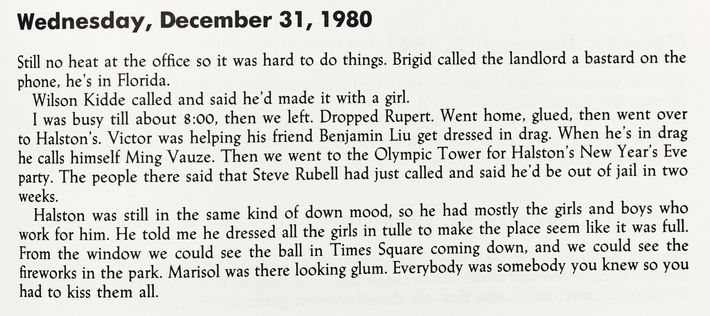
Between 1979 and 1981, Andy Warhol and I were close friends. We’d been introduced by the irrepressible Henry Geldzahler, then the commissioner of cultural affairs under Ed Koch. We attended parties, openings, and the famous Factory lunches, and we spoke often on the phone. I was flattered by Andy’s attention and conversation, and he, no doubt, was attracted to the handsome Princeton boy I was. When his diaries were published posthumously, I was mentioned in them five times. But one entry had the greatest impact: December 31, 1980. In it, Andy wrote, “Wilson Kidde called and said he’d made it with a girl.” This would have been unremarkable to record for posterity — had Andy not known that I was gay. Lots of people knew that, of course, but not everyone.
I recall another detail from that telephone call, one not recorded in the diaries. It took place shortly after Andy’s longtime companion Jed Johnson had moved out of his Upper East Side townhouse. Andy said that he’d found one of Jed’s socks under the bed and it had made him very sad. This was the only time Andy revealed his sentimental side to me.
The summer the Diaries came out, I showed up to my family’s Waspy beach club in the Hamptons to find a copy placed conspicuously next to the members’ sign-in registry. It was clear the news had traveled. Andy had outed me from beyond the grave.
—Wilson Hand Kidde
My Americans
“At first nobody would give me a house.”
An Afghan family comes to New York.

Masihullah Latifi: Someone came and knocked on the door asking for a person who was working for the U.S. government. Everyone knew everyone in Kandahar. I had to escape. A few days later, I was followed in Kabul. I got a few letters dropped in front of my house: “We know you’re working with the U.S. Army; stop or you will be killed.” I had to move from my own house. It took one and half years to get my visa.
At first, nobody would give me a house because I didn’t have a credit score, I didn’t have a job, a background. The house we’re living in now — the owner, they’re Afghans who have a restaurant on Long Island.
In New York, most of the people are immigrants, so I don’t feel like being a Muslim is a problem for now. My wife, she’s wearing the hijab, so you feel it. But not a lot. Coney Island was the first time she saw the beach. She went on all the rides.
I didn’t know there would be agencies helping me this much. HIAS helped me with my CV and revised it and told me how to be in an interview. I work at Cesar. We make fancy kitchens. In Afghanistan, I was working as a carpenter as a part-time job on small projects.
I see the customers at their houses in New Jersey and Manhattan, where I work. They get big $40,000 kitchens. It’s like my year’s salary, and they spend it on a kitchen. When you go to these houses, you just dream about having a house like that.
For my son, at least he has a future.
—As told to James D. Walsh
My Other Mother
“How could nobody have told me Anne was so sick?”
Donna Karan’s fateful year.
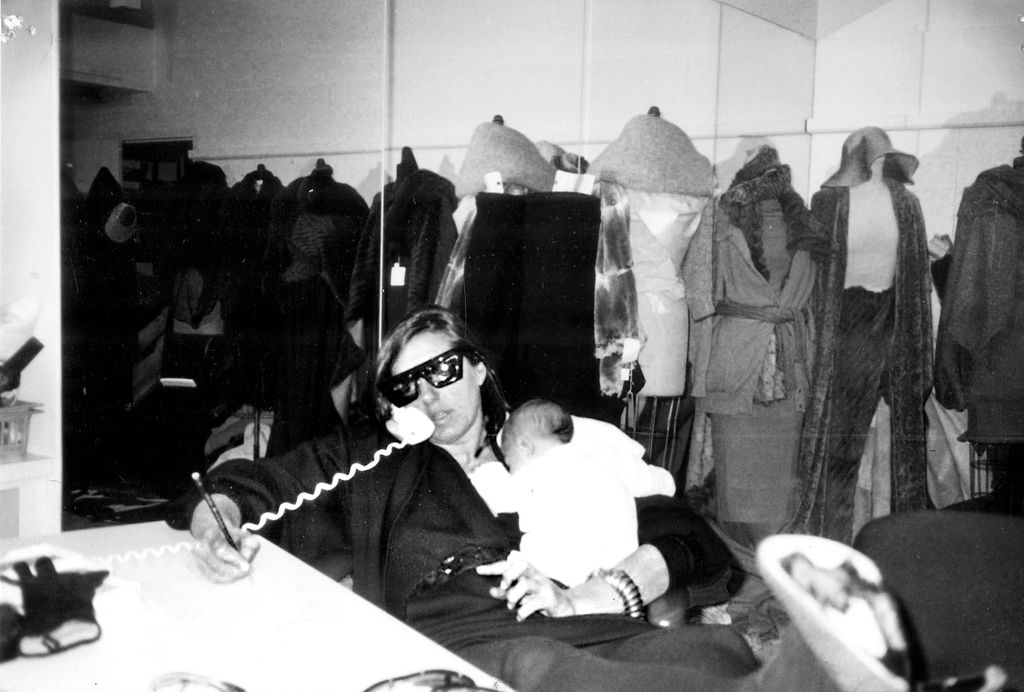
“It was in my second year at Parsons that I went for a job with Anne Klein. She said, “Walk for me,” and I was like, Why should I walk for you? She’d thought I was a model. I said, “No, I want to be an assistant.” So I was, but all I did was sharpen pencils and get coffee. I wasn’t exactly designing. Anne used to work till two or three in the morning, and I would stay, and then she fired me because I couldn’t keep up. I got a job with Patti Cappelli, who had a line called Addenda. The first day, she said, “Get a passport; we’re going to Paris.” I was a nice Jewish girl from Long Island, I was 19, I had never been to Paris before! And then we went to St.-Tropez, where everybody thought I was Marisa Berenson. And then one day I’m looking in the bathroom mirror at Byblos and I see this face and I said, “Oh my God, you must be Marisa.” There was something — we did look like each other. Then we went back to Paris and I thought, This is not what I want to be doing. So I called up this guy I had broken up with, Mark Karan, and I said, “Meet me at the airport, we’re getting married.” I got married three days later.
I really wanted to go back to Anne because I had to prove myself. I asked for my job back, and she gave it to me. It was just the two of us, really. The first time I went to Europe with Anne, we went to St. Moritz and we wore long silver fox coats and had our dress-form mannequin tied to the top of the car. Gunther Oppenheim, who owned the company, was so embarrassed. So we went out shopping and I brought a taxicab-yellow fake-fur coat and Anne bought a fake fur in black and we looked so cool, because everybody else was wearing tiaras.
Then Anne got sick. In those days, you knew it was cancer, but you didn’t talk about it. I was pregnant, and Anne was in the hospital, and I was writing the cutting tickets between contractions. We were speaking hospital to hospital, figuring out how many buttons should be on the navy coat, four or six, then I have Gabby, and they said, “When are you coming back?” The next day the collection was due, but Anne died. I ran out of the house. How could nobody have told me she was so sick? She was like my mother; we were really, really close. The collection was the day after the funeral.
—As told to Amy Larocca
My Mishpocheh
“I knew the Shah. I mean, he didn’t come to my house for Passover.”
Cindy Adams on just about everybody.
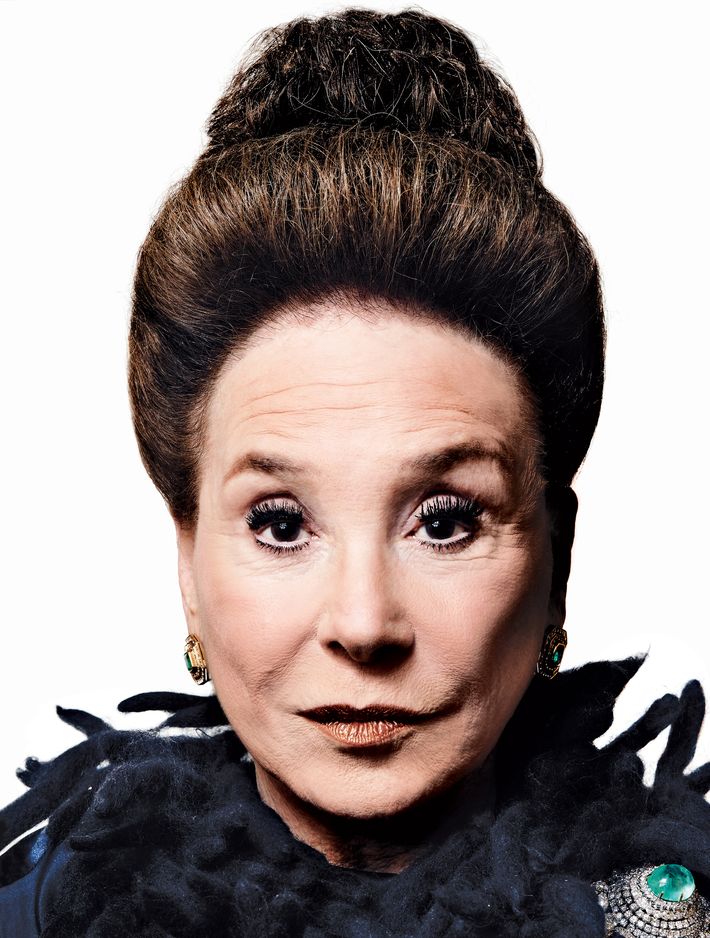
“This is probably the last gasp for gossip columns. I deplore what it’s become. It’s much too vile and vulgar. Soon, they’ll put a camera in the bottom of a toilet and shoot up. When I started writing a column 38 years ago, gossip columns weren’t so nasty. I would never out anyone. I would never tell about someone who is married and is dating someone else. Being a gossip columnist used to be one of the most glamorous things in the world. My husband, Joey Adams, had a very popular column in the New York Post, a humor column, like Bennett Cerf’s. He was the “adopted son” of Fiorello La Guardia, so some of the best judges that money could buy were made in my living room. Joey practically grew up in the Stork Club with Walter Winchell, the most powerful columnist who ever lived. There was no TV, no cell phones, no internet when Winchell wrote his columns. He was a dinosaur. He roamed the Earth. He brought down presidents and created stock-market changes.
In the late 1970s, I was writing probing, incisive articles like “Where Does Lawrence Welk Go From Here?” for TV Guide for $200 an article. What started me with the Australians at the Post was a story I wrote about my hospital visit with the Shah of Iran. I knew the Shah. I mean, he didn’t come to my house for Passover, but I knew him because Joey did shows in Iran. And when the Shah was tumbled out of power and was dying of cancer, his twin sister phoned me and said His Majesty wanted me to visit him in his hospital room. I spent two and a half hours alone with him. He was sitting on the edge of the bed in white silk pajamas, and across from him there was a giant mural of a gorilla with fangs and claws and the words CHEER UP, THINGS HAVE TO GET BETTER.
I wrote that story for the Post, and after that the Australians never let me alone for a second. Not that I wanted my own column — it was foisted on me. I did not need the money. I did not need the stress. At least I didn’t have to gather any items, because Joey’s friends were the Frank Sinatras of the world; they were people I was already having dinner with.
Over the years, the Australians kept pushing me to take “Page Six.” I said no. It was written by committee, and it had no personality. I don’t know a great many of the names you find in gossip columns today. I don’t even know why the Kardashians exist. That’s how flimsy gossip has become, that an absolute nothing who’s accomplished nothing can get written about. I still write about people we all know. I’m still writing about Clark Gable.
I wrote about a lot of dictators. I knew Noriega well. When I went to see him in Panama, he had all the lights turned out at the airport and we landed in the dark. I was escorted to see him by men with guns and rifles. I also knew Imelda and Ferdinand Marcos. It was a very long plane flight to the Philippines, and once when I was invited to see them, I was so exhausted I fell asleep at dinner on Ferdinand’s shoulder. I was also friends with Hillary Clinton. Hillary and I were thrown out of the University Club because we were making too much noise exchanging birthday presents and I was using my cell phone. A potted plant from across the room came over to us and said, “You can’t use that device here,” and he had me and the sitting First Lady escorted out. I’ve never had a feud. I don’t believe in feuds. I mean, if you don’t like me, I don’t like you either. I will take care of my friends forever and ever. But if you weren’t nice to me, I’ll get you in this life or the next one.
—As told to Steven Gaines
My “It”
“She hooked me up with Aaliyah, you know what I’m saying? And that was my first really true love.”
Damon Dash answers four questions.
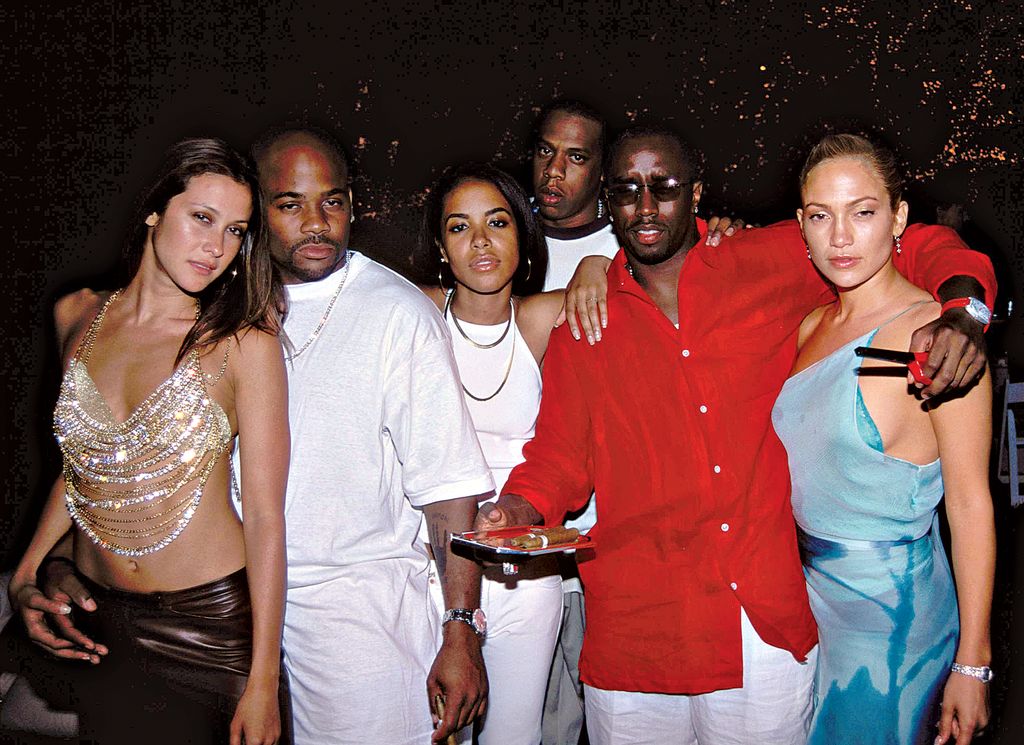
“Woman’s voice [Dash’s assistant]: Okay! This is for New York Magazine, interview with Damon Dash. [Reading from a questionnaire.] “When you came to New York, who was the person who put you on your path? Think about this carefully. It could be a mentor or a teacher, or it could be a lover or a rival.”
Damon Dash: Well, if we’re talking about the scene, I would say the person that put me on in the scene was Natane Adcock. She was like the “It” chick of the moment. I don’t remember what year it was, but we were goin’ to Spa and um … I forgot what the name of that spot was where we would go upstairs … Actually, it ended up being my club for a minute — damn, I hope I remember that name. We just were going out every night, but I had met Natane at Russell Simmons’s house in the Hamptons, and then, you know, we ended up bein’ cool and hanging out, and then she like hooked me up with Aaliyah.
Woman: Next question is “What was the coolest thing you accomplished thanks to this person?”
DD: I mean, she hooked me up with Aaliyah, you know what I’m sayin’? And that was my first really true love. She actually secured the fact that I was able to be with the coolest girl that ever graced the planet. She used to make sure that when I came in the club that I was surrounded by the best people, all beautiful women.
Woman: Could you name some other people that this person introduced you to as well?
DD: Natane got me cool with, like, May Andersen and Manon, and probably the Ronsons — Samantha Ronson and Charlotte Ronson. She introduced me to one of my best friends, Citizen Cope. She would always pull my coat to cool stuff — she still does.
Woman: At the time, who was your biggest professional rival?
DD: We used to play Puff in softball. It was Bad Boy versus Roc-A-Fella, for sure. I never looked at them as rivals, but I guess Puff looked at me as a rival somewhat. We were in the same age demographic, but they did the R&B thing, and we did the more hip-hop thing. But we were in the same circle, so that’s what the competition would be, it would be in those softball games. I’d be the pitcher, and we’d get uniforms and we’d have the best girls — and, you know, we won. You know what I’m saying? Every year. And then like the second year we did it with Bad Boy and Russell — Phat Farm. It was just fun. Music, all that. It was dope. With Jay, and you know what I’m saying?
My Tables
“Cher wanted all of her food pureed.”
An Odeon class reunion.
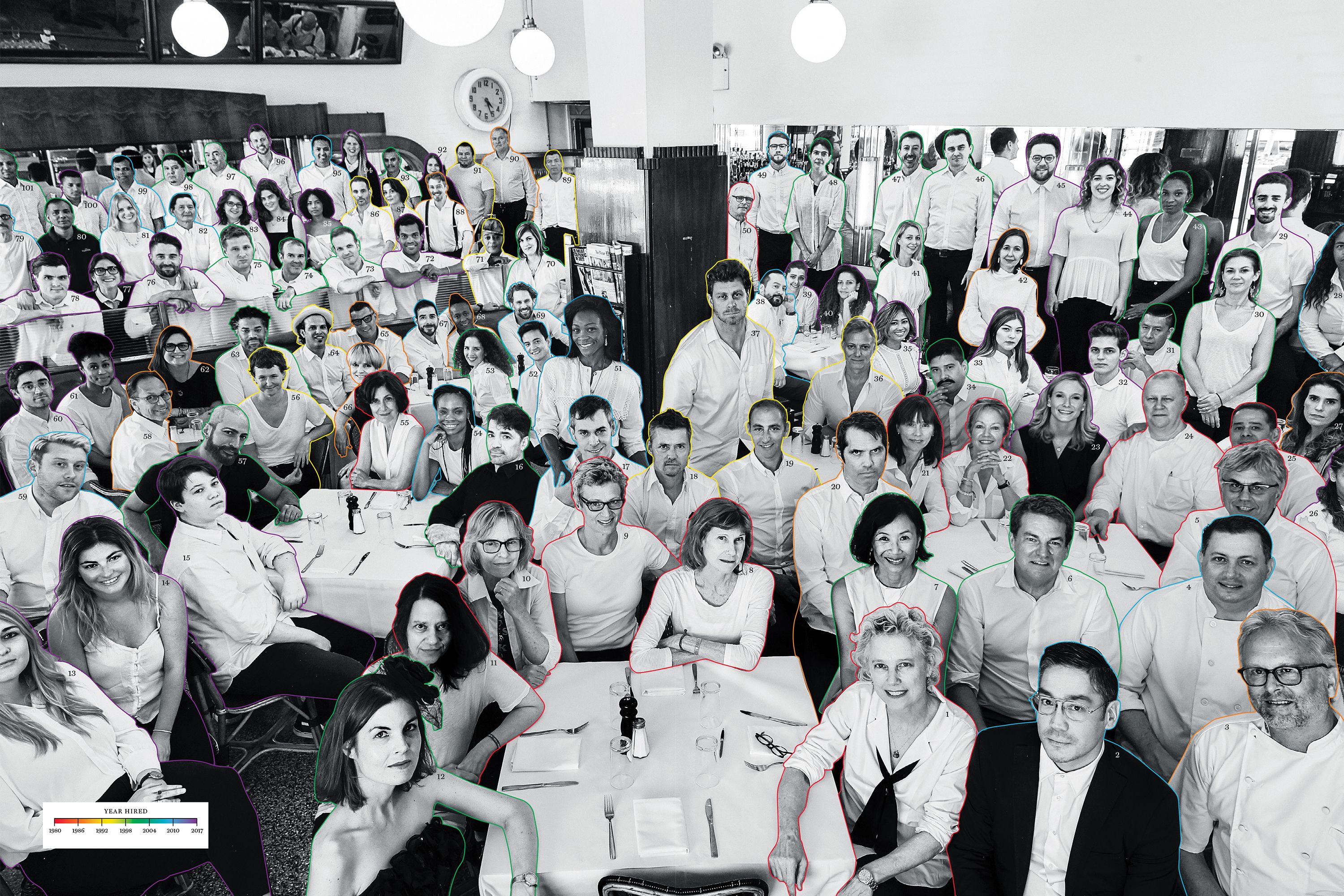
When the Odeon debuted, in 1980, Tribeca was virtually desolate — but the artists who lived there, who would soon be emboldened by the Reagan-era boom times, quickly made it their home. The celebrities came soon after. We photographed 101 of the restaurant’s current and former employees, many of whom are themselves artists or actors.
Stephen Lyle
(No. 3) executive chef, 1989–96; currently a chef and consultant
One night, this crazy guy comes in off the street, clearly on something majorly powerful — probably angel dust — and there’s a full dining room. He goes behind the bar and starts taking bottles and throwing them into the dining room. Everyone freaks out; you’ve never seen more people duck at once. Except for Taylor Mead, a regular then. He was sitting at the bar with his cane, and he was completely unfazed by this. Taylor goes, “Young man, young man, you stop that!” He was this 70-year-old guy, shaking his cane, going, “You stop that now!” Everyone thought there was a gun! But that didn’t faze Taylor, not even slightly.
Katherine Bowling
(No. 10) server, 1981–83; currently a painter
Cher wanted all of her food puréed. Maybe she had some tooth problem. And I had to go to the chef, Patrick, who was extremely intimidating, and there were never any substitutions, and I think he said no.
David Gaucher
(No. 17) bartender, 2004–7; currently manages a delivery company
Bill Murray came in once late at night, and some other customers requested a picture with him, which is not really what you do in New York. But he was so warm and welcoming. He was like, “No, no, no, we have to be actually hanging out in the picture,” so he and I start gathering glassware. There was a half-finished bottle of wine; he grabbed that. They just wanted a selfie, and he really went all out, staging it. It was a mini photo shoot.
Cynthia Germain
(No. 51) server, 2004–9; currently a leather artist (met her now-husband, David Gaucher, at the Odeon)
This regular would always give me advice: “This is what you have to do with your die cuts.” I was like, Yeah, yeah. He’d say, “Cynthia, you gotta hear me speak — every Thursday I give a talk.” His wife would be like, “You know, Cynthia, we were where you are before we made it.” And I’d think, Before you made it where?
So I’m living in Bushwick and I turn the corner one day, and the bus came by and it was advertising a Richard Serra retrospective at the MoMA. The whole bus had been painted. I knew the name from his credit card. It was only then that I realized. He comes in that day. I was like, “Richard! You told me you were an artist. But I saw you on the side of the B48!”
Mark Firth
(No. 18) server, 1994–96; currently a restaurateur
I didn’t know who anyone was. One night, this guy came up and said, “Hey, Mark, can I have a cigarette?” And I said, “Sure, John,” and the new waitress’s eyes popped out of her head. She said, “You know John Kennedy Jr.?” I said, “Sure, John and Carolyn come all the time.” They were great tippers. It wasn’t like we had Google.
Beatrice Novobaczky
(No. 42) reservationist and host, 1986–88; currently an interior designer
I was working the night when they were calling looking for Jean-Michel Basquiat. I answered the phone, and there was a person saying, “Have you seen him?” They didn’t know where he was, and the Odeon was the first place they’d thought of.
Toby Cecchini
(No. 88) bartender, 1987–91; currently a writer, bartender, and co-owner of the Long Island Bar
I served Jean-Michel Basquiat a steak the night before he died. He was nodding; his face was falling into it. I asked a server who knew him really well, like, “He’s falling face-first. What should we do?” She’s like, “Just prop him back; he can just sleep there for a while. Put it on his house account. He’s got a tab.” After an hour, he kinda stumbled out of the bathroom, and the next day he was dead.
Roya Shanks
(No. 12) server, manager, 2001–present; also an actress
This woman who eats here, she came to New Jersey for a play I was in; she drove to Ithaca; she flew to North Carolina. After the show in Winston-Salem one night, they told me, “There’s someone who wants to say hello.” And it’s Judy Baker from Tribeca.
Darrell Maupin
(No. 5) server, 1981–83, maître d’and manager, 2001; currently the assistant to art historian John Richardson
I ended up at the restaurant the morning the towers got hit. When the buildings fell down, the police moved everybody back, to Franklin and West Broadway near the restaurant. Smoke was coming up to the restaurant; I saw people jumping off the roof. There was no power, so we had to go in there and throw everything out of the restaurant. We were down there for three or four days, cleaning everything out, and then they opened up, feeding the firemen and workers and first responders before they opened to the public.
1. Lynn Wagenknecht, owner, 1980–present. 2. Aaron Crowley, general manager, 2005–present. 3. Stephen Lyle, executive chef, 1989–96. 4. Vincent Nargi, executive chef, 2005–present. 5. Darrell Maupin, server, manager, maître d’, 1981–83 and 2001. 6. Steven Abramowitz, co-director of operations, 2001–present. 7. Judi Wong, co-director of operations, 2000–present. 8. Leslie Journet, server, 1982–83. 9. Melva Max, server, 1981–84. 10. Katherine Bowling, server, 1981–83. 11. Miriam Zyndorf, server, 1983–85. 12. Roya Shanks, server, manager, 2001–present. 13. Lily Smith, bartender, 2011–15. 14. Rachel Braude, host, 2010–12. 15. Henry Kamp, ice-cream scooper, 2017. 16. Johnny T. Sollitto, server, 2001–3. 17. David Gaucher, bartender, 2004–7. 18. Mark Firth, server, 1994–96. 19. Andrew Tarlow, food runner, server, bartender, 1993–98. 20. Robert Carlson, bartender, 1989–91. 21. Kirsti Craig, server, maître d’, 1982–85. 22. Geraldine Bartlett, server, 1981–86. 23. Caitlin Ewing, manager, 2016–present. 24. Jon-Michael Smith, server, manager, maître d’, 1981–83. 25. Edwin Boria, bartender, 1981–84. 26. Estephany Lopez, host, expediter, delivery, ice-cream scooper, 2016–present. 27. Lucy Wallace Eustice, bartender, 1989–90. 28. Aurelia Morrison, accountant, delivery manager, 2008–10 and 2017–present. 29. Andre Szabo, server, 2014–present. 30. Stacey Weihe, server, 1998–2002. 31. Noe Rosas, sous-chef, 1999–present. 32. Sam Dusing, server, 2014–present. 33. Tomi Heady, server, 2015–present. 34. Raúl R. Torres, server, 2002. 35. Ivy Arce, bartender, 2014–present. 36. Steven Ross, maître d’, server, 1995–97. 37. Dylan McCormick, bartender, 1992–96. 38. Brandon Moser, server, 2006–16. 39. Elise Taff, server, 2011–12. 40. Annie Moser, host, 2013–16. 41. Gretchen Zimmermann, server, 1999–2001. 42. Beatrice Novobaczky, reservationist, host, 1986–88. 43. Tracey Lieberthal, host, 1998–99. 44. Leah Holmes, bartender, 2016–present. 45. Austin Nixon, server, bartender, manager, 2011–present. 46. Raphael Girardoni, floor manager, maître d’, 1999–2001. 47. Ian O’Donnell, server, 1999–2003. 48. Myda El-Maghrabi, server, 1998–2002. 49. Igor Gnedo, busser, server, 2006–14. 50. Paul Bacsik, bartender, bar manager, 1984–98. 51. Cynthia Germain, server, 2004–9. 52. Miguel Alfonso, sous-chef, chef de cuisine, 2006–9. 53. Fadwa Elkotni-Weng, server, 1999–2002. 54. Christine Hollingsworth, server, 2010–13. 55. Marlene O’Halloran, server, general manager, 1981–95. 56. Joanne Freedman, server, manager, 1996–2004. 57. Salman Khan Qureshi, manager, maître d’, 2000–7. 58. Steven Winslow, bartender, general manager, 1988–90 and 1996–2000. 59. Zack Ashley, server, 2005–6. 60. Anthony Jackson, bartender, 2011–13. 61. Breanna Arrington, host, 2012–14. 62. Melissa Huffsmith-Roth, bartender, 1989–94. 63. Charles Hardwick, bartender, 1998–2000. 64. Abdul Tabini, bartender, 1995–2009. 65. Hafid Elbroji, manager, 1989–2000. 66. Malia Mills, maître d’, server, 1991–93. 67. Angelo Miliano, bartender, 2005–10. 68. Carmen Grau, server, bartender, maître d’, 1990–92 and 1999–2003. 69. Jason Schuchman, server, 2004–8. 70. Amber Berry, bartender, 2002–5. 71. Steven Nalley, bartender, 1992–2003. 72. Scott Williams, server, bartender, 2016–17. 73. Jon Perry, bartender, 1999–2001. 74. Peter Russo, server, runner, 1999–2002. 75. Ryan Maupin, server, 2002. 76. Corey Sheppard, server, 2013–15. 77. Zealan “Z” Turner, bartender, 2014–present. 78. Jon Turner, server, bartender, 2011–16. 79. AE Kessel, server, 2004–present. 80. Uttam Saha, houseman, 2000–present. 81. Sondra Tackett, server, 2005–10. 82. Carlos Garcia, houseman, 2005–present. 83. Alessandra Delle Grotti, server, manager, 2015–17. 84. Manon Bailly, host, expediter, 2014–present. 85. Milagro Pineiro, host, 2016–present. 86. Tommy Lonardo, server, 1992–97. 87. Teri Cotruzzola, server, host, 1994–97. 88. Toby Cecchini, bartender, 1987–91. 89. Ricardo Arias, server, 1996–2000. 90. Billy Gilroy, maître d’, bartender, 1987–89. 91. Sergio Garcia, server, 1994–2002. 92. Miranda Watson, expediter, 2014–present. 93. Leobardo Uroza, food runner, 2003–present. 94. Mary Karl, server, manager, 2014–present. 95. Adrian Fontanilla, head bartender, 2009–present. 96. Kieran Rodgers, manager, 2011–13. 97. Luis E. Velasquez, food runner, 2001–present. 98. Cuauhtémoc Hernandez, line cook, 2001–present. 99. Shyamal Sen, busser, 2008–present. 100. Humaun Ali, busser, 2012–present. 101. Mohammad Babal Uddin, busser, 2003–present.
—As told to Mary Jane Weedman
My Wife
“I tried to get one of the piers and make it into an office building, but that was hopeless.”
Barry Diller on moving to the West Side with Diane von Furstenberg.
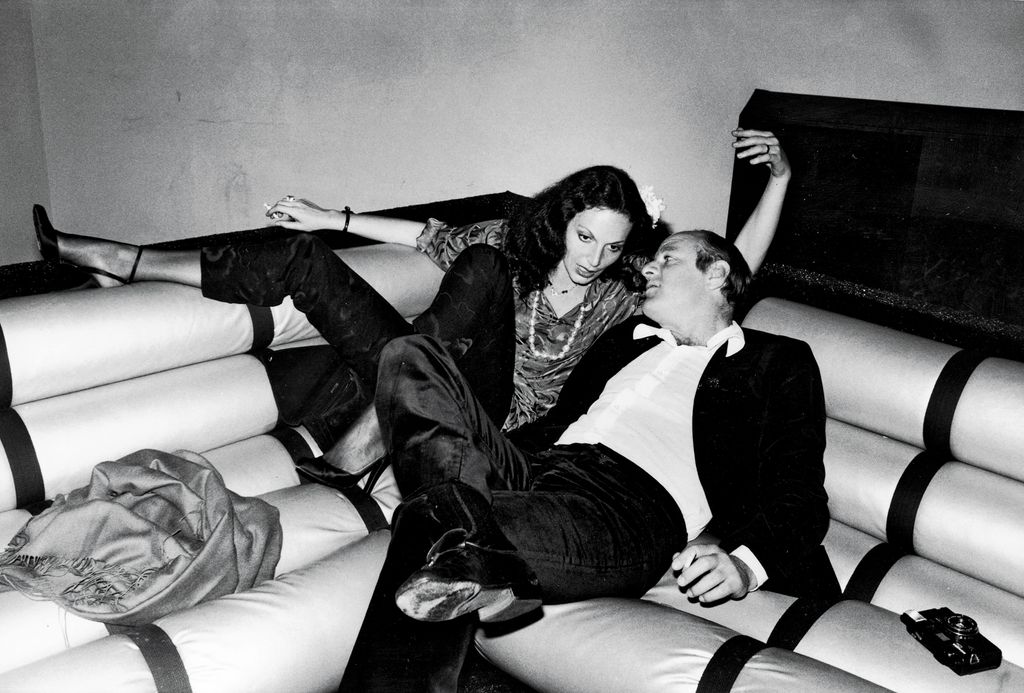
“For years, my wife — we hadn’t yet gotten married but we were with each other — had her studio on Little West 12th Street. She’d moved down from an old Deco-ish building on Fifth and 57th. She loved the diversity you could draw on, the street life you could, you know, suck up from. She was definitely a pioneer there. The atmospherics were completely different. In some ways, they were cozier. You know my building [the shiplike IAC headquarters, designed by Frank Gehry]? I don’t know that there had been a building constructed around here for 50 years. Most of the landlords were just sitting on the land. They were trying to get the High Line blown up because they thought it was hurting their nonexistent building plans. My wife, uh, and — um, why will I blow his name? You might know — Goddamn — who had that 24-hour diner. Florent. So Florent and my wife, learning that Giuliani had signed the order to tear the High Line down, got involved. And they got it stopped. Without an idea in their heads of what to do with it.
My company was on 57th Street, and I wanted a building on the water. I tried originally to get one of the piers and make it into an office building, but that was hopeless, and the next best thing was the West Side Highway. People said, “Where are you going? No one’s down there. Also, it’s a little far from the subway,” and all that other garbage. But I had this mania. To think that now Google is near us. Now I would never move here; I couldn’t afford it.
My wife’s building is on 14th and Washington. With the semi-pyramid on top. She lives there above the store. That is where I sometimes live. I was allocated the space of a small drawer. So I am partly there and partly at the Carlyle. We kind of split it between the two. Anyway, who cares. The other thing that has changed is the Hudson River Park. You can now get to the river. One of the things which really bothered me about pulling out of the island [Diller’s proposed floating park, which became entangled in lawsuits] is that it would dampen other people’s drive to do things like that. But memories are short, so I don’t think so. And my desire to continue to do things in New York is not going to end because of the end of that. My wife and I are lucky enough to have resources and an interest in public spaces and public art, so we’ll find something else. I just don’t know what yet.
—As told to Carl Swanson
My Ride
“He could write such a juicy tell-all book.”
Katie Couric and Amro Maamoun on their five-year relationship.

“Amro Maamoun: I remember the first time I saw you at ABC.
Katie Couric: Amro said, “I’d be happy to work for you,” and I was thrilled because I love Amro. For much of my tenure at the Today show, I had one driver named Jack Sturm, with whom I became extremely close. Jack was diagnosed with pancreatic cancer when I was at CBS, and he died very quickly. I was really bereft when Jack died, and, quite frankly, I was spoiled. I was used to having someone help me juggle everything. Then Amro came into my life. Amro knows everything about me. He’s seen my former boyfriends. He’s seen me now with my husband, John. He could write such a juicy tell-all book.
Amro: This is the black box of Katie.
Katie: Amro always knows exactly where I’m going, because I’m kind of scatterbrained and I’m doing a million things. He’ll be like, “No, it’s the 19th floor.” Or I’ll walk into the wrong door, and he’ll be like, “No, over here.” If you move jobs and you’re running around doing different projects, those people who are a constant in your life become so important. I don’t want to say you’re my work husband, but you’re my on-the-road husband, Amro.
Amro: Katie called me John a couple times. Since I work with Katie, I have my own house. She helps me to put my older son in Catholic school, which is a better environment for him to focus in.
Katie: I do sometimes feel guilty because … you know. But I also think I’m able to give something to Amro. I think he’s well compensated. I try to make sure that he’s taken care of. So as spoiled as I feel, and as much fun as my husband makes of me about not being able to figure out the subway system very well, I also feel like I’m helping someone, too.
Amro: It’s not like the relationship between employer and employee. It’s more than that.
Katie: I feel very lucky. He’s so cute, he always has this gum for me. I’ll say, “Amro, I really love those tropical-fruit Life Savers” — I really like the banana and the mango ones. He does little things that are really, really nice and thoughtful. I always think it’s like “Driving Miss Katie,” and Amro, in about 20 to 30 years, is going to be feeding me in the nursing home. Like Morgan Freeman and Jessica Tandy.
—As told to Lisa Miller
My Benefactor
“It felt like they really cared, you know?”
Mikhail Baryshnikov on his safe landing.
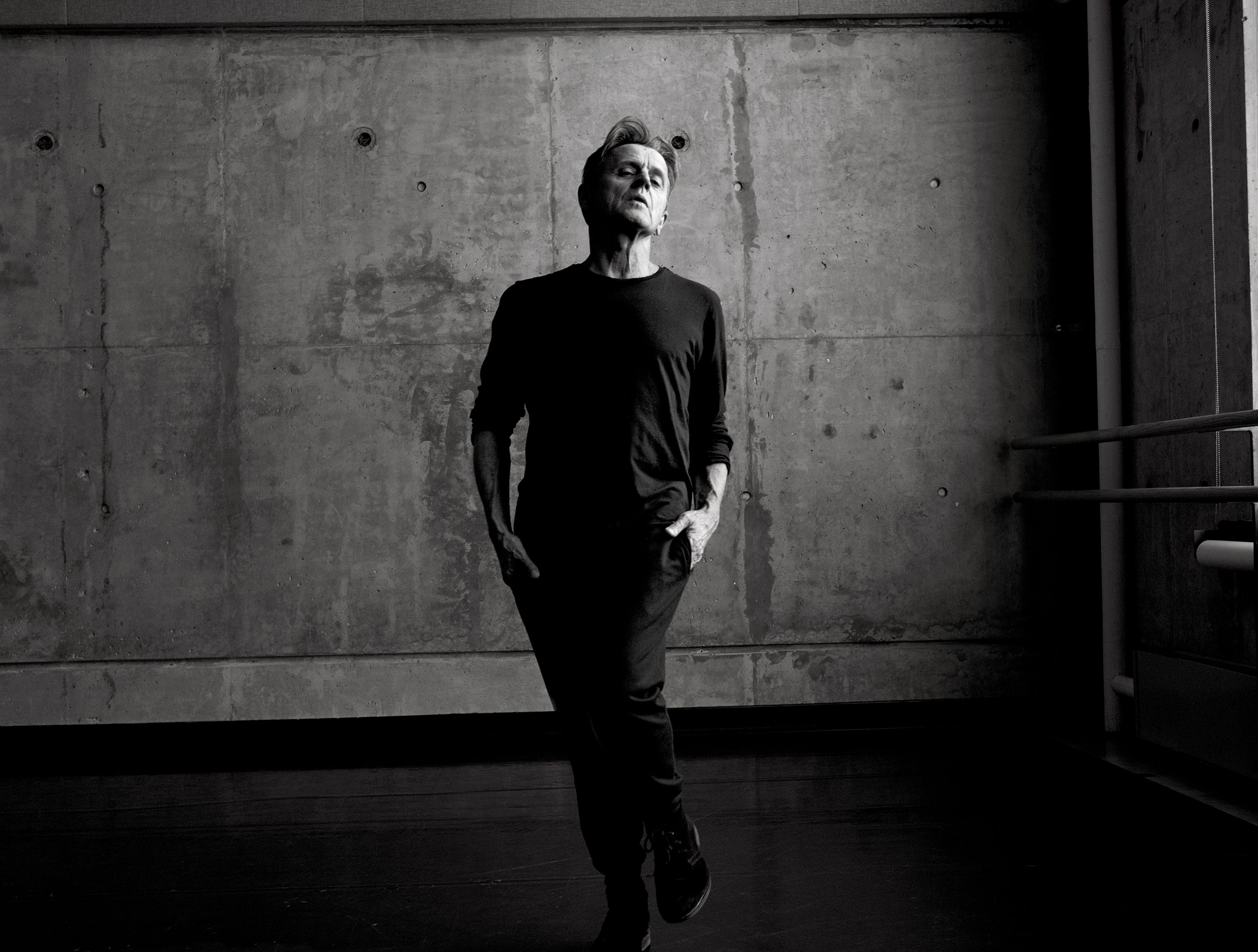
“I met Howard Gilman, the heir of the Gilman Paper Company, after just a few days in New York. We had mutual friends, including Mstislav Rostropovich, the Russian cellist. We probably met briefly through Rostropovich, at coffee or a cocktail party. Howard hosted a dinner party in my honor at his place, and we kind of clicked.
The dinner party, my God, it was the whole of New York — from Jackie O. to Lenny Bernstein to Isaac Stern. There were probably 40, 50 people there. It was kind of remarkable. I couldn’t communicate with them freely, because I didn’t speak any word of English — a bit of French, maybe — but some people, like [the ballerina] Natalia Makarova, helped translate my thoughts.
After my — I still don’t like this word — defection, Howard gave me a place to live and advice when I really needed it. He had a beautiful apartment on 57th Street east of First Avenue, and he kept a little penthouse for a guest looking over the East River. I stayed there on and off for a couple of years. He was there living with his boyfriend, and I was welcome anytime. Any minute of the day and night. It felt like they really cared, you know? He made it possible for me to really work without worry, without fear. It felt like I had found a lost relative who wanted nothing but for me to succeed and be happy.
I would never label myself a mentor, but I am kind of a voyeur by nature. I’m intrigued by this 18-year-old choreographer Gianna Reisen, who had a kind of remarkable debut recently at the New York City Ballet. I haven’t yet read her bio or anything. But it’s very exciting to see people break certain rules and discover new depths of their possibility. That’s what art is about.
—As told to Rebecca Milzoff
My Moses
“As it happened, they tore down the Coliseum.”
Robert Caro on the grandiosity of his subject.
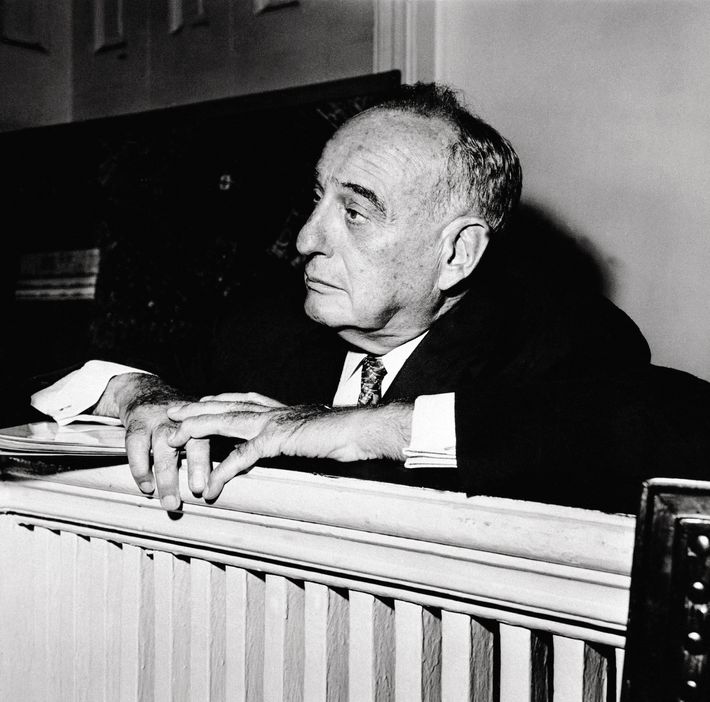
“I happened to be waiting my turn at the coffee cart on West 57th and Broadway, near my office, when suddenly I felt a hand gripping my arm with a grip that seemed like a steel vise. “Caro?” The voice came from behind. “Yes,” I said, turning around to see a large man with a hard hat on. “You know, I have read The Power Broker over and over, and now I am reading the Johnson books.” I was taken aback. He didn’t seem like my typical reader, but as he talked about the books, he was a very intelligent one, and I quickly realized my own prejudice. His name is Jack Vaughan, and he is a foreman of the crew that is building, on the northeast corner, what “is going to be the largest residential structure on the face of the Earth,” according to Jack. When I look out my office window, from the 22nd floor, at this mass of men high up in the sky, I wonder which one Jack is.
My whole relationship with New York is filtered through my work on The Power Broker. When I look north and west at Columbus Circle, I see the Time-Warner building. The New York Coliseum used to be there. Robert Moses built it in the 1950s and named it that because he was thinking of the Romans and because he believed all of his works would endure and confer immortality on him. When my book was published, in 1974, I will never forget Moses asking, then answering, his own question: “Well, how long will The Power Broker be around? It will be gone before you know it.” As it happened, they tore down the Coliseum, but the book is still in print.
I can’t go over the Triborough Bridge without thinking of Moses. When I am on the Cross Bronx Expressway, I think about the long mile of six- and seven-story apartment buildings that were torn down, how the community of East Tremont was destroyed, how thousands upon thousands of people were displaced, in order to build that trench. And when I walk to work in the morning, entering Central Park at 69th Street and coming out at Columbus Circle, I walk past the Tavern on the Green and think about how Moses wanted to build a parking lot where the playground is, and how mothers lined up with their children in strollers and stood in front of the
bulldozers.
—As told to Jonathan Coleman
My Drivers
“She let the window down and said, ‘Hey.’ I went crazy!”
Stargazing from the Holland Tunnel.
Elizabeth Branch: I work midnights as a toll collector at the Holland Tunnel. I’ve been working for the Port Authority for 52 years. When I started, they didn’t have a maternity leave. Women would lose their jobs if they had children. So the other collectors and I got together and fought to have maternity leave. This was the early 1970s. All the children that were born then are adults now.
I’ve seen some celebrities. I saw President Nixon come through a few times. I also saw Patti LaBelle! We had a stoppage in the tunnel that night. Her driver asked, “Is there any way we can get through?” and told me he was carrying Patti LaBelle. I said, “I don’t believe it!” but she let the back window down and said, “Hey.” I went crazy! I started hollering and jumping up and down until the police came and asked what the matter was. They were young, so when I told them, they said, “Who is Patti LaBelle?” She even mentioned me in the TV interview she did that night. Luckily not by name, or I might have gotten in trouble.
I have my regulars. I have my admirers. I have my haters. They’re only in your lane a minute. A matter of seconds, really.
—As told to Eileen Townsend
My Flock
“Recently, a young man approached me in the midst of ending his life.” Fifty faces of New York’s religious plurality. Portfolio by Martin Schoeller
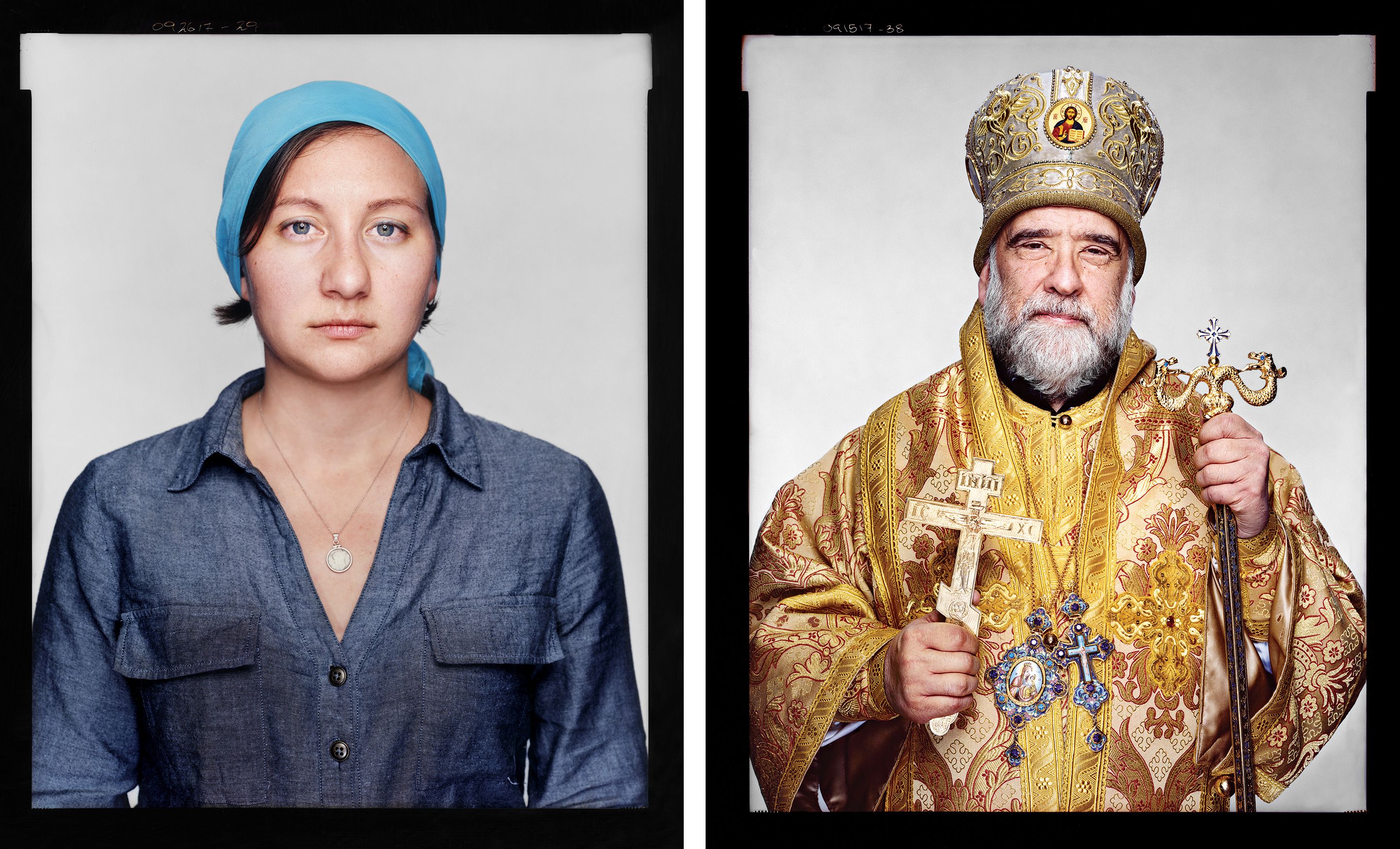
—As told to Nick Tabor
My Oklahomans
“To Der Führer: I received your capitalist gift …” Every New Yorker wants to be haunted by her childhood.
By Rivka Galchen
In my high school in Norman, Oklahoma, the senior English students were traditionally secret Santas for the junior English students. I was assigned a beautifully pale young man who dyed his long hair black, wore John Lennon glasses, and often carried his violin. I anonymously gifted him a chocolate bar and, I think, a Number Slide puzzle. The idea was that a yearlong correspondence would form. A few days later, I received a note, marked up in thick black marker, which started off something like “To Der Führer: I received your capitalist gift …” Years later, someone was handing out flyers for the Socialist Worker paper on the Columbia University campus, and when I looked up at the distributor, there he was, my old pen pal. I experienced a deep and happy sense of continuity. He was getting a Ph.D. in history under Eric Foner, writing about the Socialist Party in Oklahoma.
Outside Central Park, I ran into a woman who as a seventh-grader had pulled me aside at recess to ask, “Why do I hate you so much? Is it because you remind me of myself?” It was an impressive insight for middle school. In history class a couple of years later, she sat behind me, and not infrequently, she would hit me over the head with our thousand-or-so-page textbook. Now here she was, smiling, and I was so happy to see her. She was working as an editor for a fancy food magazine and married to a man who raised goats, I think.
A friend of mine who used to write UTERUS on a piece of paper as a joke — I promise, it was hilarious back then — I ran into because he was now an attorney in the Bronx. I asked about a mutual friend, who had in high school drawn cartoons of rubber darts landing on people. The cartooning friend’s parents had wanted him to go to MIT, but he had not wanted to go to MIT, and so on his application, when asked to write about a personal hero, he had written about the Shining Path. What ever happened to Kwang? I asked. He had become a born-again Christian, and they had fallen out of touch.
My Loud Neighbor
“ ‘Where do you find the time to bone?’ one asked.” Listening to Airbnb.
By Dan Amira
In the midtown apartment building where I live, there are five other apartments within farting distance of mine. I don’t know any of the people who live in any of them. We just don’t interact. If I had to give a eulogy for my nearest neighbor, it would go something like, “My fondest memory of the guy from 6D is that he owned a welcome mat.”
So it took me a while to notice when the apartment next door began to be used exclusively as an illicit Airbnb. Every few days, a new European or Asian or Floridian family would announce their arrival with rolling suitcases and clattering keys. Lots of clattering. None of them could ever seem to figure out how to unlock the door. Some stood in the hallway for ten minutes, strategizing, trying different techniques on the doorknob. I thought about timing everyone and maintaining standings, like American Ninja Warrior, but for opening a door.
It probably isn’t mentioned in the Airbnb listing, but my building has walls made of tissue paper and lint collected from the basement laundry machines. If the visitors next door are partying, I can hear it. If they’re arguing, I can hear it. And when a quartet of vaguely midwestern-sounding young moms on a girls weekend spend an afternoon drinking wine and dishing about their sex lives, I can hear that, too.
One of the women was an atheist who lost her virginity at 14, then didn’t have sex for two years because it was so meh. She said her husband would expect a blow job when she got home as a reward for taking care of the kids all weekend. Another woman, who may have been Mike Pence, ruins her own sex dreams before they get good because she reminds herself in the dream that she’s married. All the women unironically used the word boning to refer to having sex, every time. “Me and my husband don’t bone that often anymore.” “Where do you find the time to bone? By the time I put my kids to sleep and we eat dinner, it’s like 9:30, and I’m like, Ugh, I’m not gonna bone now.”
I never met them, I never spoke to them, but it was, by far, the most I had ever known about any of my neighbors.
My Critic
“Oh, honey, you shouldn’t be showing that to anyone.” Walk away from Pauline Kael, they warned. Whatever.
By David Edelstein
In July of 1984, six months after I’d become the third-string film critic at the Village Voice, Pauline Kael introduced herself in a movie line and said nice things about my work, and within a week I’d gotten calls from concerned colleagues.
One said not to get close because she’d eat me alive. Another took a longer view. I should keep my distance, he said, because the association would harm my career: I would be forever known as a “Paulette,” a member of a claque of youngish men who were said to take marching orders from the Queen Bee. My votes at critics’ societies would be suspect and my style viewed as slavish imitation — though it was probably viewed that way already. (Four years earlier, my voluble college film professor had told me he feared I’d turn out like her — a “bourgeois impressionist.”) And I was at the Voice, for crying out loud, home of Kael’s nemesis, Andrew Sarris, as well as the more formalist (and political) J. Hoberman, and editors who thought she was variously misogynistic, philistine, and even reactionary. Walk away, walk away.
I didn’t walk away. It was Pauline Kael, for fuck’s sake.
For many movie lovers in the late ’60s,’70s, and ’80s, Kael was the most exciting critic ever. Her reviews in The New Yorker often went against the general consensus, and what I had found most challenging when I first read her (as a teenager) was that if she hated something I loved, she did such a brilliant job evoking and analyzing it that I couldn’t say, “Well, that’s not the movie I saw!” It was the movie I saw plus.
I said “evoking and analyzing,” but Kael wove analysis through her evocation. The experience came first — the mind trailed behind. Her collections had sexual/romantic titles — I Lost It at the Movies, Going Steady, Deeper Into Movies — and … I don’t know how to say this tastefully … it was as if she were going to bed with filmmakers while telling them what they were doing right and wrong and then maybe — maybe — surrendering. It must have been emasculating for directors who didn’t perform.
Readers, meanwhile, could relive the movie in language that was nimble, jazzy, rich in feeling, and so goddamn funny — especially in capturing the essence of an actor. That language was different from the drier, more arm’s-length voices that had preceded her, and it flowed so easily that you could be fooled into thinking it was just gushing out. You weren’t aware of how tightly structured her reviews really were. You experienced them as great monologues, often great comic monologues.
Notice I just slipped into writing “you.” Kael was criticized for employing the second person so often, as in: “Watching [name of movie], you feel [this].” It was irritating if you weren’t feeling what she said “you” were feeling at all. She claimed that “you” was because “one” was so stuffy. But it was also a crafty mode of rhetoric. She could wear you down. I mean, wear me down.
The first time I saw her alone was in her New Yorker office, then on 44th Street near the Algonquin, where she stayed when she came to the city from her Berkshires home to see movies and work with editors. A printout of her latest review was on her desk, full of cross-outs and additions in pencil. “Do you love it, the writing?” she asked. I said no, I found it torture, and she let out a sad sigh. The process was joyous for her. Her writing always seemed like a journey, an elevated form of thinking out loud. Sometimes the parentheticals — the curlicues that sprung into her head as she wrote — were the best things.
Her Parkinson’s had a huge impact on her writing because she did it in longhand on yellow pads, her daughter Gina standing by to type it up (eventually justifiably resentful for having to be at her mother’s beck and call). Perhaps that’s why her reviews got shorter in the last decade. But in the ‘80s, the movies had also gotten smaller, their content engineered more tightly by newly corporatized studios looking for blockbusters. In what she considered her prime, she could dig into breakthroughs like Bonnie and Clyde (her celebrated New Yorker debut, when she was 48 years old), as well as The Godfather films, Cabaret, Mean Streets, McCabe and Mrs. Miller, Last Tango in Paris … so many more that it was hard for me to settle on the ones above.
The charge is misleading, though. Her idea of fun encompassed one of her favorite authors, Henry James. She loved Baroque opera. She titled her Godfather review “Alchemy” because she said that Francis Ford Coppola had transformed a garish potboiler into a profound study of American aspiration. She hated violence when filmmakers employed it casually, for kicks: She wrote that the splattery killings in The French Connection made her worry that movies would devolve into “jolts for jocks.” Some people can’t remember when movies were anything else! I’ve read that she told one friend, “When we championed trash culture we had no idea it would become the only culture.” What irritated her about those “Come As You Are As the Sick Soul of Europe” art movies was their airlessness, the way directors wrote down to and circumscribed their characters.
I never hung out with Pauline during her New Yorker tenure, but I’d see her at screenings. Even at five feet, she stood tall. You noticed her. But you noticed others, too. In the days before the internet and review aggregation sites, readers had more personal relationships (for better or worse) with critics. They felt they knew Andrew Sarris, Rex Reed, Richard Schickel, Vincent Canby, or, writing for New York, Judith Crist and Molly Haskell and John Simon and David Denby. Critics openly took one another on — although Kael, who first got noticed with an attack on Sarris’s auteur-theory primer, was forbidden by The New Yorker’s editor, William Shawn, to go after other writers by name. (Her reviews, I think, were better for that.)
The one time I sat next to her at a screening the movie was Neil Jordan’s Mona Lisa. Once it started, she didn’t acknowledge me. Her concentration was total. During one act of violence, she leapt halfway out of her chair and her limbs moved spasmodically. She loved the movie. She quoted Noel Coward’s line about how potent cheap music can be.
Several years after I’d met her, Phillip Lopate interviewed me for a smart but barbed magazine profile of Kael and I learned that my photo was going to run as part of a gallery of her friends and acolytes. But — but — but — I had only seen her a handful of times! I was just an acquaintance! I called Lopate and begged him to take me out of the lineup, and he did. But then I walked around for a day wondering if I’d have named names to HUAC. Beside, shouldn’t I be honored by the association? I phoned the editor and asked for my photo to go back in. Now it was official. Over the years, some writers whom she actually helped get jobs took pains to disassociate themselves from her publicly. Whatever. My lone regret was it was a shitty photo. And I told people I wasn’t a Paulette but a Paulinista.
In the late ’80s, I visited her in her turreted old house in Great Barrington, with its tub sinks and owl busts. (Owls were a sort of jokey avatar.) Maybe ten years earlier she would have eaten me alive. But she’d mellowed some. I remember the music of her voice, high and fluttery, a feathered quill that could tickle and skewer. I never got any marching orders. She was actually careful not to share her opinions before she wrote them up. By then, I think, she was sensitive to that “Paulette” charge. And although she took issue with people who didn’t respond to works she cared about — what person for whom art is central doesn’t? — she hated imitators. The critics — and filmmakers — she liked were those who made her do “fresh thinking.” If she had an “aesthetic,” it was, surprise me.
And that’s what she passed on to me. That and the belief that I should trust my own responses, which can be faster and smarter than later, rational analysis. Analyzing those responses is the challenge — explaining them to yourself.
Pauline gave up reviewing in 1991. She wasn’t turned on by many of the films she was seeing, the trips to New York were getting more difficult, and she wanted to go out before her writing lost its steam. At that point, I’d taken a break from criticism to work on a play, and she encouraged me, saying, “Do it now while you’re still young and have all that crazy energy.” She’d written plays herself when she was young. She wouldn’t show them to me — she said they were heavy and pretentious. She said that was probably why she was so hard on a certain species of High Seriousness. It was easier to write than it looked.
I moved to San Francisco for two years, which Pauline envied: Berkeley was where she had spent the ’50s and ’60s, running a repertory cinema and hanging out with painters and poets. We talked every week. “When are you going to send me something?” “Soon.” A week later: “When are you going to send me something?” “Soon.” I finally sent her a draft by FedEx and an hour after she’d gotten it she called and said, “Oh, honey, you shouldn’t be showing that to anyone.” I’d written a traditional farce (although the theme was drug abuse) and she said it “lacked elegance” and that I “didn’t like my characters.”
I protested that I liked those little people very much and she said that was the problem. “You have to make them smarter than you are,” she said. “Even if they’re dumb, they have to be brilliantly dumb. They have to surprise you — otherwise, why write about them?”
This was the humanist in her talking, although one who’d been partly formed by heady screwball comedies of the ’30s and ’40s. If she could have been anyone else, it would have been Barbara Stanwyck.
Pauline hated getting old, but she never drew the curtains. I thought of her as the anti–Miss Havisham. She was surrounded by light, by books and art and fresh flowers, and there were always letters to answer heaped on the dining-room table. Friends would call and she’d say, “Tell me what you’ve seen.” Directors sometimes sent prints of new movies, which a local theater screened for her in the mornings. When I’d come up for a few nights I’d drive Miss Pauline to whatever was around. (She never learned to drive.) When we disagreed about things (say, horror films or Mahler, both of which she hated), she’d roll her eyes — affectionately. When I’d show her something I’d written, the worst thing wasn’t when she hated it. It was when she said, “Well, you can get by with it.” She did love my second play, a comedy called Blaming Mom. I’d tried to make the characters brilliantly insane.
Once I told her about my professor who’d said she was a “bourgeois impressionist,” and she was quiet for a moment. “I’d always tried to be a bohemian impressionist,” she said.
She died in 2001, eight days before 9/11. One magazine scribe marked the occasion by writing, “The Paulettes are probably rending their garments.” No, just devastated over the loss of a friend — and a capacious soul. Since then there has been a dismayingly unsympathetic biography and what seems like a determined attempt to undo her legacy at The New Yorker. But I think anyone who picks up one of the books of her collected reviews for the first time will find — agree or disagree with her opinions — one of the great and most unquenchably vivacious American voices. Reading her, you’ll feel more alive. Yes, you.
Some months before the end, I drove her to the nearby emergency room when her blood pressure suddenly dropped. While she was in with the doctor, one nurse called out to another, “Is her name Pauline or Paulette?”
I interjected, “She’s Pauline. I’m Paulette.”
My Customers
“He gets a whole red chile pepper that he eats like a piece of chocolate.”
The view from behind the deli counter.
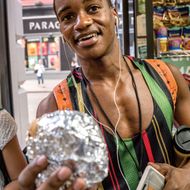
“This one likes bacon-egg-and-cheeses and is a student at the ballet theater nearby. Of course, every couple of years, the students change.”
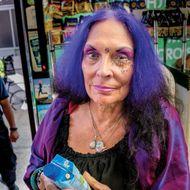
“She doesn’t come in every day — maybe twice, three times a week. Sometimes people look at her. She’s something different. But she’s very nice.”
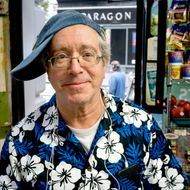
“He gets two sandwiches every single day. Very educated. He used to wear suits and ties, and now he dresses like this, very casual.”
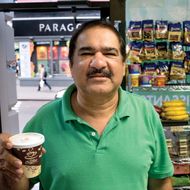
“He’s a taxi driver and gets a bagel with scallion cream cheese and a coffee in the morning. He stops usually three, four times a night for coffees and to use the bathroom.”
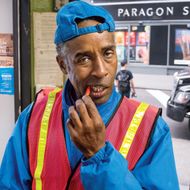
“He gets a whole red chile pepper that he eats like a piece of chocolate. Then he buys one pack of peanuts.”

“This woman, every day, iced coffee. Even in the winter.”
—Engi Salem, manager of Andy’s Deli, as told to Katy Schneider
My Voyeurs
“It’s important to respect the privacy of the people disrespecting your privacy.” Looking out on people looking in.
By Juli Weiner
“We’ve become a race of Peeping Toms,” Stella (Thelma Ritter) tells Jeff (Jimmy Stewart) in Rear Window. “What people ought to do is get outside their own houses and look in for a change.”
Rear Window might have been the last time anyone unironically urged a fellow New Yorker to spend less time thinking about others and more time thinking about himself. Voyeurism and self-obsession, though, are not mutually exclusive. And for anyone who lives in a townhouse or — as in my case — a ground-floor apartment, you don’t even have to stand outside to look in once in a while. You can do that from your own living room.
“Ooh, look at that apartment!” I once heard someone say. “So cute!”
I slid down on the couch, hoping to stay out of sight, hoping they’d wonder who lives here; more than that, hoping they’d wonder who lives here out loud. So tell me, I think, what am I really like?
“Oh, look look look — the lamp,” her companion responds. Street noise: It inflates the ego as surely as it deflates resale value.
To be fair, most of the comments I overhear concern the cat. The voyeurs and I have this in common; most of my own thoughts also concern the cat. Pajama, named for the prewar slang phrase, spends much of her time in my prewar window.
“I bet that cat owns that apartment,” one passerby said. “Look at that bookshelf — I bet those books are hers, and she’s read all of them.” She hasn’t. But if she’s anything like her mother, she takes satisfaction in the knowledge that other people assume she has.
Sometimes, someone will comment, negatively, on their ability to comment. (Overhearing your spies discuss their spying: Is that meta-voyeurism? Meta-reverse voyeurism? Maybe something on the bookshelf has the answer, something as prominently displayed as it is unread.) “You can look right into that apartment,” someone looking right into that apartment will say. “I wouldn’t want to live there.”
For the most part, I’ve never been tempted to interact with the voyeurs. My actual, honest-to-God thinking here being: It’s important to respect the privacy of the people disrespecting your privacy. Also, I want other people to imagine whoever lives here isn’t the sort of person who mutes the television to better hear strangers exchange mild approval of her lamp.
That said, about a month ago, I woke up to discover a crowd of about 30 standing outside my window. A few of them were taking photos; others were sketching on notepads.
“I’m trying to get a sense for window height here,” I heard someone say.
Architectural tour, I assumed proudly, and walked outside, lacking the self-control to resist identifying myself as the window’s owner.
“What are you guys doing?” I asked a man who looked in charge.
“Location scouting,” he said. “For a Martin Scorsese movie. About Jimmy Hoffa.”
“And my apartment’s in it?” I asked.
“You live here?” he said, glancing behind him. “Yeah, um, this is going to be a seedy hotel.”
Martin Scorsese’s The Irishman comes out in 2018. And when it does, I hope people wonder about the seediness of the hotel; more than that, I hope they wonder about it out loud. I won’t even have to slide down in my seat to hear their approval, although maybe I will anyway, just out of habit.
My New Friend (And Theirs, And Theirs … )
“So I pick up the phone, and somebody goes, ‘Hi, this is Sandra Bernhard.’ ” How Pat Kiernan connects to Jeremy Lin connects to Robin Byrd. A 50-person chain of quintessentially New York relationships.
By Alexa Tsoulis-Reay

Pat Kiernan served on jury duty with Adia Revell.
Pat Kiernan: You’re stuck together in a room for two weeks, so you become … familiar.
Adia Revell: I knew that he looked like someone. Then, one of the other jurors was like, “Wait, that’s the guy that’s, like, on TV or something.”
PK: Adia and I were counterparts in curiosity. The other jurors may have thought we asked too many questions.
AR: Some people were like, “I want to get home.”
PK: When we finished, we all went out drinking at Rocco’s Tacos on Adams Street.
AR: Pat ended up paying. My daughter’s father picked me up, and I’m pretty sure that was the night she was conceived — I have a picture of Pat and me; when I look at it, I’m like, This is the night.


Adia Revell got her eyebrows threaded by Rubina Jasmin.
Adia Revell: The first few times, it was terrible. I don’t know if she was just starting out? But I kept going back, and over the years, she got better. She would always ask me if I was married. Partially, it was endearing.
Rubina Jasmin: When they come, they are strangers, and then they become like family. They can help me with my problems. I get lots of good advice.
AR: At night, she sends me texts about expanding her business. I met her daughter a couple of weeks ago, and then Rubina requested me on Facebook. I don’t engage, obviously, ’cause Facebook is a little weird, but I got to see the food she’s made for the holidays.


Rubina Jasmin gave an aggressive sales pitch to Barbara Wilson.
Barbara Wilson: One day this woman approached me on the street, trying to get new business.
Rubina Jasmin: I’d see her trying to go into another salon, and I’d call out to her, “Excuse me, can you come to me instead?” She said no, but I tried many times.
BW: It was hard to say no, she was very persistent.
RJ: Sometimes I get letters or things that I don’t understand, and I take it to Barbara and say, “Barbara, what do I do?”
BW: I say I’m her unofficial attorney. She’s never given me a discount for my services, though.


Barbara Wilson ordered rum-and-Cokes from Tim Dorian for a decade.
Barbara Wilson: When I worked at the hospital and our shift ended, we’d go to Junior’s and have a little cocktail.
Tim Dorian: I have so many regulars, and I read people. I’ve been working since I was 12. You go to work, and if you’re dead, you still go to work unless they tell you, “It’s okay, you can lay down and die.”
BW: Tim would see me coming, and before I got to the bar he had my rum-and-Coke. He’d tell me about the book he was writing — he was working on it for years. I wonder if he ever finished.
TD: My next project was about a topless bar in Queens.


Tim Dorian enlisted Katie Van Buren in a web series he had planned.
Tim Dorian: I met Katie through a documentary I wanted to make about the famous TV host Joe Franklin.
Katie Van Buren: I was on Facebook, and my stage manager posted a picture with Joe Franklin. I ran into the studio and was like, “Can I meet him?”
TD: Katie came in to be on camera.
KVB: Joe and Tim would give me topics, like old Hollywood stars, and I would just chat with him while they recorded it. From what I could gather, Tim was one of Joe’s best friends. They exchanged looks and nods. I don’t know where the web series stands now, to be honest. Tim has a lot of footage.


Katie Van Buren bought candy from Daniel Levin.
Daniel Levin: One day, she came into my store; she had just arrived in New York.
Katie Van Buren: It was my first week, and I knew nobody. This guy is like, “Hey, do you want some candy?” I was like, What? That is the mother of all warnings. But he really did work for a candy store.
DL: Then we hung out a few days later on my roof. We got tacos.
KVB: We didn’t really stay friends; not for any reason, it’s just, people drift.
DL: I’m a little bit older, possibly a little tamer.


Daniel Levin and Jon Morris are loft neighbors.
Jon Morris: Dan and I basically live together, separated by a thin bedroom wall.
Daniel Levin: His energy is very noticeable. Like, the first thing I thought was, This guy is very warm, and he’s got some energy.
JM: We have an open-door policy. It’s like, our crazy Italian neighbor is Kramer, and Dan’s Costanza — a little more positive though. He’s heard all our parties through the years and never complained, which speaks to his adventurous spirit, I guess.


Jon Morris met Wendy Whelan dancing.
Jon Morris: I had heard about Wendy from dancer friends of mine. Then when we met, we immediately became friends because she’s also from Kentucky. We were joking around in the way that fast-talking redneck Kentuckians can do.
Wendy Whelan: Jon came via my husband, so they’re a little closer, but I do love Jon. From what I know, he lives life big, and he just goes for everything. I guess I’ve gone slightly more toward his energy since I left the ballet in 2014. My routine is very different now. A little more open.


Wendy Whelan met Pamela D’Arc through Alan Rickman.
Wendy Whelan: I was doing a project with Patti LuPone, so I went to see a show of hers, and Alan was there. We became friends.
Pamela D’Arc: Later, we did all end up at a dinner with Patti LuPone, that’s true. But Patti’s really just Alan’s friend; she wasn’t the relevant part.
WW: One day, someone wanted me to audition for an actress job.
PD: She was so nervous — she doesn’t speak when she’s dancing.
WW: Pamela, a former actress, had me over. We had a little wine and coaching session.
PD: I had to grab her to loosen her up, like, “Come on, Wendy, let it go!”


Pamela D’Arc sold Dr. Han Jo Kim an apartment.
Pamela D’Arc: He’d just gotten married and wanted to buy something, and I had a gorgeous condominium.
Dr. Han Jo Kim: My wife and I were on our honeymoon in Capri, and we ran into a developer who over dinner told me about his building. It was a little out of my price range, but I was like, “I’d love to talk.”
PD: During the process, I had a medical concern. I’d say, “Now, can I just ask you about my MRI?” He just said, “Oh, don’t worry, that’s all natural.”


Dr. Han Jo Kim found Cristal Genise-Nierenberg’s desserts.
Dr. Han Jo Kim: Her husband is a manager at the Ralph Lauren mansion. Our relationship is easy — I go in, he has three suits ready to go. So then my fiancée and I were planning a party, and he said his girlfriend is an amazing pastry chef.
Cristal Genise-Nierenberg: The first time we all met was at the Polo Bar. Then my husband needed surgery on his neck, so Han Jo did it.
HJK: After they came to our wedding, they’re like, “Yo, can you officiate ours?”


Cristal Genise-Nierenberg buys pork from Michael Caminiti.
Cristal Genise-Nierenberg: I’ve been going to Pastosa in Staten Island for years. It’s a famous Italian store. Every time, we talk to Michael.
Michael Caminiti: They’re regulars. Nice young couple.
CG-N: He’ll let us know what meats are in and be like, “Stop talking and listen to me.”
MC: I can talk a lot. I want to share my knowledge. Most people are scared of the oven. They’re like, “How should I cook this?” You tell me you haven’t cooked this before? What the hell were you doing?


Michael Caminiti poached Ryan Chin.
Michael Caminiti: When I met Ryan, he was behind the bar next door to a bowling alley. I said, “Listen, come work for me.” He goes, “Mike, you know I’m not Italian.” He’s a six-foot Asian guy. I go, “It’s obvious, Ryan. Don’t worry about it.” He bartended for 14 years.
Ryan Chin: Only reason I left was because I was making insane money commodities trading.
MC: When he got divorced, I moved him to Long Island City. He had goldfish that he was going to give me, but he also had 9-mm. guns that he uses for target shooting. I was like, “I think you should keep the goldfish; I’ll take the guns.


Ryan Chin adores Jeremy Lin.
RC: I’m now working back on Staten Island. We could go years without speaking, and if I ever killed someone, I’d be like, “Hey, bring your shovel.”
Ryan Chin: We’re both Chinese-American guys over six feet, but that’s not why I like him. I grew up watching the Knicks. They were horrible. You watched as he energized the team.
Jeremy Lin: I don’t encounter a lot of over-six-feet Chinese-American fans, but a lot have said they identify with me.

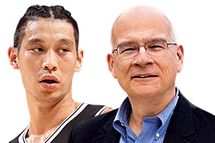
Jeremy Lin talked a lot to Tim Keller.
Jeremy Lin: I’d read one of his books before I moved here. Then he offered me phone counseling.
Tim Keller: He asked questions about navigating his new fame.
JL: I was staying on my brother’s Stuy Town couch. It was an uncertain, desperate time. I didn’t think I’d be kept on the team — I was scared to unpack.

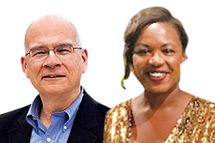
Tim Keller took in Lolita Jackson.
Tim Keller: Lolita is one of about six people over the years who is a “long-term single” and who we invite to be a part of our family.
Lolita Jackson: I was stranded during the holidays, so he said, “Come have Christmas with us.” I worked for Morgan Stanley, and most of my mentors were white men, so that’s been a pattern. I love old white guys.


Lolita Jackson danced with Winsome Lee “Sanchez.”
Lolita Jackson: Winsome was in the same a cappella group as me in college. When she came to New York, she got into the salsa world. So I was like, “I need to get fit.”
Winsome Lee “Sanchez”: Lolita showed up. It was weird to have her in my beginner class.
LJ: She has a headpiece, the whole thing.
WLS: I warmed up to her. She took it so seriously.


Winsome Lee “Sanchez” gave Wali Collins her discount.
Wali Collins: She was born in Hong Kong and salsa-dances. My brain was like, Well, she can’t be that good. But this chick was throwing her hips around.
Winsome Lee “Sanchez”: I used to work for a luxury retailer, and he would want my friends-and-family discount. He’s like, “Hook a brother up!” Yeah, it’s a seasonal relationship.

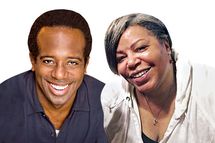
Wali Collins met Sheila Anderson in the trash room.
Wali Collins: One day, I’m taking out the trash in my building, I hold the door for this woman who has a really cool voice. She says, “I’m a radio DJ at WBGO.” I was like a kid: “Ooh, you’re Sheila Anderson?!”
Sheila Anderson: He got goose bumps.
WC: There’s a lot of Geminis in this building, so she set up a Gemini-themed party.
SA: It’s quite a party. One year, some people had sex in my bathroom. I put the picture on Facebook. I said, “Somebody got busy!”
WC: Two years ago, there were 400 people. Each floor had its own thing. Liquor on the fifth; entrées on the fourth; dessert on the sixth. There was a techno room, a ’70s-R&B room. Sheila had live jazz.

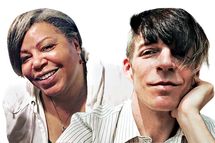
Sheila Anderson looped in Mika Karlsson.
Mika Karlsson: One day, she knocked and said, “I have a yearly party, and you’re invited. By the way, we need a chill-out area — can we use your apartment?”
Sheila Anderson: I’d realized I needed more space. He looked at me like, Huh?
MK: But my experience is that whenever you hesitate, you should probably say yes, so I did. I realized during the party, This is why I’m in New York.
SA: Then we developed a friendship spending time together, having dinners.
MK: She played one of my classical things on her radio show. I remember getting off my bike in Astor Place and thinking, Yeah, this is cool.


Mika Karlsson met Rob Copeland at a meeting.
Mika Karlsson: I started to go to a 12-step group in midtown.
Rob Copeland: I remember sitting at the front of the room when Mika walked in. I guess the right term is vibed. We vibed.
Nobody would see Mika and me and say, “That one and that one go together.”
MK: I don’t need any more composers in my life.


Rob Copeland met Jan Lisa Huttner in a long line.
Jan Lisa Huttner: Hillary was signing What Happened at Union Square, so I made a hotel reservation the night before at the Hyatt nearby.
Rob Copeland: I just happened to step in the line right behind Jan.
JLH: He had no idea we were about to spend the next eight hours together.
RC: Neither one of us is bashful. For the first several hours, we talked politics. Eventually, I got some really great shots of her meeting Mrs. Clinton.
JLH: He moved back in the line so that he could get the photograph. What an amazing gentleman.


Jan Lisa Huttner found a movie buff in Kimi Kumar.
Jan Lisa Huttner: Two years ago, I got my teeth whitened. When I told the receptionist I write about women filmmakers, she said, “You need to meet my friend Kimi.”
Kimi Kumar: We connected at Starbucks. Now she’s my Jewish mother. The night before she went to meet Hillary, I joined her, we went up to the room and were drinking Bailey’s and were talking about our problems, mostly hers.


Kimi Kumar met Alison Evans on the subway.
Alison Evans: I asked her where she was heading, and we started to talk. You can tell if someone is open to train conversation. Some people, if you talk to them, they’ll put their earbud in and it’s like, Bye! We discussed art and balancing that with a day job.
Kimi Kumar: It was very forward, but we were sitting right next to each other.
AE: We were in the middle of a deep conversation when she said she had to get off, so I was like, “Give me your number.” It’s kind of weird when you do that, especially with women because you think, I hope they don’t think I’m hitting on them. A few months later we had drinks. We talked about the meaning of life and spirituality.
KK: I know we have enough small talk in life, and I know it can be annoying, but it’s a way to connect. Small talk leads to big talk.


Alison Evans found in Ryan Davis a fellow art nerd.
Alison Evans: We met at a pop-up gallery in the Lower East Side. I was still so new to New York, I drove in from Queens. We discussed, on an intellectual basis, why be an artist.
Ryan Davis: I hope this doesn’t come off as rude, but I rarely find people who can keep up with me. That conversation was probably the closest I got to an interesting one.


Ryan Davis sells brushes to Gabriel Marchisio.
Ryan Davis: We have three different kinds of customers. One is the older person who says, “I’ve been painting for 50 years, and even though I am requesting your help, I am going to make you feel inferior every step of the way.” Then you get the ones who want you to teach them everything. They will ask things like, “How do you make a painting?” And then you get customers who are easygoing and appreciate your help. Gabriel falls into that category.
Gabriel Marchisio: My work is in the window of Blick right now. I make my art at home in Harlem, but I come there very often.
RD: He’s pretty eccentric, I’ll just say that. He likes to make the kind of jokes that you can only hear half of what he said. In fact, I don’t think I’ve heard a word he’s ever said to me.


Gabriel Marchisio gets mistaken for Ron Jeremy.
Gabriel Marchisio: I had a bit of money from selling some art at first. Then I started reading cards when I couldn’t afford food. I was the tarot-card reader at the Chelsea Hotel. You know what happens to me sometimes? Girls mistake me for Ron Jeremy. I met him at the after-party for the MTV awards. The room was full of stars.


Ron Jeremy starred in a film with Robin Byrd.
Ron Jeremy: Robin Byrd did the strongest scenes. We were in Bon Appétit, a great film. I’m using an awful French accent saying Champagne. We were once having sex in the basement of a club in Queens when a guy fired a gun. We didn’t miss a beat.
Robin Byrd: “I don’t remember that part, maybe it was just the fireworks in his head?”


Robin Byrd got a call on-air from Sandra Bernhard.
Sandra Bernhard: One night in 1988, I was lying in bed watching her live show and decided to call her.
Robin Byrd: I pick up the phone, somebody goes, “Hi, this is Sandra Bernhard, and I would love for you to come and see my show.” I’m like, “Yeah, sure,” and I hung up. But then she calls up again and goes, “No, really, I’m inviting you down, blah, blah, blah, the Orpheum Theater, and pick up your tickets.” So I went down to the Orpheum Theater, and I go, “This may sound a little weird, but I’m Robin Byrd …” “Oh, we know who you are, we love you, blah blah blah!” After the show, I go backstage and meet her.”
SB: She came, and then she asked me to come on her show.
RB: She said, “What am I gonna do?” I said, “What do you mean? You’re gonna strip.”

Sandra Bernhard was seated across from Lady Bunny at a grim charity dinner.
Sandra Bernhard: We were at a PETA event. PETA can get a little intense, you know? Lady Bunny was slurping her soup going, “Mmm, this is the worst soup I have ever tasted. Disgusting!”
Lady Bunny: After we met, I went to see her show. Carol Channing sat in front of me, and that nut, who I worship, had this handful of fluted lipsticks — you know, with a gold mirror that pops up — that bitch took out five of those and sat down and sat there putting them all put on before the show. I was in overload. There I was in the East Village, sitting right behind Carol fucking Channing, watching a comic who was best friends with Madonna — and there was even a sex club on my way home.


Lady Bunny is neighbors with Nicky Perry.
Lady Bunny: She works on my block. She’s crazy, a right old scrubber. She’s always got a rotten joke, and she’s always wearing her HILLARY and VOTE buttons.
Nicky Perry: Bunny has lived there longer than I’ve had the restaurant. That’s a long time.
LB: I recently gave her daughter a little chop of a wig.
NP: Audrey absolutely adores her. When she was about 5, she said, “Mummy, is Lady Bunny gay?” Oh dear, oh dear.
LB: And I was recently in a reality TV pilot Nicky shot. I have no idea where it’s going. The pilot looks cute, for a genre that I don’t care for. I don’t like reality TV, let’s put it that way. But then again, I was in it, so.


Nicky Perry met May Pang at a Jonathan Ross show.
Nicky Perry: He was really big in England, but the Americans have never heard of him. I didn’t have to bring up John Lennon — within a minute, she was talking about him and then I was like, “Oh, okay. That’s nice.”
May Pang: That’s what I like about her; she’s very straightforward.


May Pang met Wendy Kaufman at Tea & Sympathy.
Wendy Kaufman: Snapple was a sponsor of Howard Stern’s show, and I knew of May ’cause she’d gone on the show a zillion times.
May Pang: I knew her as the Snapple lady.
WK: But I must tell you, while I am a true admirer of the Beatles, I was not one of those Beatles hangers-on, and I think that she liked that about me.


Wendy Kaufman met Edis Julevic at Philippe.
Wendy Kaufman: Philippe is one of my staple places, along with my halal guy.
Edis Julevic: Wendy started coming around December 2005, and then she became a regular. She loves a litchi double martini. She even had her birthday here — I’m not sure if it was the 50th or 60th birthday. I will say 50th.


Edis Julevic met Bill Rudin when planning a shiva.
Edis Julevic: The family needed a location for his uncle’s shiva.
Bill Rudin: My uncle loved Chinese food.
EJ: This was the first time we’d had a shiva. This is a Chinese restaurant, so kosher’s just not something we can provide.
BR: Edis was so accommodating.
EJ: We did make a special fish dish.


Bill Rudin met Ray Kelly when Bill’s dad worked with David Dinkins.
Bill Rudin: My father was a founder of the police foundation. Then things come full circle: My daughter married a gentleman very close with Ray, so now Ray is one of my granddaughter’s godparents.
Ray Kelly: We were honored, but, you know, there’s probably a couple other godfathers out there.

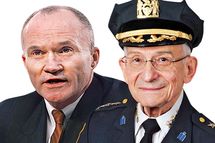
Ray Kelly met Rabbi Kass often, usually in hospitals.
Ray Kelly: There’s a picture of me graduating from the academy, you can see Rabbi Kass in the background. As I went up in the department, I came in contact with him more, usually when something bad happened.
Rabbi Kass: He appointed me chief chaplain. It was quite a surprise.
RK: It’s not easy, herding chaplains.

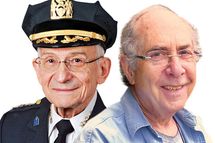
Rabbi Kass argued with Robert Lipsyte about God.
Rabbi Kass: He wrote a very irreligious article about surviving cancer in TV Guide. I wrote him a letter saying that he should treat Jewish chaplains better.
Robert Lipsyte: It was such a nice, warm, inviting letter that I responded and we began a long discussion.
RK: And we’ve been good friends ever since.
RL: I’m still an atheist.

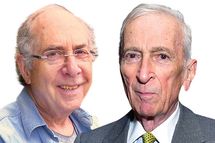
Robert Lipsyte fetched cocoa for Gay Talese.
Robert Lipsyte: I hated my job as a copy boy in the sports department at the Times. The only thing that interested me was this flashy young reporter named Gay Talese.
Gay Talese: I was getting a lot of bylines and a lot of attention.
RL: He was stuck on night rewrite, and part of my job was I would go out and buy him cocoa — not hot chocolate, cocoa.
GT: There’s always a young person that reminds you of yourself and you like that person because you like that memory.
RL: The hours were 7 p.m. to 3 a.m., and you can imagine the loser assholes who worked on that shift. What the copy editors lived for was to take a beautiful piece from Gay Talese and cut it down to three paragraphs. I told him I was going to quit. He said, “You could make it here big time. But if you do quit, I’ll give you $5,000, for 10 percent of five years of your freelance earnings.” And that was all I needed to hear: Gay Talese thinks I can make it here.

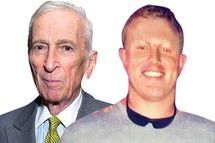
Gay Talese met Joe Spratt’s grandfather at the top of a bridge.
Gay Talese: I met Joe Spratt’s grandfather in 1963. I was up on the Verrazano bridge, writing about it being built.
Joe Spratt: A few years ago, I get a call one day, it was Gay looking for my father. He sounded a little disappointed, and then he asked, “Well, what do you do for a living?” I said, “I’m an ironworker, too, working on the Freedom Tower.” That blew his mind.
GT: We became friends; I met his girlfriend. We had dinner a few times, and about two weeks ago he sent me a card with a picture of him on top of some building.
JS: He reminds me of my grandfather — both very tall and skinny, and they both cross their legs in the same way. Maybe that’s why they bonded? I was like, “Gay, what’s the deal? Why are you even interested in ironworkers?” And he said, “I like to write stories about people who do things with their hands.”


Joe Spratt works high above Anne Umland.
Joe Spratt: I’m doing some crazy shit with a crane right now. We’re at MoMA — I put a bit of iron on top of the museum.
Anne Umland: Every week, the construction crew is responsible for adding another floor. So each week I come in and I look up, and now I am at the point where I can’t look up anymore.


Anne Umland gave Tina Davis a photograph.
Anne Umland: My husband’s gallerist was the one who introduced me to Tina as a book designer. And then it turns out she’s married to James Snyder, who I know from MoMA, but she doesn’t have his last name, so I hadn’t put that together.
Tina Davis: I saw Anne at an art opening about six months ago, but we didn’t speak.

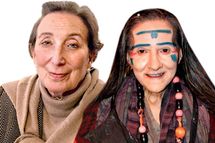
Tina Davis shopped at Luxor Tavella’s shop.
Tina Davis: Her store in Soho was a certain kind of vintage — old pieces of Indian saris, not Katharine Hepburn. Even back then, she seemed a little unusual.
Luxor Tavella: Everybody came in here, from Andy Warhol to Rene Russo to Karl Lagerfeld. Beautiful people still come, but it’s harder to know who they are. Jeff Bridges and his wife are regulars; he buys two of everything for himself. Each year, people buy my clothes for Burning Man.
TD: I don’t think I argued with her or tried to bargain her down, but she did tell me a ridiculous price.
LT: I’m still here, every day, from 1 p.m. onward.

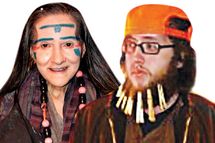
Luxor Tavella buys crackers from Troy Turnwald.
Luxor Tavella: I have been going to Gourmet Garage for years. It’s so close; I can get there and back in a minute.
Troy Turnwald: Couldn’t miss her from a mile away. I haven’t really had that many conversations with her; I just know that she usually comes around 8:50 at night and buys Carr’s entertainment crackers.

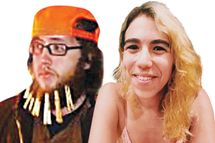
Troy Turnwald was asked for old bagels by Hila Perry.
Hila Perry: I was making a movie about an artist who’s name is Art who is fed up with his work but still makes a lot of money but rejects it and goes on a quest to make art that’s meaningful to him and all this chaos ensues, and I wanted to know if Gourmet Garage had any food garbage that I could feed to my crew. My friend told Troy that I like giving erotic foot massages. I played along; I was like, “Yeah, I give erotic foot massages, I’m like really into toes.”
Troy Turnwald: She always has these shticks.
HP: He gave us bagels, and eventually we started hanging out.
TT: She just moved to Brooklyn and is living the no-waste lifestyle. It sounds very exhausting.
HP: I moved to a circus-training studio on the edge of Bushwick and Ridgewood. The first week, they were hosting a teenage-girl summer camp for aerial training. The girls were kind of awkward and shy and from, like, Massachusetts.


Hila Perry is always late for Rosemary M.
Hila Perry: It’s a long-ass bike ride to my allergist in the Upper West Side — it’s this whole thing that I prep myself for. I tell her secretary Rosemary I’m going to be there at 8:30, and she’s like, “Yeah, okay, sure you are.” And then I don’t show up till, like, two. She’s so funny. She’s just like, “Oh, we’re so happy you made it!”
Rosemary M: She’s a trip. She always gives me these fabric hearts with a pin. She wants you to wear them. To be honest, I don’t exactly know what she does for a living.


Rosemary M. buys puppies from Jimmy Earle.
Rosemary M: I see Jimmy every week. I go there to buy everything. My house looks like Jimmy’s store.
Jimmy Earle: Rosemary bought a dog and then, after a couple of years, it passed away. She was in one day looking at a puppy. I said, “You love dogs, you need one, just take the puppy, we’ll worry about the money later.”


Jimmy Earle watched Cassie Stranzl grow up.
Cassie Stranzl: When I was a kid, I would always go to Jimmy’s pet shop. I was going to ask him if I could have a part-time job, but I was too shy.
Jimmy Earle: Now she works around the corner at the animal clinic.
CS: I didn’t buy my pets from him, though. I like reptiles, and they are much cheaper at special expos.


Cassie Stranzl works at a Bronx animal hospital with Delilah Mogollon.
Delilah Mogollon: I wasn’t born when I met Cassie.
Cassie Stranzl: I remember Delilah’s grandmother bringing in sonograms to the vet’s office. I guess I’m her role model. She works the waiting room; she’s like, “Hey, I’m Delilah, what brings you here?”
DM: Look, the truth is that when I am at home, I’m rotten, and it’s only when I’m here that I’m sweet because I love animals. We have some rescue kittens at the moment. Each day, I watch to see if they have opened their eyes all the way.
